200+ Echeveria Types With Pictures (Echeveria Identification Chart)
If you’re unsure about the kind of succulent you own, this article can guide you in identifying more than 200 types of Echeveria plants, including both the ones commonly seen and the rarer ones.
Echeveria Identification Chart
Contents
Echeveria Types
Echeveria is a large genus of tropical flowering succulent plants that is native to the mountainous ranges of Central and South America. Echeverias are one of the most popular succulents and are frequently featured in succulent gardens, floral arrangements, terrariums, artwork, and even wedding cakes.
They are also one of the most prolific types of succulents and can bloom several times a year under the right growing conditions—displaying stunning orange, yellow, and red flowers.
Echeveria varieties generally have thick green fleshy leaves. They are easy to care for, look beautiful, and don’t need a lot of water. One of the reasons echeverias are common succulents is that they come in a wide range of colors, shapes, and textures. Their stunning rosette shape, plump leaves, and a large variety of colors give them a striking resemblance to flowers which makes them easy to decorate with.
Related Post:
1,000 Types of Succulents With Pictures.
Echeveria ‘Abalone’
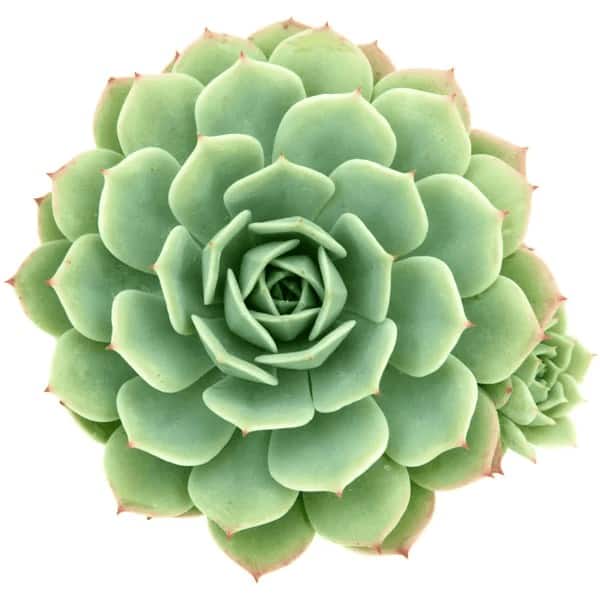
Echeveria ‘Abalone’ is a gorgeous succulent plant with light green leaves that form a perfect rosette. It is coated with a powdery layer of natural wax that protects it in full sun and gives the plant a frosty appearance.
Echeveria affinis
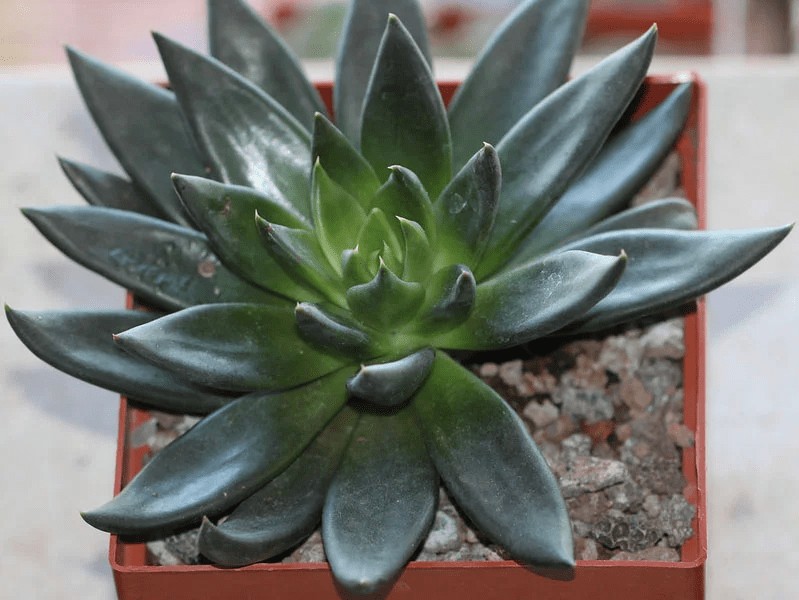
Echeveria affinis is a low-growing perennial succulent that forms rosettes up to 6 inches (15 cm) tall and about the same in diameter. It has distinctively upright, pointed leaves of dark green to black. Both its leaves and stem are quite stout. It is not a prolific offsetter, but it can hold brilliant red flowers from fall through winter.
Echeveria affinis ‘Black Knight’
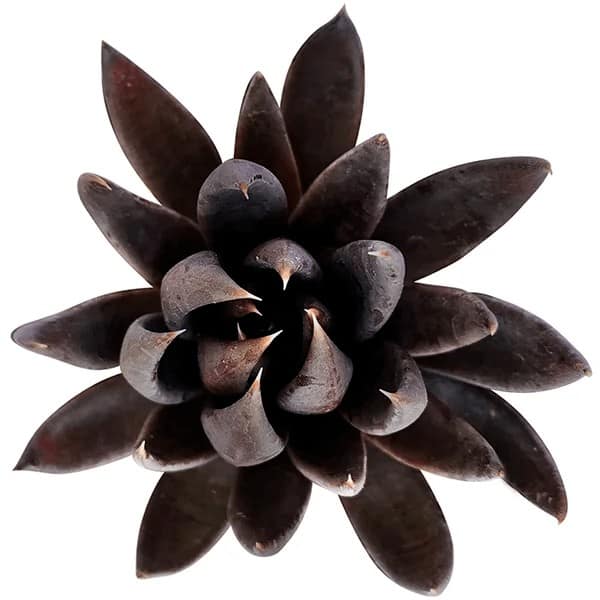
Echeveria affinis ‘Black Knight’ is not a hybrid with Echeveria affinis as one parent, but it is the species E. affinis itself, distributed as a clone somewhat different from the type species. It differs from the type species in its blacker, slightly differently shaped leaves and can grow to about 5.0″ wide.
It has distinctively upright, pointed leaves of dark green to black. Both its leaves and stem are quite stout. It is not a prolific offsetter, but it can hold brilliant red flowers from fall through winter.
Echeveria ‘Afterglow’
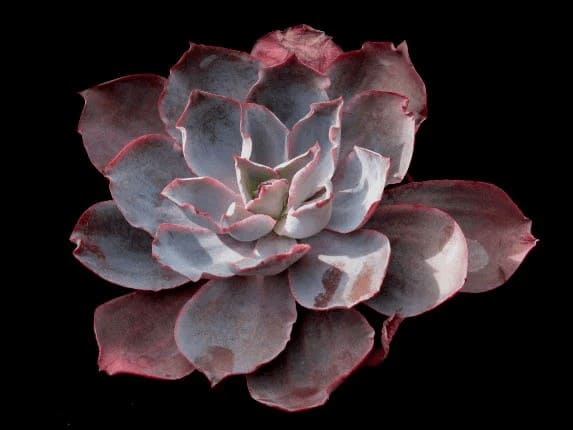
Echeveria ‘Afterglow’ is a stunning succulent with wide, powdery pinkish-lavender leaves that have a brighter pink edging and are aptly described as an “out-of-this-world” color. It grows on a short, stout stem that holds rosettes up to 16 inches (40 cm) in diameter.
It does not produce as many offsets as other varieties but it responds well to propagation from stem cuttings. Echeveria ‘Afterglow’ is a hybrid of Echeveria shaviana and Echeveria subrigida.
Echeveria agavoides
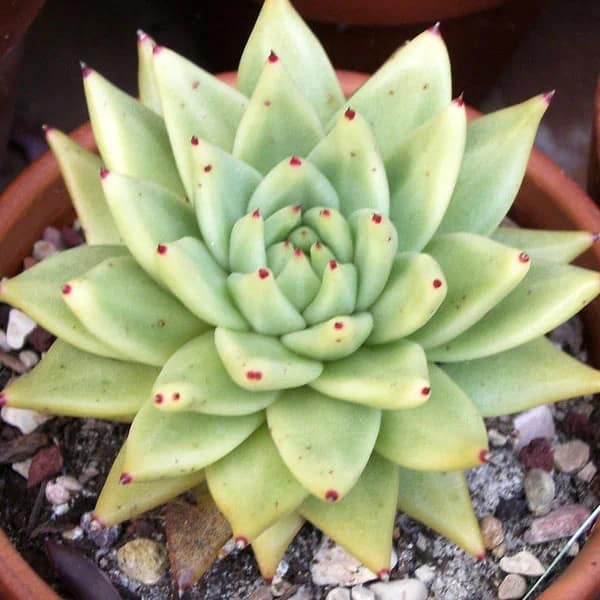
Echeveria agavoides is a stemless succulent, up to 5 inches (12.5 cm) tall, with dense, usually solitary rosettes of fat, triangular leaves with a terminal spine. The rosettes grow up to 8 inches (20 cm) in diameter. Leaves are apple green with edges that can turn reddish in bright sunlight.
Echeveria agavoides ‘Lipstick’
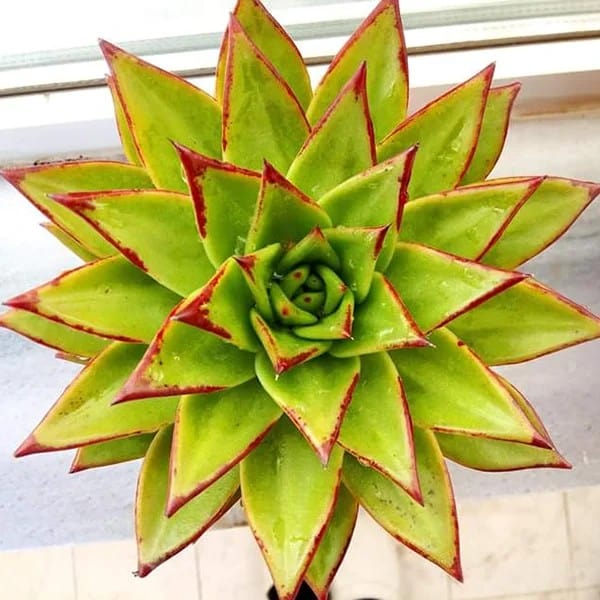
Echeveria agavoides ‘Lipstick’ is an attractive succulent that usually has a solitary rosette even when old. The leaves are up to 3.2 inches (8 cm) long and up to 1.2 inches (3 cm) wide, apple-green with vivid red-pink edges and a terminal spine.
The inflorescences in summer appear on slender, single-sided cymes up to 20 inches (50 cm) long. The flowers are pinkish-red with petals tipped with dark yellow. The decisive feature of this cultivar is not primarily the red leaf margin near the apex, but the 4- to 5-branched inflorescence.
Echeveria agavoides ‘Red Tips’
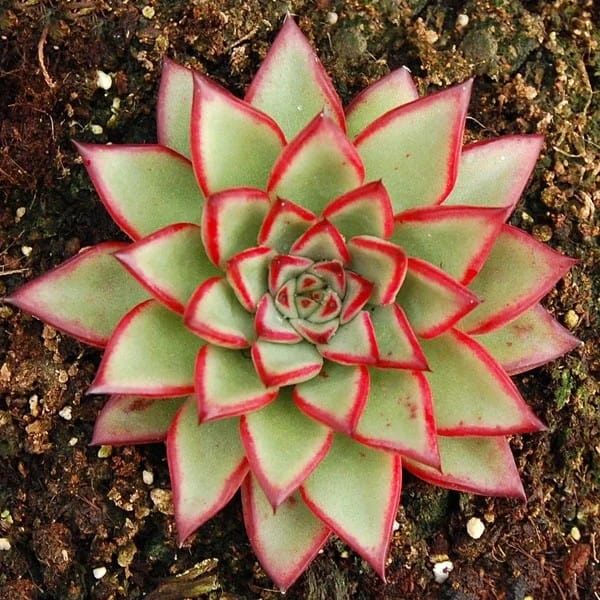
Echeveria agavoides ‘Red Tip’ is a gorgeous cultivar of a much-loved species that has distinctively pointed leaves and bright red accents. This particular variety gets pink to red leaf tips and can grow up to 1.0′ wide. In summer it produces a tall bloom stalk from which dangle yellow, bell-shaped flowers.
Echeveria ‘Alba Beauty’
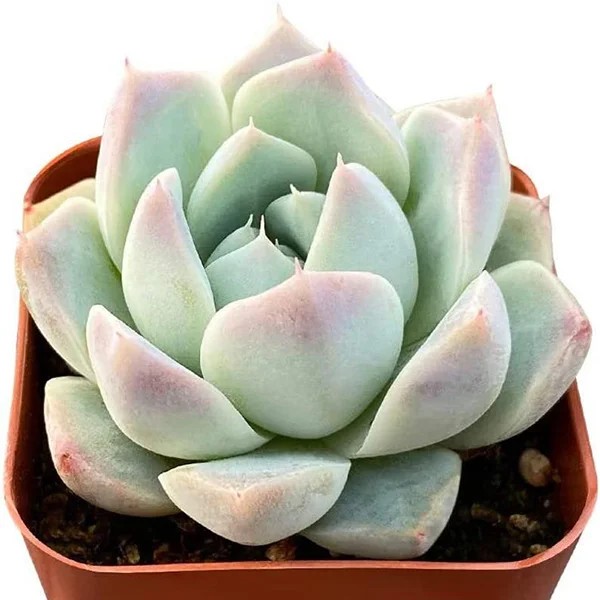
Echeveria ‘Alba Beauty’ features pointy fleshy leaves with a lovely vibrant orange to pink color on the tips. Beautiful pinks and porcelain blues, with dappled mature leaves.
Echeveria albicans
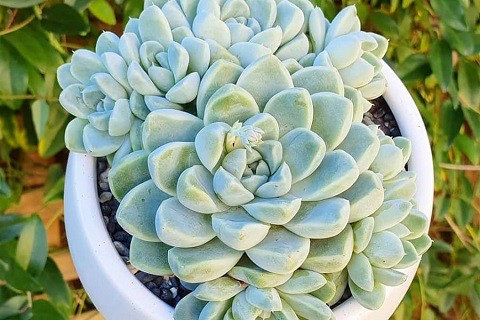
Echeveria albicans is a succulent that is commonly known as Whitening Echeveria and one of the varieties of Echeveria elegans. In botany, its accepted name is Echeveria elegans, although it is still commonly known as Echeveria albicans.
Echeveria Allegra
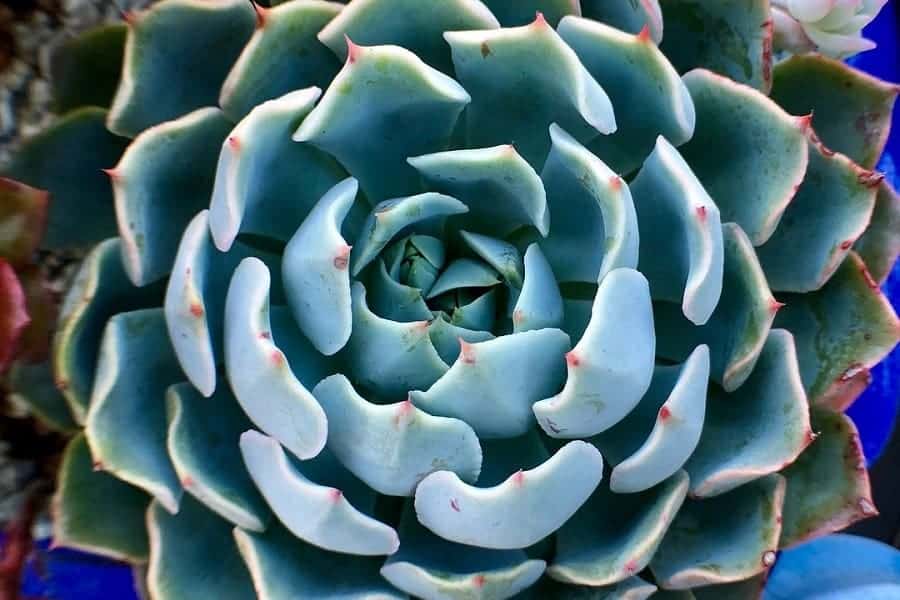
Echeveria Allegra is a brightly colored hybrid with light and translucent hyaline leaf edges.
Echeveria amoena
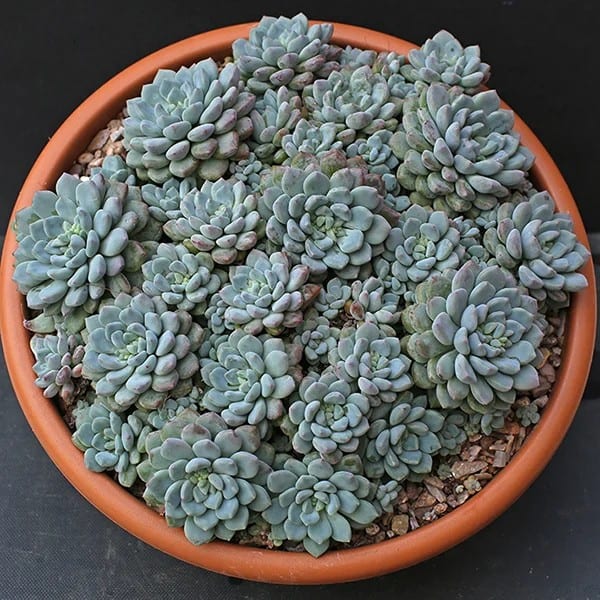
Echeveria amoena is a small succulent with numerous short offsets. Leaves are glaucous green, often red-tipped and arranged in dense rosettes up to 2 inches (5 cm) in diameter. In late spring they bust out with coral-red blooms on red stems for a show that lasts at least a month.
Echeveria ‘Atlantis’
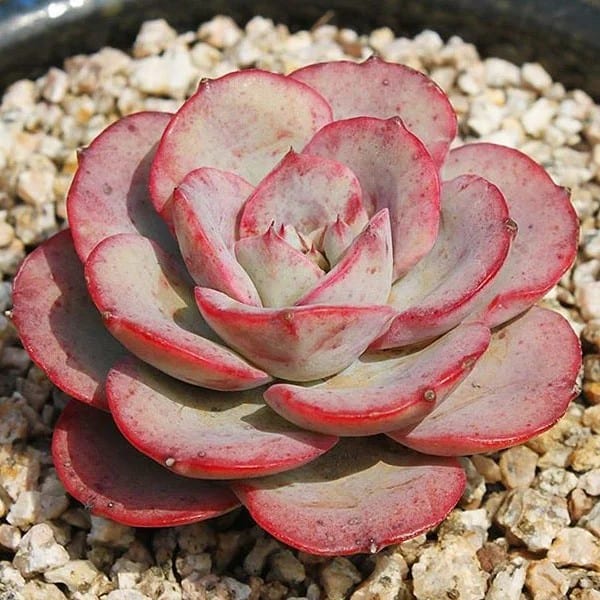
Echeveria ‘Atlantis’ is an attractive succulent with round big rosettes. The name is very sweet and cute, and it belongs to the Korean breed type.
In the summer expect the rosettes to take on a powdery blue skin, but in colder temperatures, this plant reaches its full potential with rich, red tips that are in striking contrast to the bluish-green bodies of the rosettes.
Echeveria atropurpurea
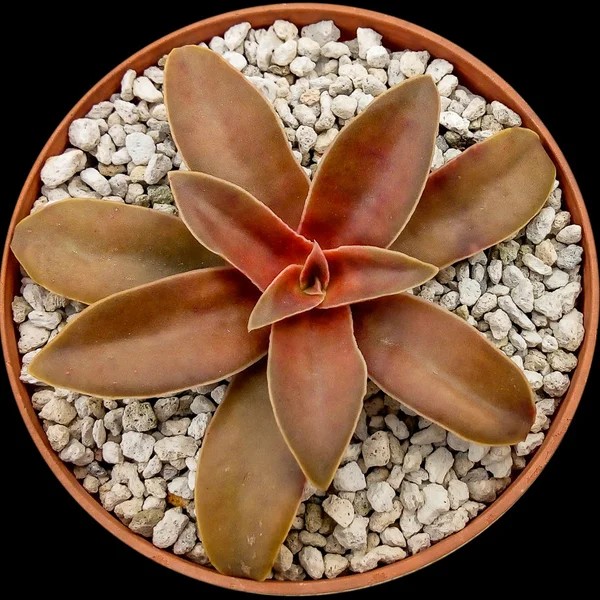
Echeveria atropurpurea is a well-marked, showy succulent, with short, stout stems and reddish-brown leaves covered with a glaucous bloom.
Echeveria ‘Azulita’
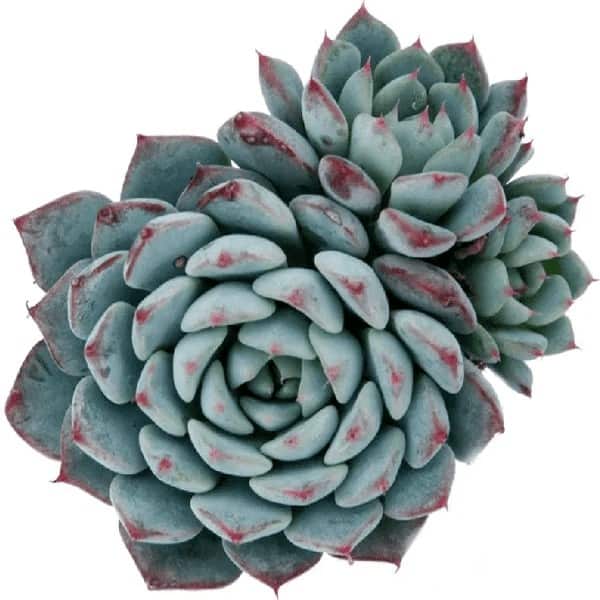
Echeveria ‘Azulita’ is a prolific cultivar with lovely powder blue leaves. This rosette can blush pink to red at its tips when grown in bright light. It also produces lots of offsets that can be removed and transplanted or left to develop into a tidy colony.
Echeveria ballsii
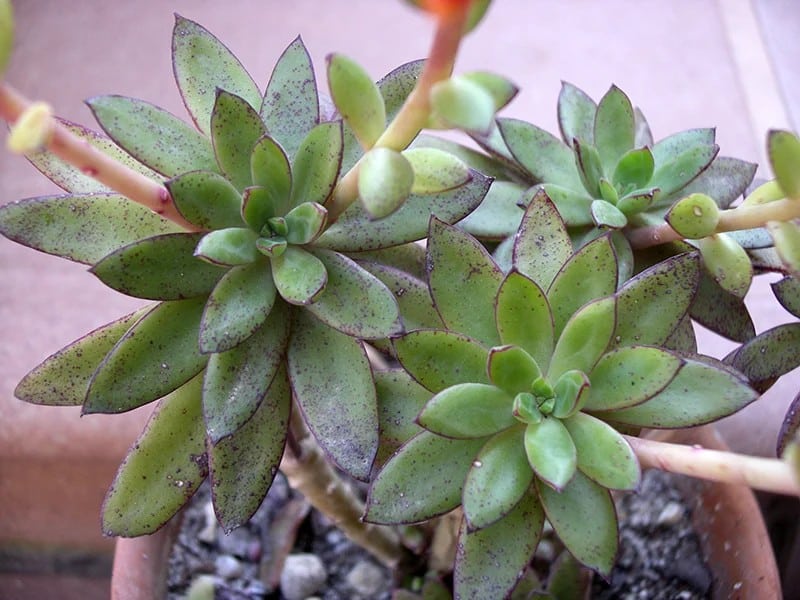
Echeveria ballsii is a miniature growing species that produces many little pups as it grows, it has lovely bright green leaves with red margins in good light.
Echeveria ‘Baron Bold’
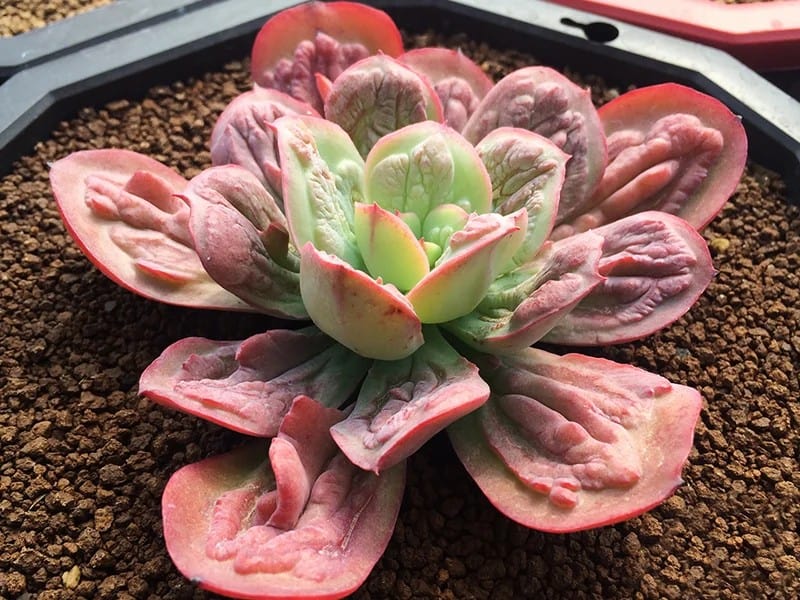
Echeveria ‘Baron Bold’ is an attractive fairly large succulent with big, bumpy leaves that are red and green in color and have interesting jagged edges.
Echeveria bifida
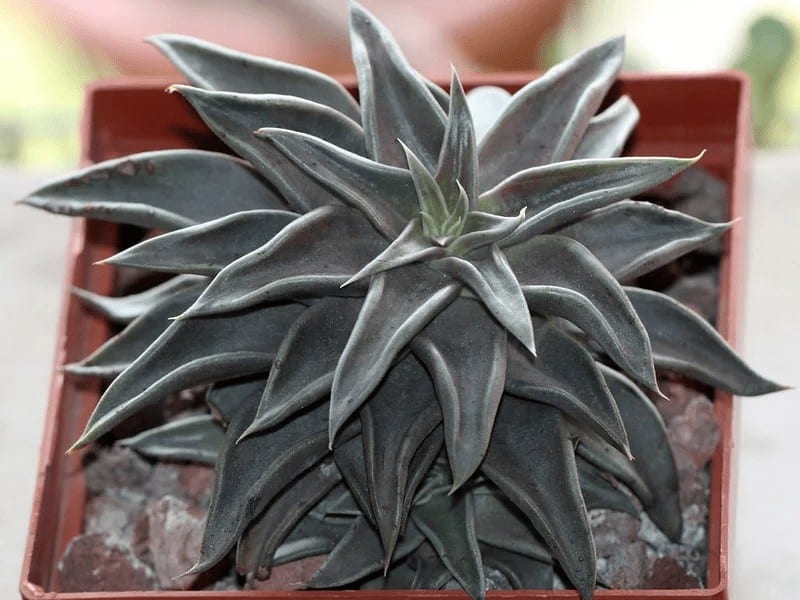
Echeveria bifida is a beautiful pale greyish-brown succulent plant with rosettes of fleshy leaves shaped like a well-filled spindle, slender flower stalks carry nodding bell-shaped flowers. This species is quite variable and perhaps the most difficult to characterize among the Echeveria varieties.
Echeveria bifurcata
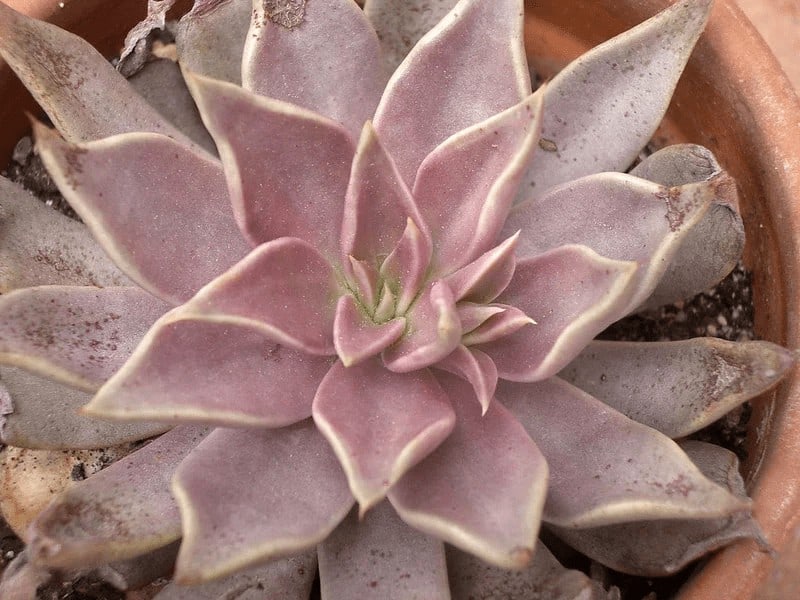
Echeveria bifurcata has grey green leaves. Its cone-shaped pale pink flower is red near the tip.
Echeveria ‘Big Blue’
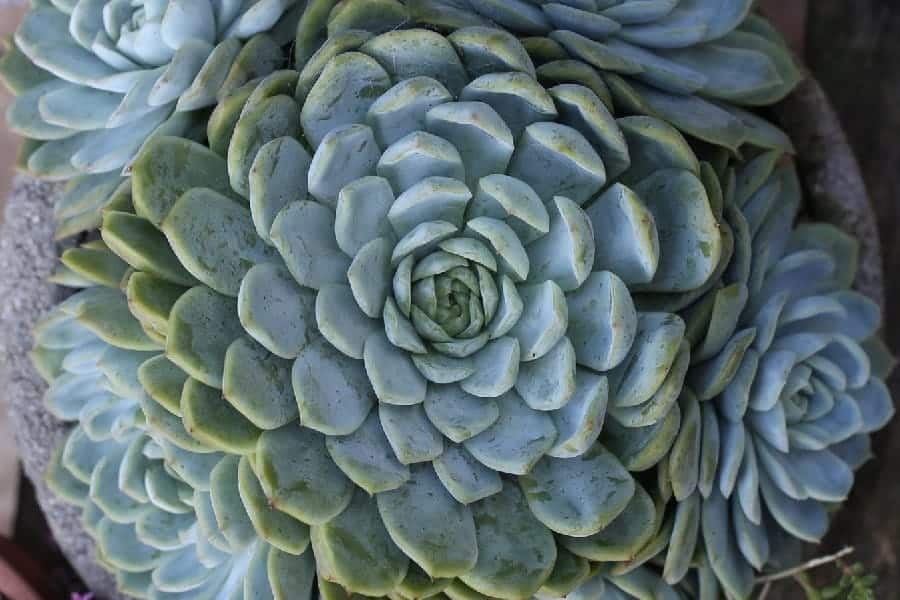
Echeveria Big Blue is a low-growing succulent with origins in Mexico, as well as Central America, the United States, and South America to some extent. Flowers develop on short stalks that protrude from the thick rosette and heavy leaves of this succulent.
Echeveria ‘Black Prince’
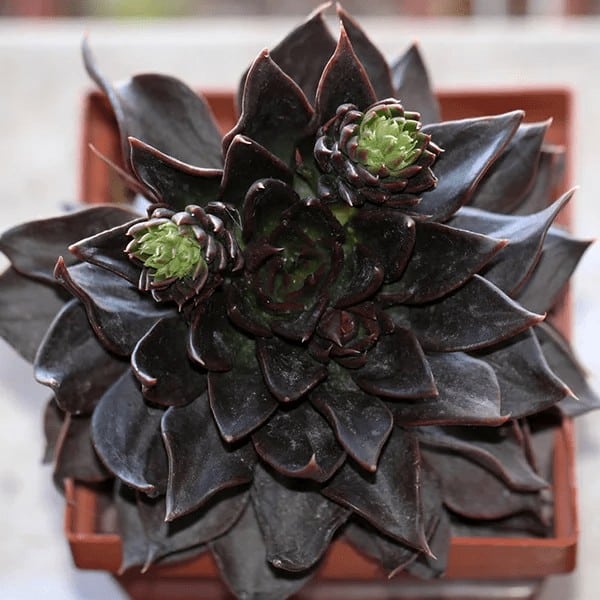
Echeveria ‘Black Prince’ is a slow-growing hens-and-chicks succulent that forms rosettes up to 3 inches (7.5 cm) wide. Its triangular thin leaves darken from green to brownish-purple as the plant ages while the center of the rosettes remains green. It is a hybrid of Echeveria affinis and Echeveria shaviana.
Echeveria ‘Blue Atoll’
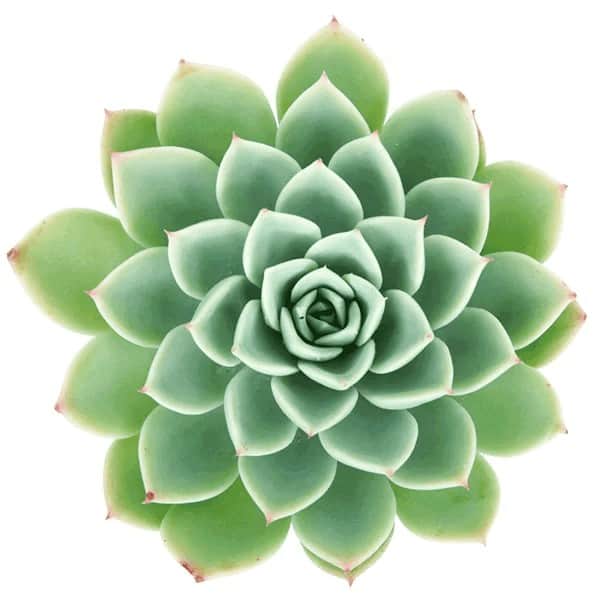
Echeveria ‘Blue Atoll’, also known as Echeveria ‘Coolvue’, is a fast-growing succulent, up to 6 inches (15 cm) tall, forming very pretty rosettes packed with fleshy, blue-green leaves with a soft look from its powdery coating of farina.
The rosette grows up to 10 inches (25 cm) in diameter and offsets freely. In spring, it sends up 8 inches (20 cm) tall stems which bear small, bell-shaped, orange and yellow flowers. This Echeveria offsets readily and is a great choice for rock gardens, green roofs or containers.
Echeveria ‘Blue Bird’
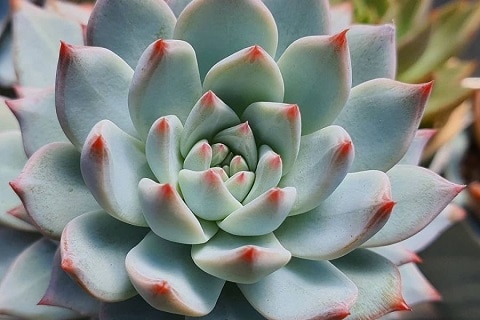
Echeveria Bluebird has rosettes that are dense and grow upright, with edges that are a bit pointed. When it matures, it can reportedly reach a diameter of around 10 inches in diameter.
Echeveria ‘Blue Fairy’
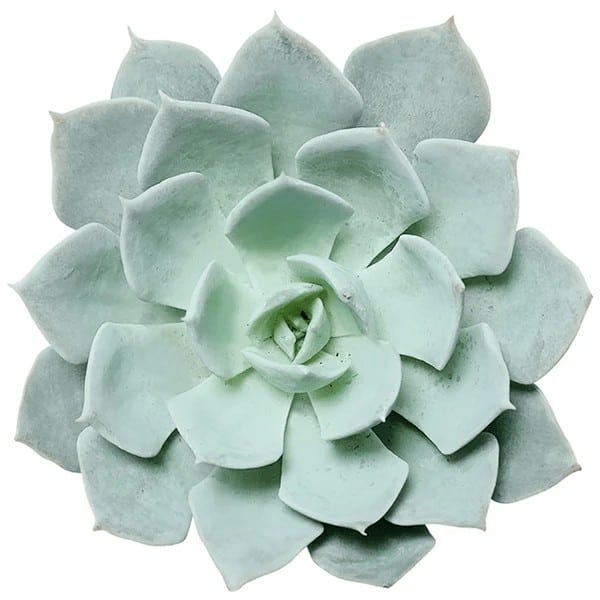
Echeveria ‘Blue Fairy’ is a compact rosette with small, gray-green leaves that grow upwards in a lotus shape. This rosette is an unbeatably soft, pastel blue tone. It has somewhat spade-shaped leaves and the whole rosette is covered with a powdery coating of epicuticular wax.
Echeveria ‘Blue Frills’
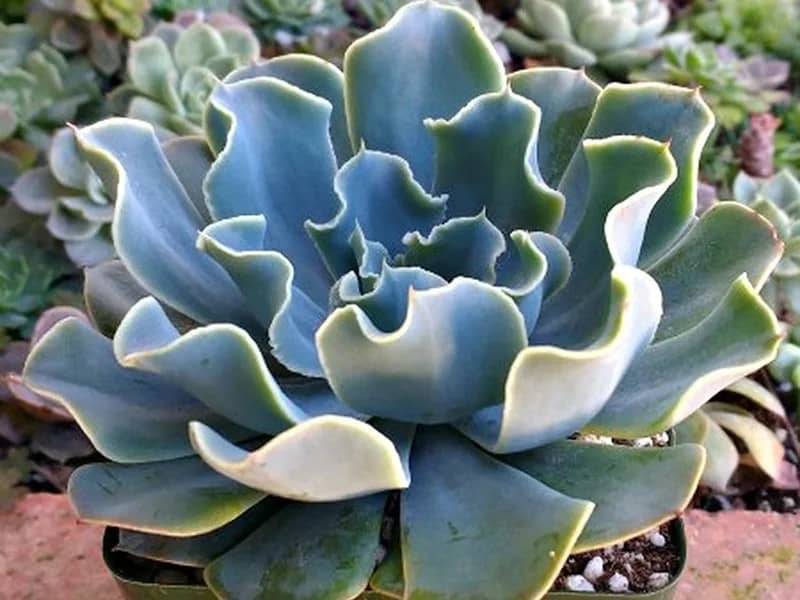
Echeveria ‘Blue Frills’ is a particularly lovely cultivar, bearing compact rosettes of symmetrical, frilled, blue-green leaves. It is a new Echeveria hybrid produced from Echeveria x imbricata and forms rosettes up to 12 inches (30 cm) in diameter of deep peacock-blue leaves with crinkly margins.
The flowers are bell-shaped and yellow-orange in color.
Echeveria ‘Blue Heron’
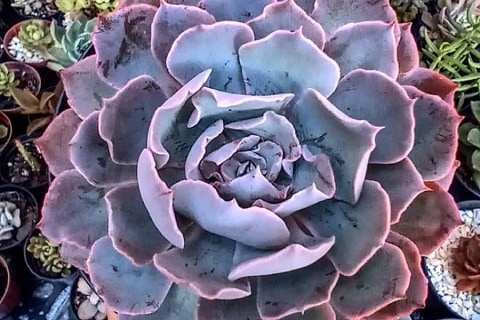
Echeveria Blue Heron is a succulent that is a hybrid. It is a wonderfully wavy plant with iceberg blue leaves that have a tinge of pinkish shine. The flowers are borne on flower stalks that are long and tall.
Echeveria ‘Blue Prince’
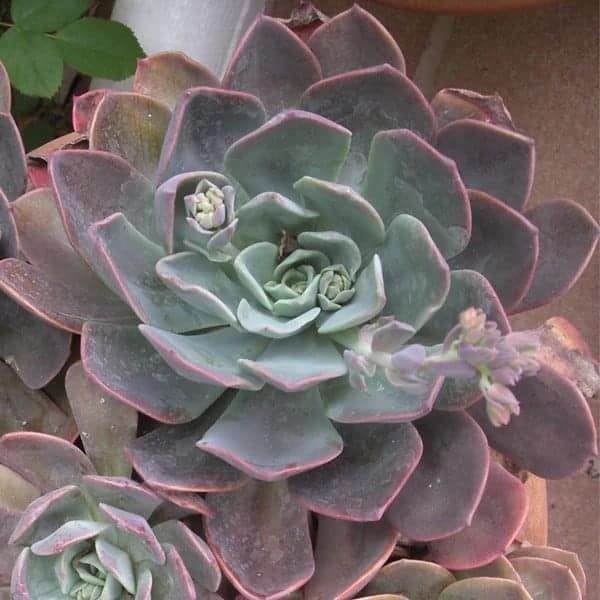
Echeveria ‘Blue Prince’ is an attractive, rosette-forming succulent with dark, blue-green leaves that get bronze in full sun. Contrasting reddish-orange flowers appear on tall stems from late spring.
Echeveria ‘Blue Sky’
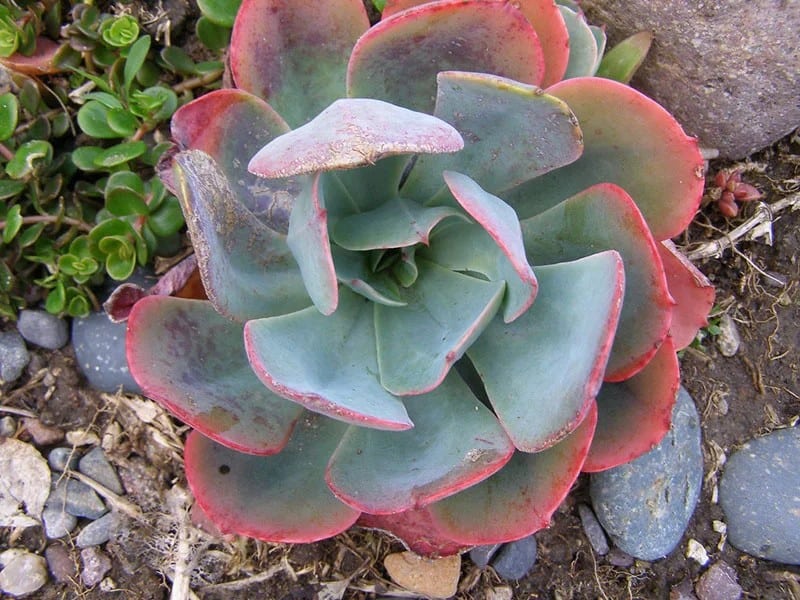
Echeveria ‘Blue Sky’ is a blue and pink rosette with a form similar to that of Echeveria imbricata, namely wide, spoon-shaped leaves. It is also a large grower, eventually reaching 12.0″ in diameter. It has a thick, powdery coating of farina that protects it from the full sun. The leaf tips will flush more deeply pink when grown in bright sunlight.
Echeveria ‘Blue Surprise’
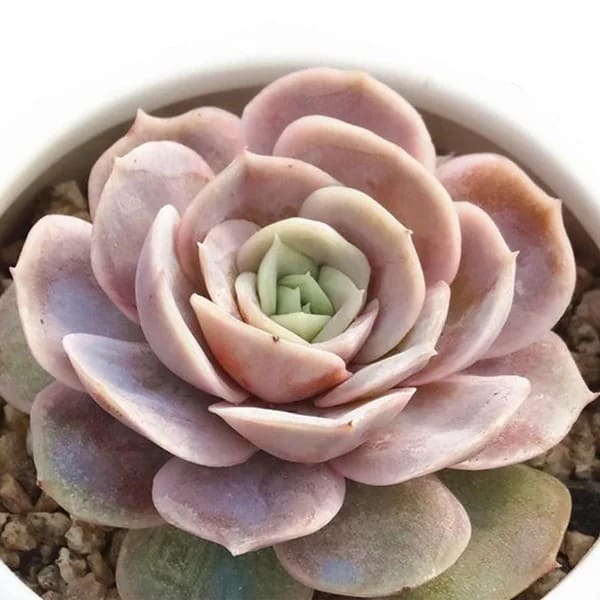
Echeveria ‘Blue Surprise’ got its name due to its fleshy blue leaves. Under stress, they will turn into a solid pink color.
Echeveria ‘Blue Swan’
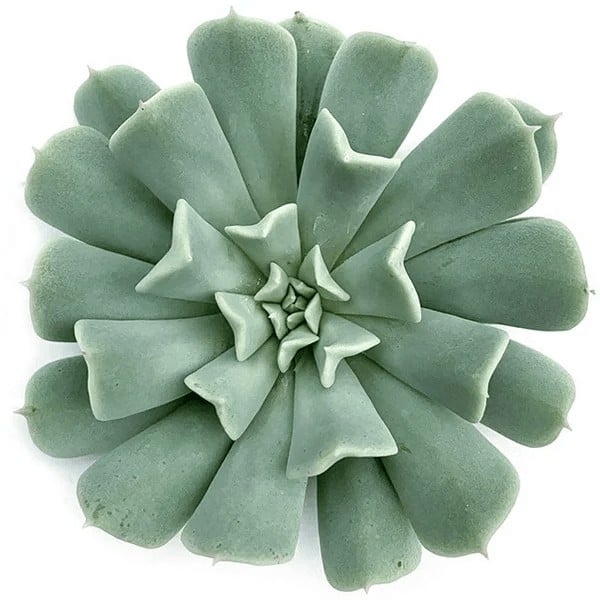
Echeveria ‘Blue Swan’ produces light blue-green leaves that form perfect rosettes. The succulents have tapered ends which adds to their beauty.
Echeveria ‘Blue Waves’
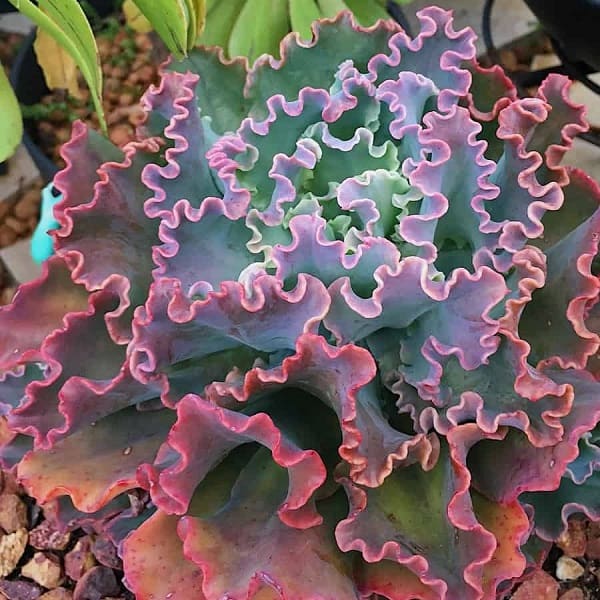
Echeveria Blue Waves is a hybrid succulent. Long stems, dense rosettes, and predominantly frilly edges characterize this succulent.
Echeveria calderoniae
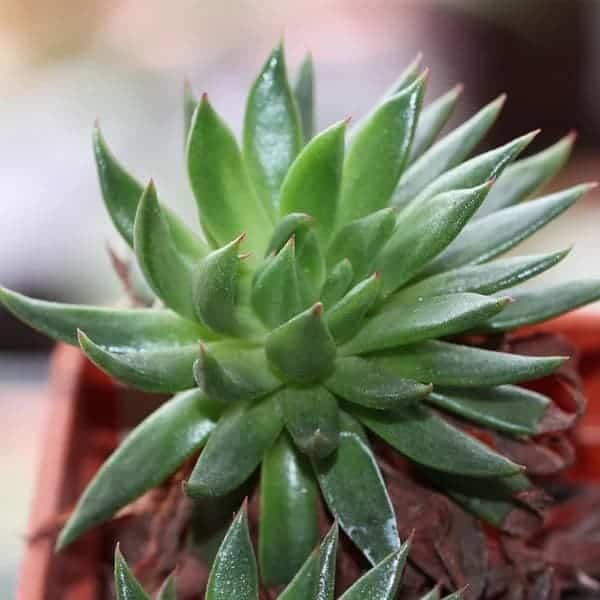
Echeveria calderoniae is a rosette-forming succulent up to 5 inches (12.5 cm) in diameter. The leaves are narrow, up to 2.4 inches (6 cm) long, up to 0.4 inches (1 cm) wide, green with a reddish apex, or whole leaves can blush reddish with age.
The orange, yellow-tipped flowers make a cheery display above the green foliage and are normally borne in a cincinnus, the curved inflorescence characteristic of many Echeverias.
Echeveria californica Queen
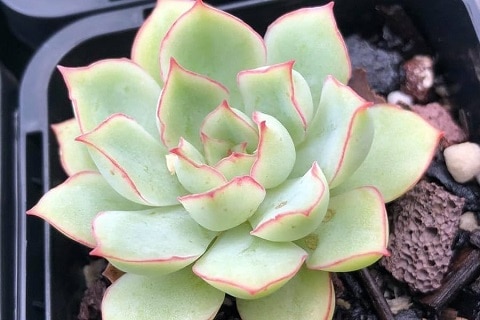
Echeveria californica Queen is a succulent that has leaves that are ovate in shape. These succulents belong to the Crassulaceae family of plants. The rosette grows dense, and the branches thicken and cluster near each other.
Echeveria calycosa
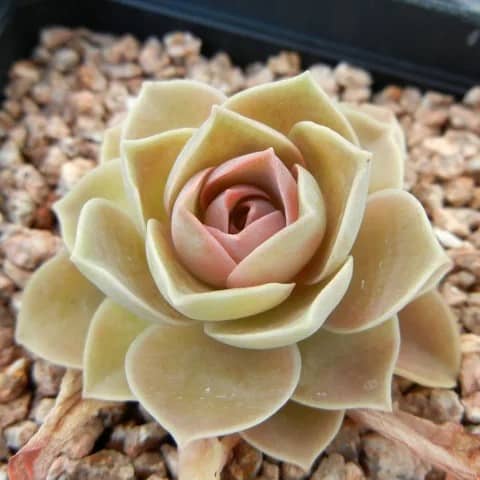
Echeveria calycosa is a succulent that is light green in color when young and turns pinkish as it matures. Echeveria calycosa is a very rare species of Echeveria.
Echeveria cante
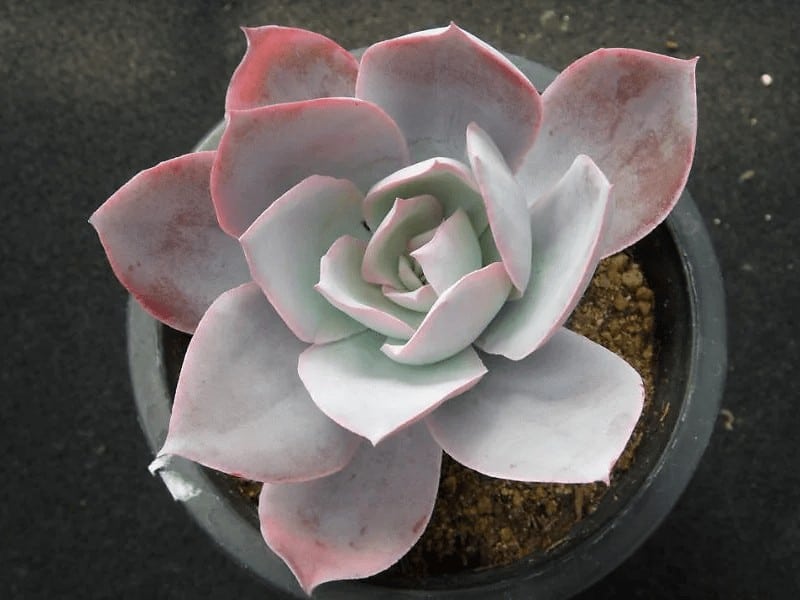
Echeveria cante is a very beautiful species related to the Echeveria subrigida. It differs from Echeveria subrigida in its greater number of farinose rather than glaucous to pruinose leaves, which are narrower and thicker as well as generally longer than those of Echeveria subrigida and the flowers are distinctly different.
The rosettes are very large solitary, but occasionally make a few offsets, stemless, and can grow to be quite large as about 30-40 cm in diameter. In the late summer, it blooms orange-pink flowers.
Echeveria carminea
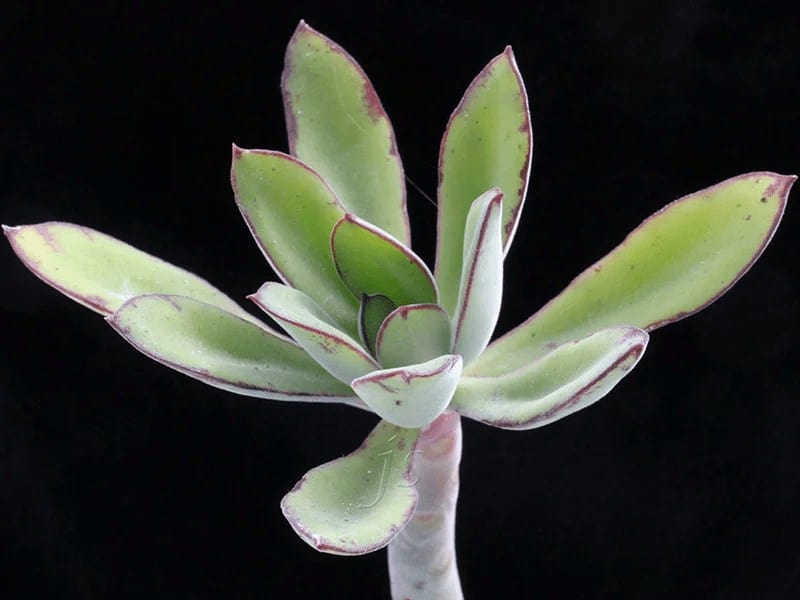
Echeveria carminea grows up to 20cm in diameter and forms orange flowers on tall stems (up to 30cm).
Echeveria carnicolor
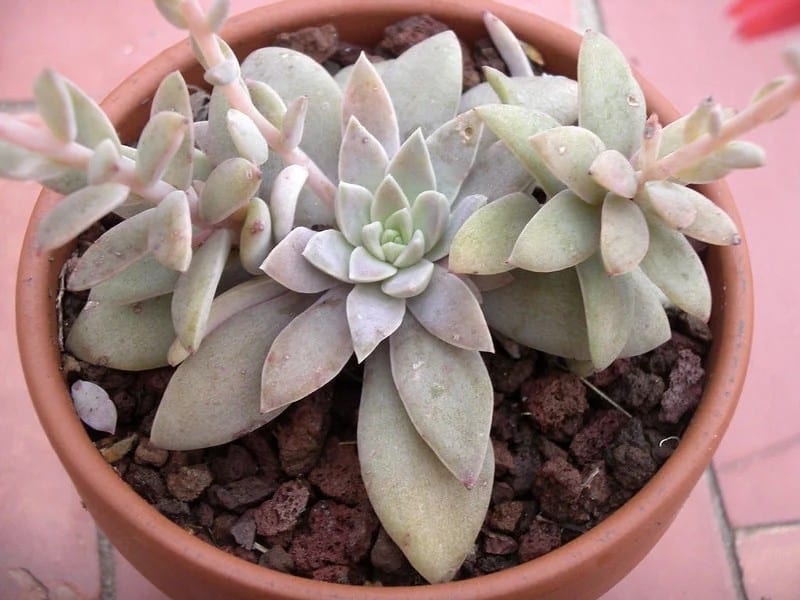
Echeveria carnicolor is a beautiful succulent up to 2.4 inches (6 cm) tall, with short stems and very flat rosettes up to 5 inches (12.5 cm) in diameter. The fleshy leaves are elongated or elliptical, gray-green with whitish margins and reddish coloration in high light conditions, up to 4 inches (10 cm) long and up to 1.2 inches (3 cm) wide.
The flowers are orange-red and arranged in racemose inflorescence.
Echeveria ‘Cassyz Winter’
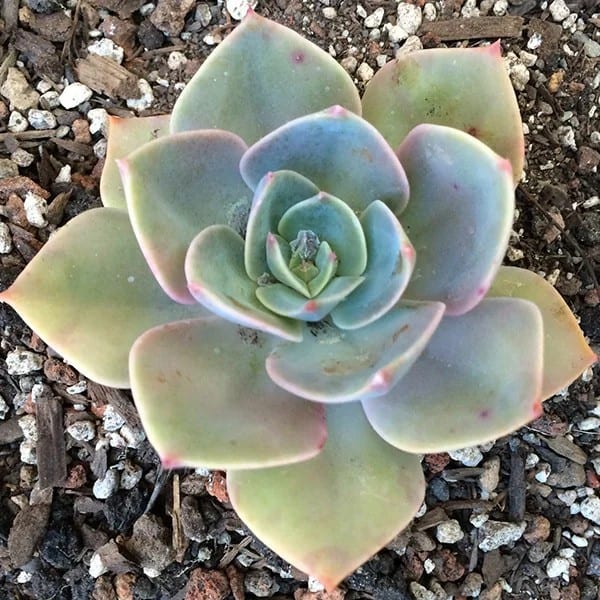
Echeveria ‘Cassyz Winter’ is a beautiful, flushed, pink, rosette succulent up to 8 inches (20 cm) tall, with a silvery-green, heart indicating new growth is on its way! The rosettes are up to 8 inches (20 cm) in diameter. This plant’s coloring makes it the perfect addition to any container or garden.
Echeveria chiclensis
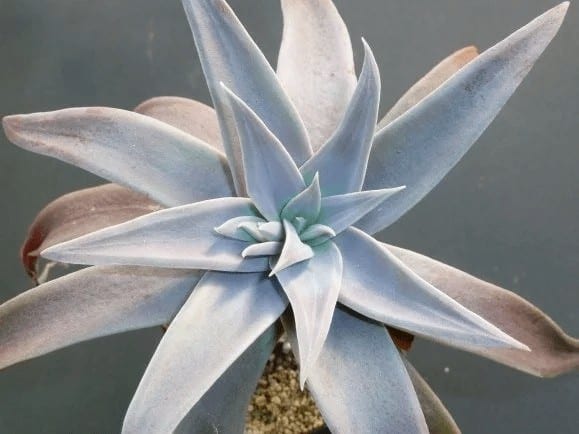
Echeveria chiclensis is a medium-sized Echeveria with a short stem, branched in age, up to 6 inches (15 cm) tall. The leaves are narrow, elongate, with upper surface concave, green to gray-green, up to 6 inches (15 cm) long and up to 1 inch (2.5 cm) wide.
The inflorescence is erect, few branched, and up to 12 inches (30 cm) long. The flowers are orange-red with a yellow tip and up to 8 inches (20 cm) long.
Echeveria chihuahuaensis
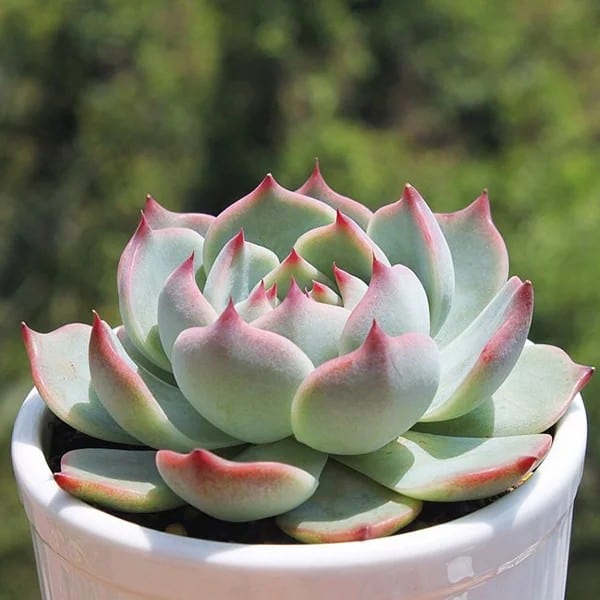
Echeveria chihuahuaensis is a glaucous succulent in the stonecrop family, Crassulaceae. Leaves are blue-grey in color with pink edging, they form a rosette of roughly 10cm in diameter. Long stems appear in the spring, bearing coral pink flowers with yellow insides.
Echeveria chilonensis
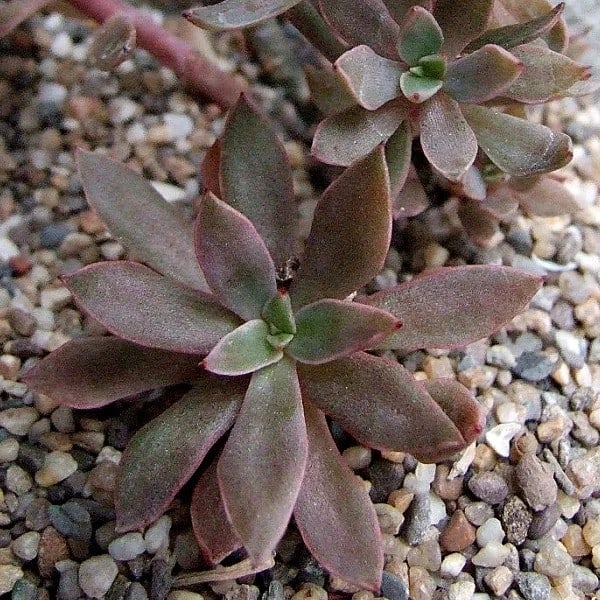
Echeveria chilonensis has leaves that are densely alternate, very often sessile, oblong, acute, absolutely entire, glabrous, flat, thick, 2.5 cm long and 1 cm wide. With leaves only 2.5 cm long and a peduncle of only 10 cm in length, Echeveria chilonensis is a rather small plant. The flowers are yellow.
Echeveria ‘Chris’
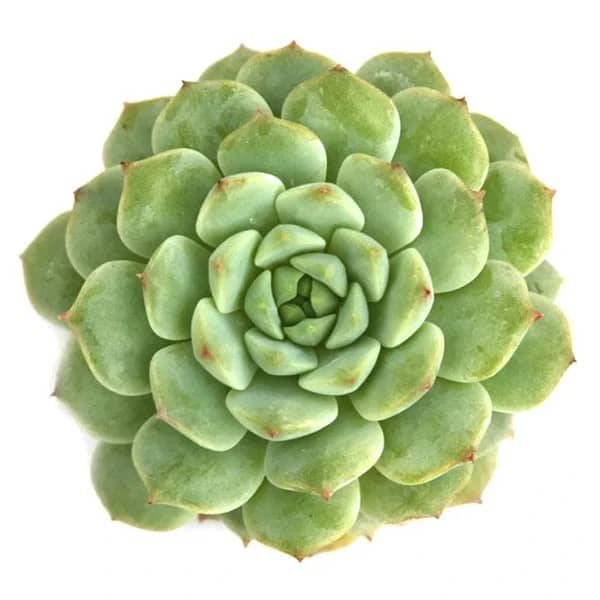
Echeveria ‘Chris’ is an adorably green charmer loaded with chunky lime-green leaves that all fit into a compact rosette. The leaf tips are pinkish-red, giving it a subtle pop of color.
Echeveria ‘Christmas’
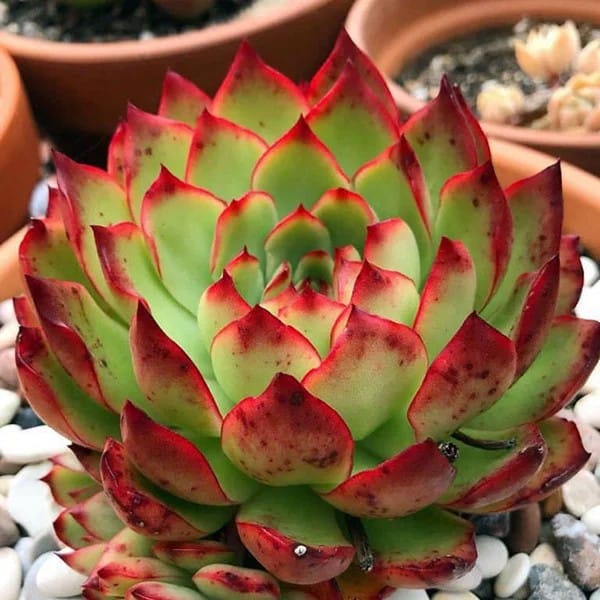
Echeveria ‘Christmas’ is a beautiful, rosette-forming succulent with a tight, up to 8 inches (20 cm) wide rosette of fleshy, apple-green leaves with a strong reddish tinge near the edges and a darker red terminal spine. The flowers are yellow to light orange on a up to 16 inches (40 cm) long, thin flowering stem.
Echeveria ‘Chroma’
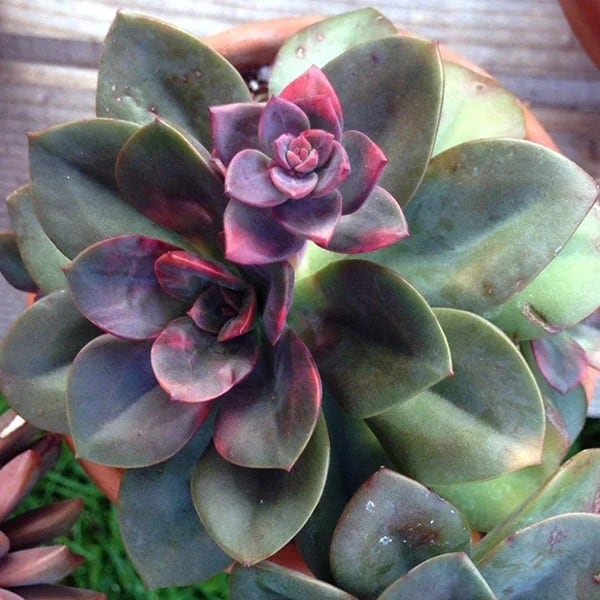
Echeveria ‘Chroma’ is a succulent plant with a sturdy rosette with psychedelic hues of blue-green, purple, and peach all swirled together. This variety has a very variable appearance depending on the light in which it’s grown. Each year it can send up a tall bloom stalk from which dangle yellow, bell-shaped flowers.
Echeveria coccinea

Echeveria coccinea is a succulent rosette-forming shrub, up to 60 cm tall or more that tends to branch at the base. Upright at first, its stems become prostrate and root into the soil to form a spreading mound. The plant is soft-pubescent except for the inside of the flowers.
The leaves are covered in silver hairs and sometimes tinged red along the margins. In late winter into spring appear the relatively large (for an Echeveria), reddish-orange flowers with bright yellow stamens on up to 1 foot (30 cm) long, leafy inflorescences. This species produces lots of thin hair-like aerial roots from the older part of the stem.
Echeveria colorata
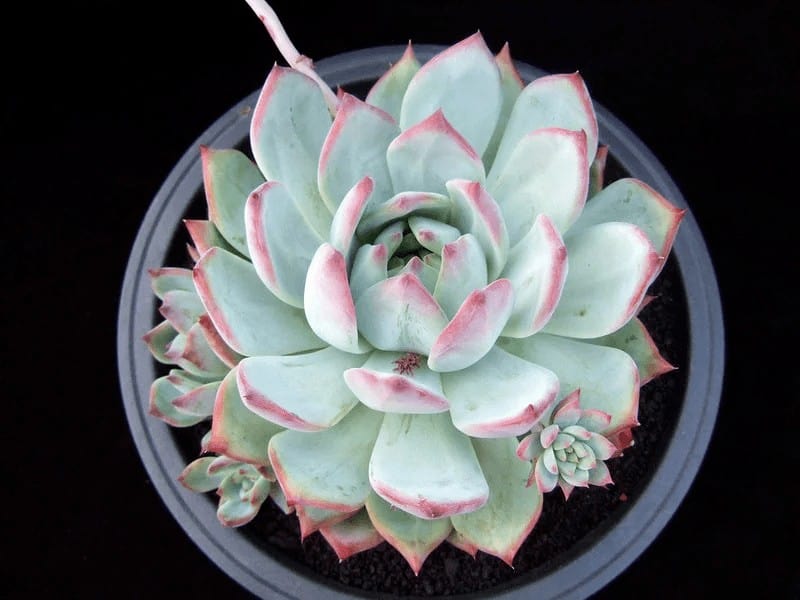
Echeveria colorata is a beautiful, large succulent that forms mostly a solitary rosette, up to 16 inches (40 cm) in diameter, with distinctive silvery, upright, arching, fleshy, lance-shaped leaves with a fine point edged in red. The sweet, pink flowers and arching stems appear in midsummer to fall.
Echeveria colorata f. brandtii
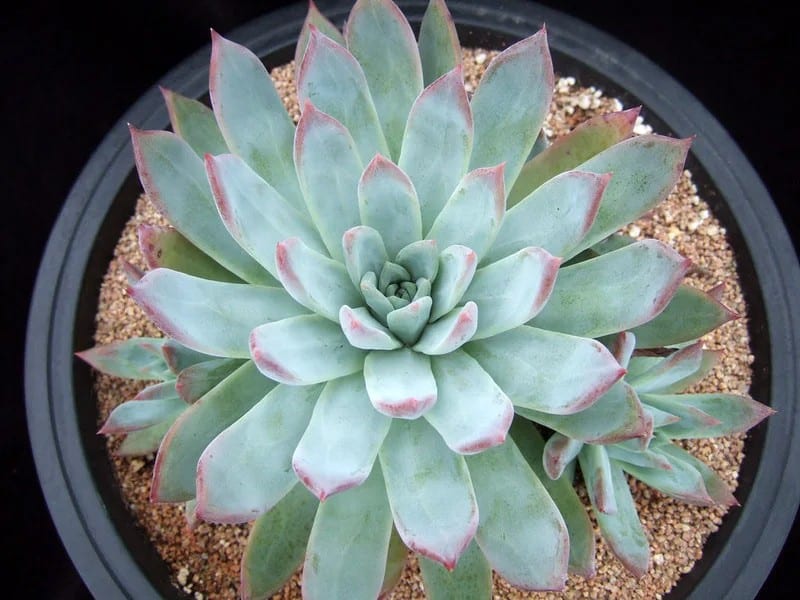
Echeveria colorata f. brandtii is a short, compact, rosette-forming succulent plant. It is a really eye-catching form of Echeveria colorata, with slender leaves with pointed tips and beautiful, red-orange coloring in strong light. The sweet pink flowers and arching stems appear in midsummer to fall.
Echeveria ‘Colorshift’
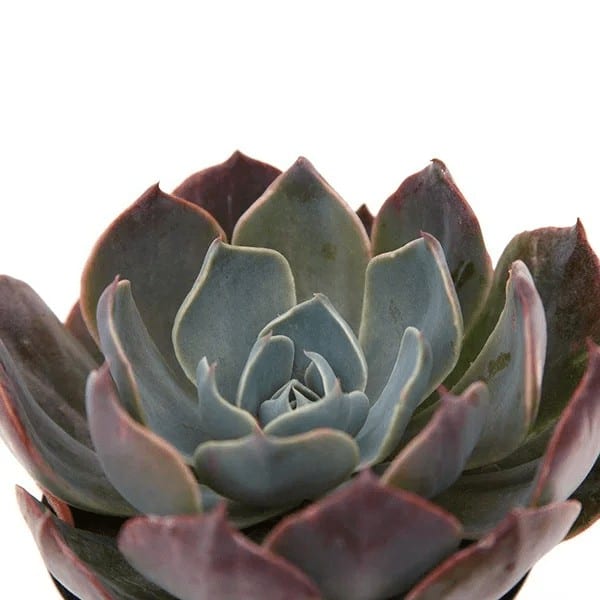
Echeveria ‘Colorshift’ is a succulent plant with deep blue-green leaves that have gorgeous purple/pink margins. This rosette-shaped Echeveria will exhibit even more vibrant colors when exposed to a lot of sunlight.
Echeveria ‘Compton Carousel’
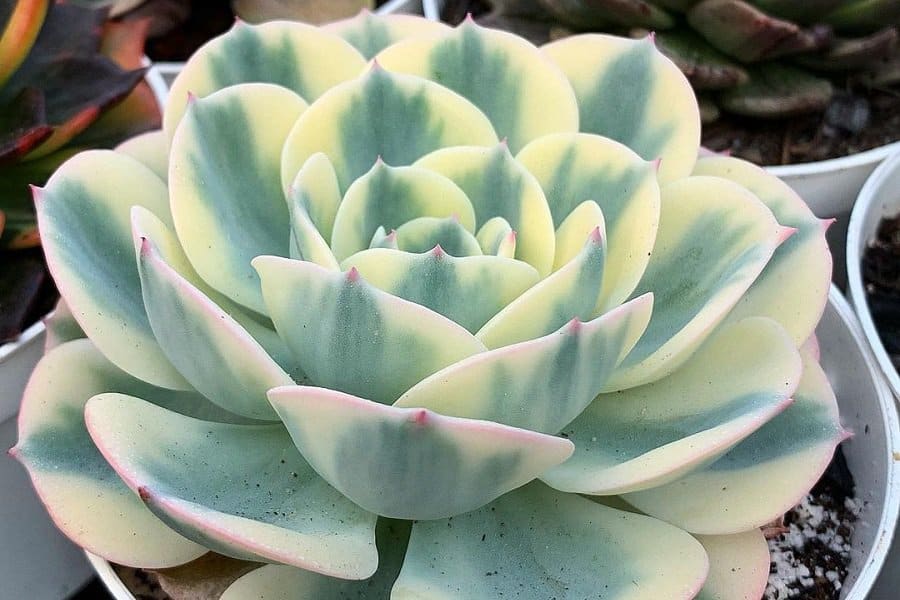
Echeveria Compton Carousel is commonly called the Variegated Hens and Chicks. This species is also known as Echeveria ‘Lenore Dean’ and is a hybrid with parents from the 1800s.
The flowers grow vertically up to 1 foot tall and are orange and yellow in color. The leaves are short and have a shade of bluish-gray color with edges that have a cream-colored tinge.
Echeveria crenulata
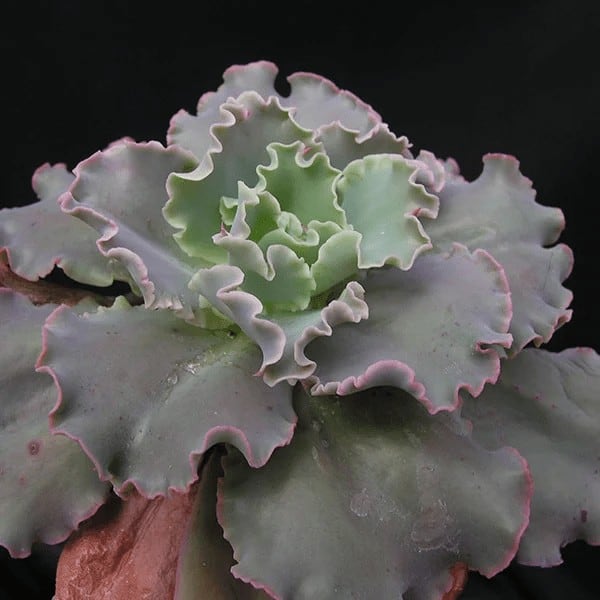
Echeveria crenulata is a perennial succulent that has thick green or gray-green leaves that overlap in rosettes that often resemble artichokes. Leaves are at their brightest from autumn to spring and are followed by long-lasting flowers in pink, red or yellow.
Echeveria ‘Crimson Tide’
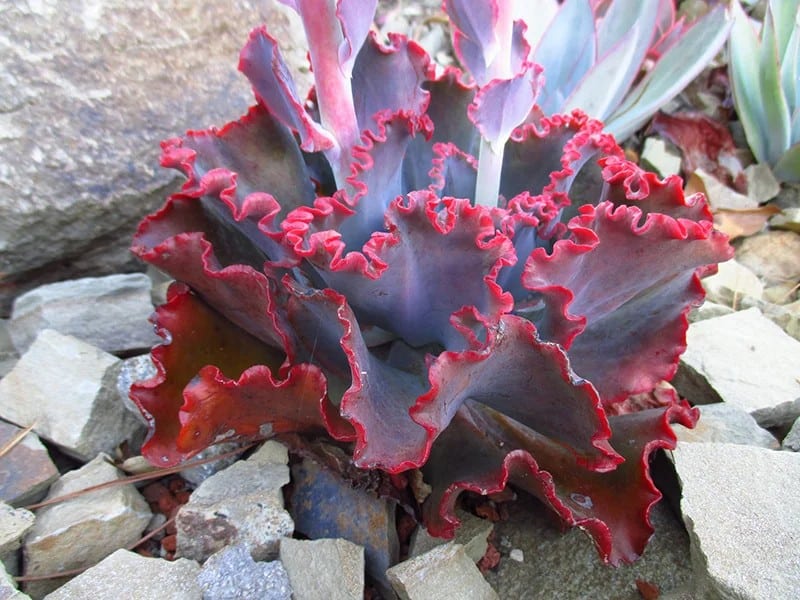
Echeveria ‘Crimson Tide’ is a distinct Echeveria hybrid that forms large rosettes up to 10 inches (25 cm) in diameter, of leaves characterized by unique, vividly colored leaf margins that are unusually undulating and thick. Hummingbirds love the profuse tall flowering stalks with bell-shaped flowers filled with nectar.
Echeveria ‘Crinoline Ruffles’
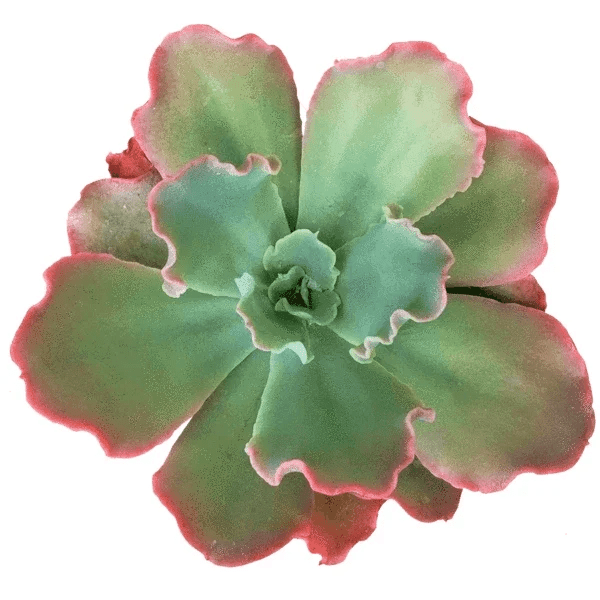
Echeveria ‘Crinoline Ruffles’ (also known as Echeveria First Lady) is a stunning succulent up to 8 inches (20 cm) tall, with dramatically ruffled, fleshy, gray-green rosettes up to 6 inches (15 cm) in diameter and a soft, red edging that is more intense in full sun. Red-orange flowers appear on tall stalks in late summer.
Echeveria ‘Cubic Frost’
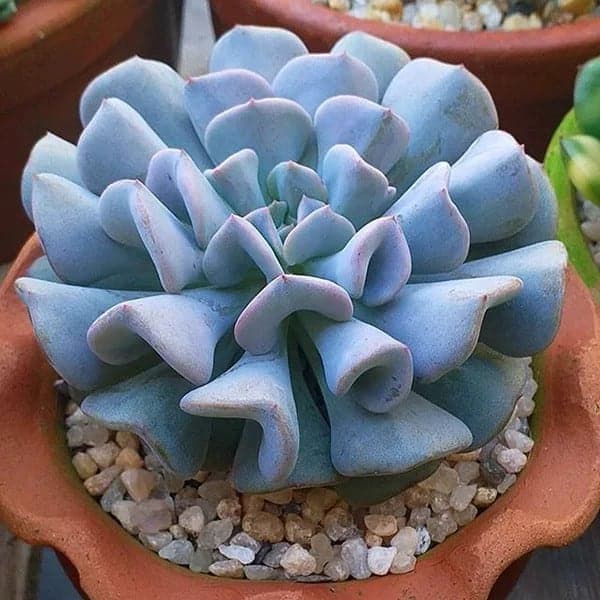
Echeveria ‘Cubic Frost’ is a stunning succulent, up to 8 inches (20 cm) tall, with cool lilac to lilac-pink leaves. It grows quickly and can produce offsets freely, creating attractive clusters of rosettes that can get up to 10 inches (25 cm) in diameter.
Echeveria ‘Culibra’
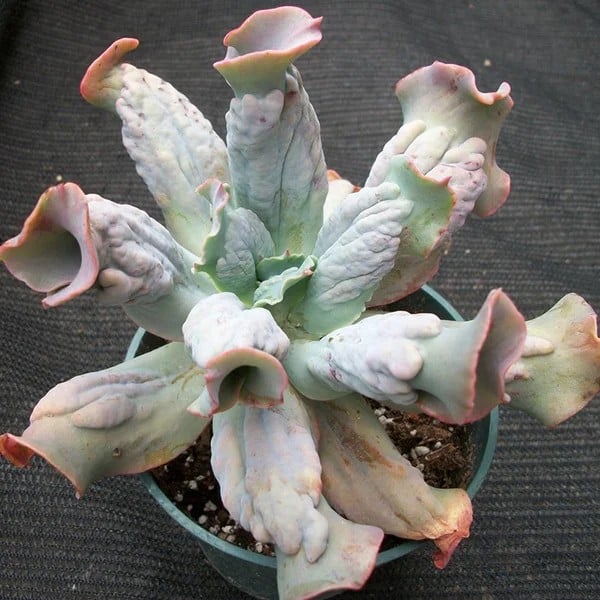
Echeveria ‘Culibra’ is a hybrid Echeveria that forms rosettes to 7 inches or more in diameter with glaucous pale blue leaves with pink wavy margins. Each leaf has a long, raised “cameo” shape known as a “caruncle” on the upper surface.
In time, the “caruncle” causes the leaf to curl downward at the margins, with the resultant creation of a tubular leaf that reminds of a cobra that is arched to strike.
Echeveria cuspidata
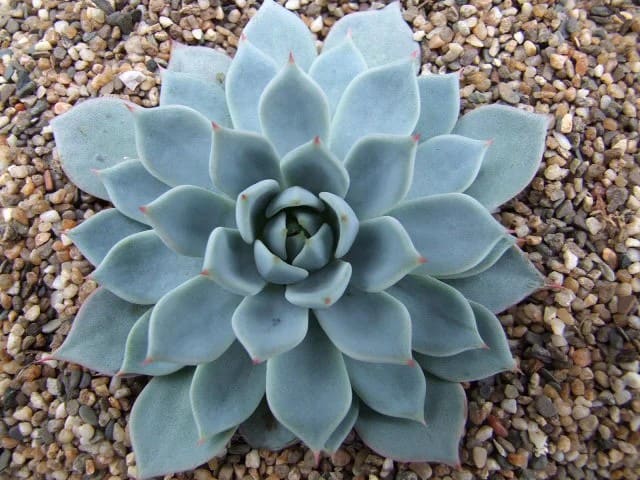
Echeveria cuspidata is a perennial succulent with thick green or gray-green leaves with red tips, up to 4 inches (10 cm) long, that overlap in rosettes that often resemble artichokes. Leaves are at their brightest from autumn to spring and are followed by long-lasting flowers in pink outside and orange inside.
Echeveria ‘Dark Moon’
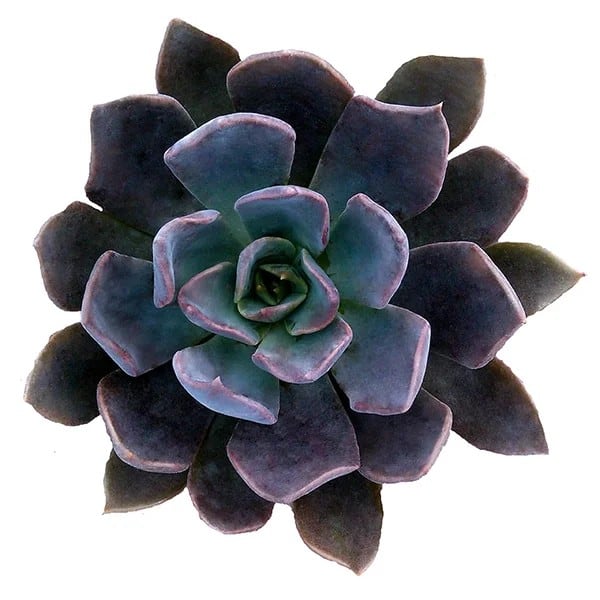
Echeveria ‘Dark Moon’ is characterized by concentric rosettes comprised of an abundance of deep violet-black leaves. This cultivar is robust growing, as compared to other existing dark Echeverias, enabling increased and faster propagation of the cultivar.
The Echeveria ‘Dark Moon’ is more resistant to disease and “shattering” (as occurs with summer stress syndrome, a disease of some Echeverias, particularly the dark-leaved varieties).
Echeveria ‘Decora’
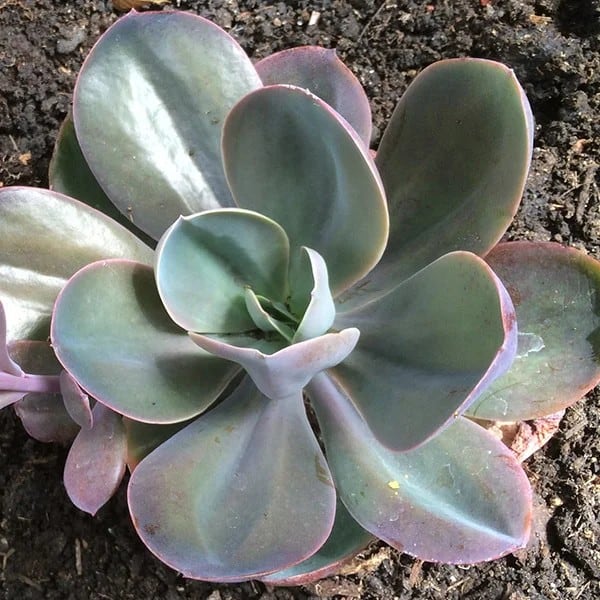
Echeveria Decora is a unique and beautiful succulent. Big-leafed Echeveria decora blushes these incredible shades of pink under stress (full sun, fluctuating temperatures). This succulent has long spoon-shaped leaves that stretch far out and away from each other. It blooms pink flowers in the summer months.
Echeveria derenbergii ‘Painted Lady’
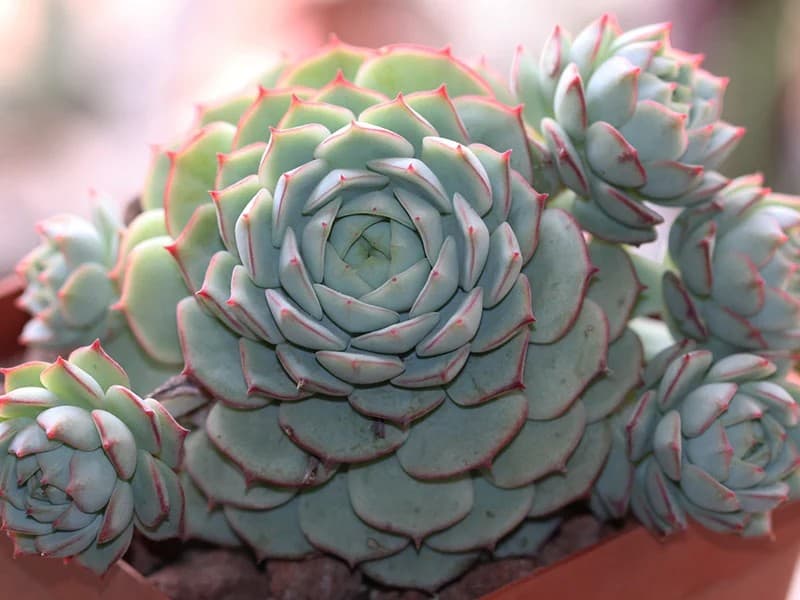
Echeveria derenbergii ‘Painted Lady’ is an evergreen perennial succulent, up to 4 inches (10 cm) tall, with a small, dense basal rosette of pagoda-shaped, frosted, bristle-tipped and fleshy leaves. In late winter to summer, it sends up pink-red stems which bear cup-shaped, yellow flowers with “painted” red tips.
Echeveria ‘Dick’s Pink’
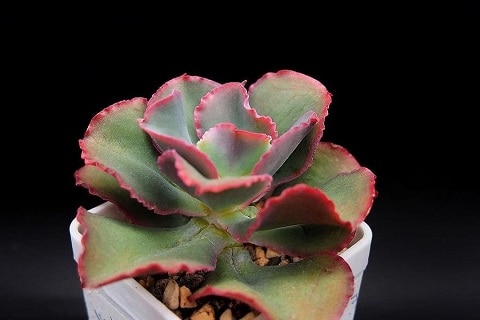
Echeveria Dicks Pink is a type of succulent that belongs to the Crassulaceae family. Its origin is uncertain. However, its parents are said to be Echeveria shaviana and Echeveria gibbiflora.
Echeveria diffractens

Echeveria diffractens is a rare species, that grows at low altitudes in tropical deciduous forests in canyons on volcanic rocks. It is threatened with extinction due to the loss of habitat.
Echeveria diffractens is a glabrous, perennial, stemless or short-stemmed, succulent species that form solitary, flattened rosettes only 2-5 cm tall and 10 cm wide. The leaves are spatulate in shape with, rounded to obtuse apex reddish-purple or pinkish-grey-violet with a light thin cream outline.
In late winter to spring several unbranched erect flowering stems are produced from the center of the rosette. As the inflorescence ages, it elongates and becomes less erect with the stem leaves easily falling off as the many pale orange flowers emerge.
New plants can be grown from the small leaflets (bracts) on the flower stalk. It isn’t a fast grower but produces flowers on very small plants. This is typically a solitary plant in habitat but in cultivation older plants will often be in a cluster.
Echeveria ‘Domingo’
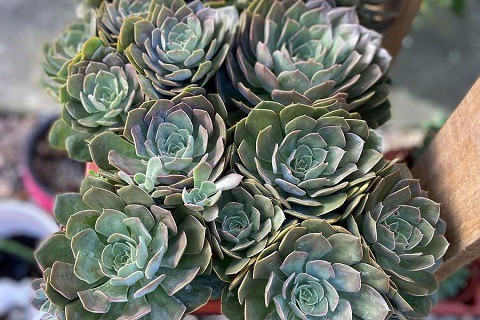
Echeveria Domingo is a hybrid made by Dick Wright between Echeveria runyonii and Echeveria cante. It has a distinct appearance with long and solitary rosettes that grow up to 10 inches in diameter.
Echeveria ‘Dondo’
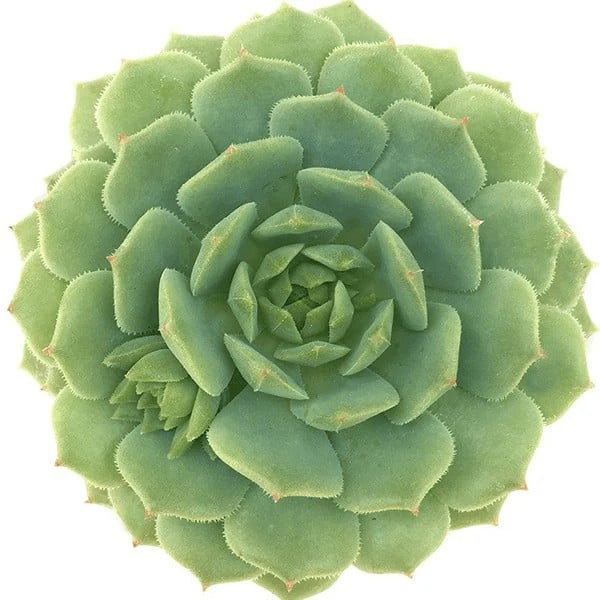
Echeveria Dondo is a rosette-shaped succulent plant with super-compact, chubby, gray-green colored leaves. The leaf tips have a small, soft spine that sometimes blushes red. The leaf margins are lined with fuzzy hairs, and are unique to this echeveria, making it recognizable amongst a crowd.
Echeveria ‘Doris Taylor’
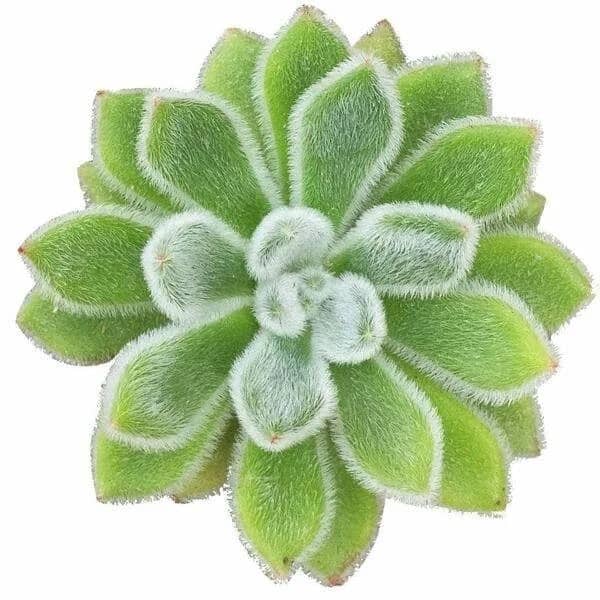
Echeveria ‘Doris Taylor’, or Woolly Rose, is an open rosette with very fuzzy leaves coated with a thick layer of cilia. It is bright apple green with small red leaf tips when grown in bright sun. Woolly Rose offsets readily and forms nice large clumps. This Echeveria is a hybrid of Echeveria pulvinata and Echeveria setosa.
Echeveria ‘Dusty Rose’
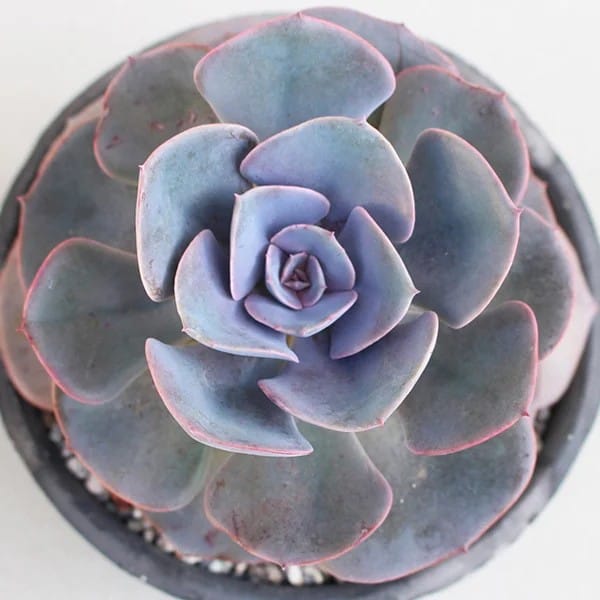
Echeveria ‘Dusty Rose’ is an attractive succulent plant with stunning, variable coloration. Its wide, spatulate leaves are hues of pink and violet, deepening in color when grown in bright sunlight. It has a thick coating of natural wax that both allows it to tolerate full sun and gives it a soft, pastel appearance.
Though slow to offset, ‘Dusty Rose’ does send up a tall bloom stalk from which hang coral, bell-shaped flowers.
Echeveria elegans ‘Mexican Snowball’
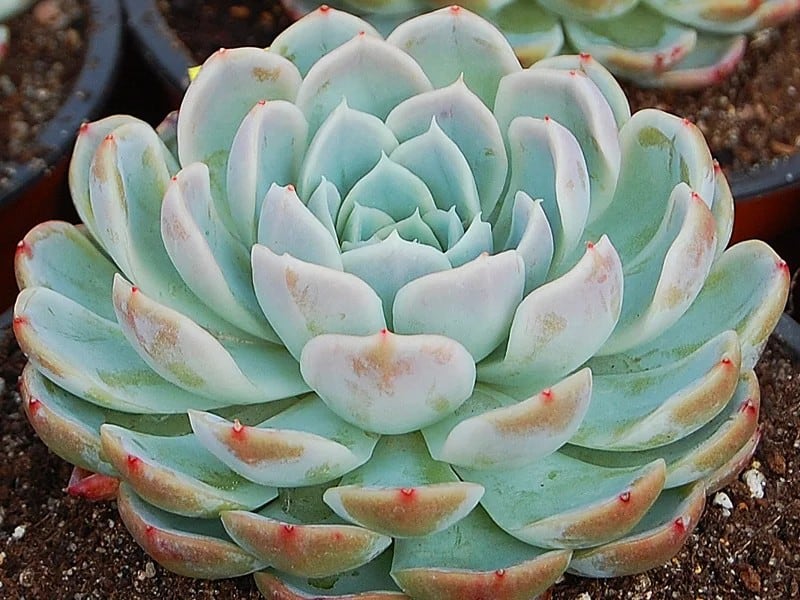
Echeveria elegans ‘Mexican Snowball’ is a popular succulent that forms compact rosettes of fleshy, spoon-shaped, and pale bluish-green leaves. It is a variable species with several forms that have only minor differences in the size and shape of leaves and the color of flowers. Plants grown in bright sunlight can take on a lovely pink blush.
Echeveria elegans ‘Raspberry Ice’
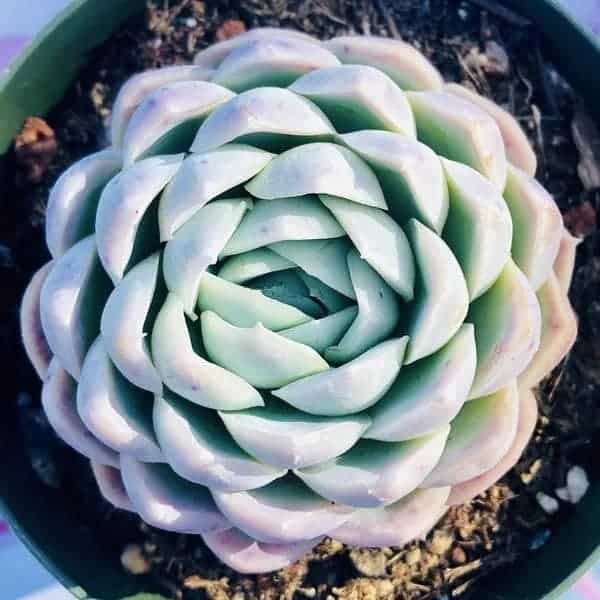
This delicate succulent produces rosettes of spoon-shaped leaves which appear light green then develop a pink tinge towards the tips deepening in color to rose. It will develop into a solid mound and in summer it produces cream flowers on long stems. This plant is thought to be a cultivar of Echeveria elegans.
Echeveria eurychlamys
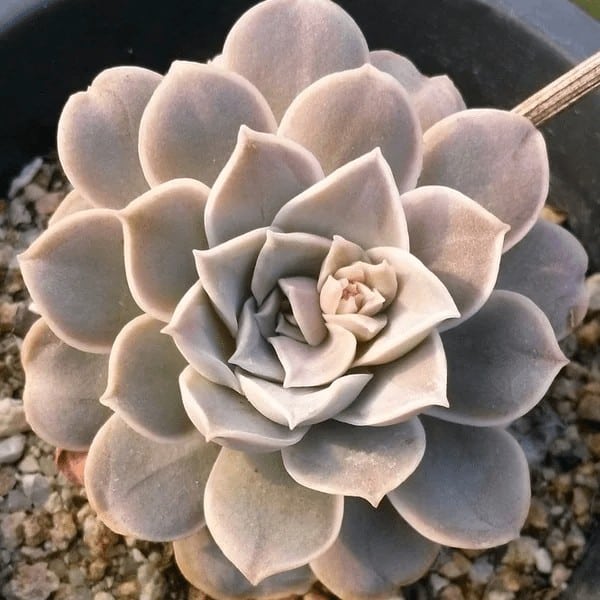
Echeveria eurychlamys is a succulent glabrous herb with usually a single rosette that grows up to about 9 to 15cm wide. Its leaves are flat, widely obovate-oblong, rarely spathulate in older plants, light green to glaucous-whitish, and darker when exposed to light.
In the Summer, the Echeveria eurychlamys blooms small yellow-salmon flowers on a tall bloom stalk.
Echeveria ‘Etna’
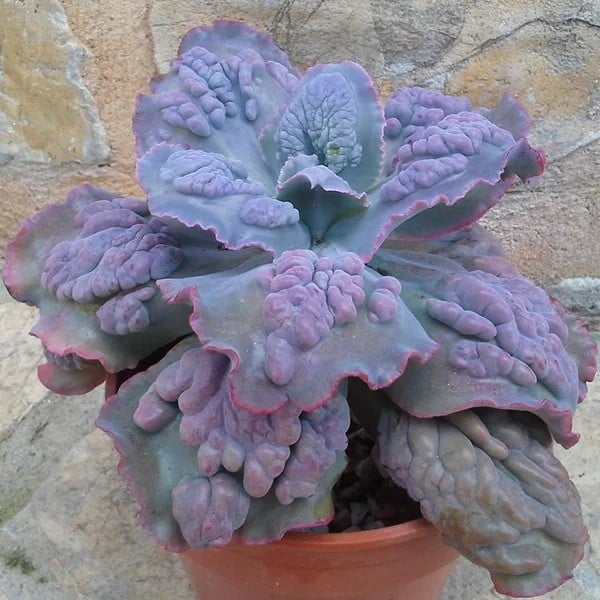
Echeveria Etna is a spectacular Echeveria hybrid forming rosettes up to 12 inches (30 cm) in diameter. The leaves are frosty violet-blue with warts or “caruncles”. The flowers are bell-shaped, orange-red and appear on long inflorescence, blooming in the Summer. It got its name from Mount Etna, a volcano in Sicily, Italy.
Echeveria expatriata
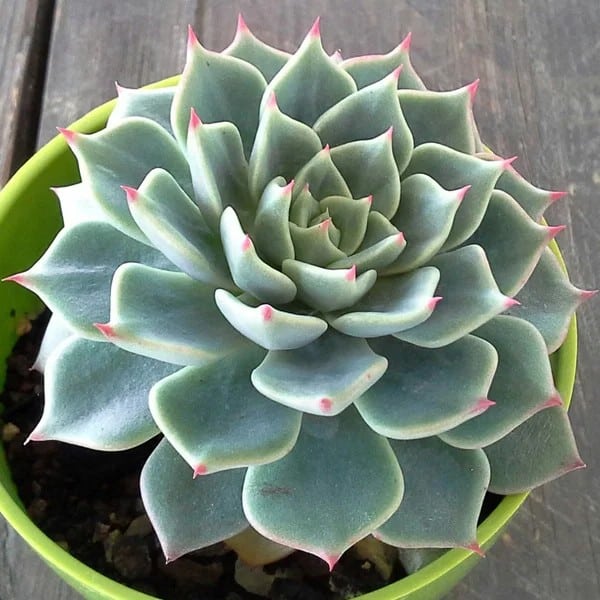
Echeveria expatriata, also known as Cremneria ‘Expatriata’, is a low-growing, perennial succulent up to 4 inches (10 cm) tall. The stem is crowned by a dense rosette of leaves and gives off new rosettes on the naked part below. The leaves are glaucous and up to 1 inch (2.5 cm) long. The inflorescence reaches up to 5 inches (12.5 cm) long, bearing pinkish flowers.
Echeveria Fabiola
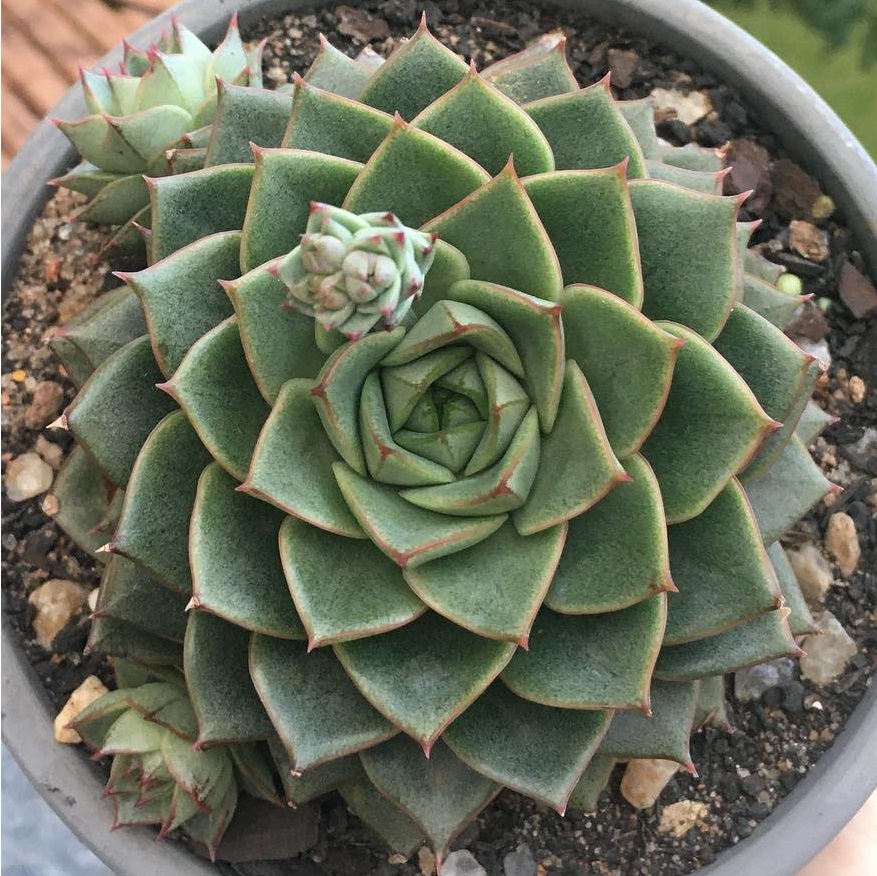
Echeveria Fabiola is a hybrid of Echeveria purpusorum and Echeveria derenbergii. It has a beautiful appearance with small and tight rosettes. These rosettes have leaves that are green in color with a reddish tip at the margin.
Echeveria fimbriata
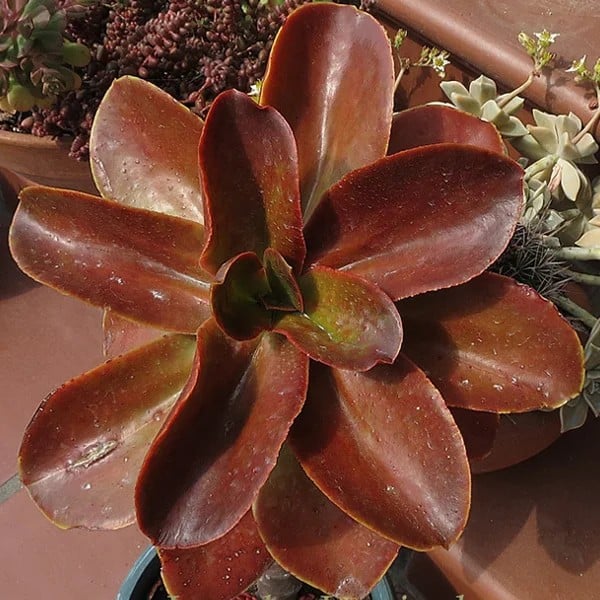
Echeveria fimbriata produces maroon rosettes of large oval leaves each edged in fine hairs which turn red in ideal sunlight. It develops a very uniquely detailed thick trunk and produces neon pink flower spikes in the spring.
Echeveria ‘Fireball’
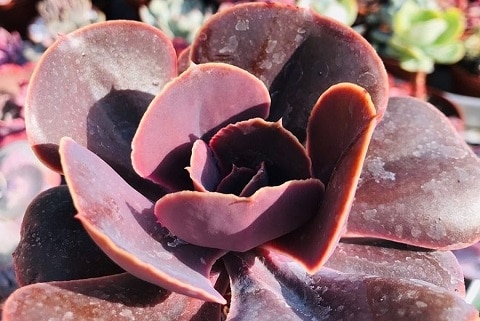
Echeveria Fireball is a polycarpic species and a low-growing succulent that flowers many times a year. The rosettes are tight and compact, and the flowers rise from short stems. The leaves are brightly colored and have a reddish-brown tone with faded yellow margins.
Echeveria ‘Fleur Blanc’
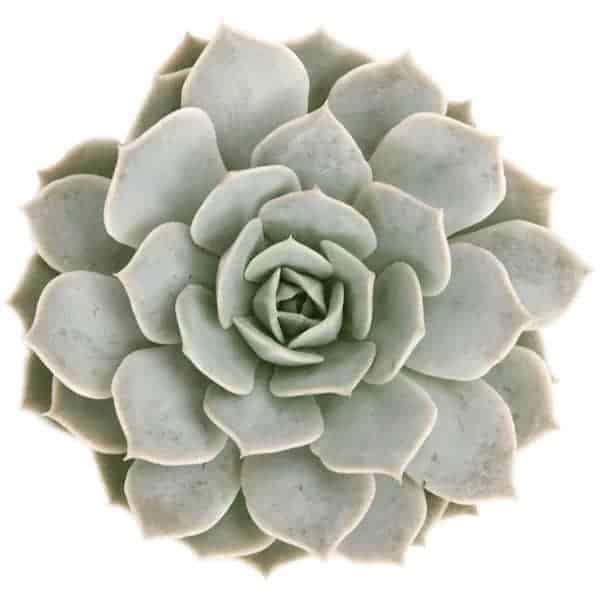
Echeveria ‘Fleur Blanc’ is a pale green, rosette-shaped succulent with leaves that blush a pink hue on the margins. These powdery leaves create a gorgeous pastel color that makes these succulents a great addition to any garden or planter.
Echeveria fulgens var. obtusifolia
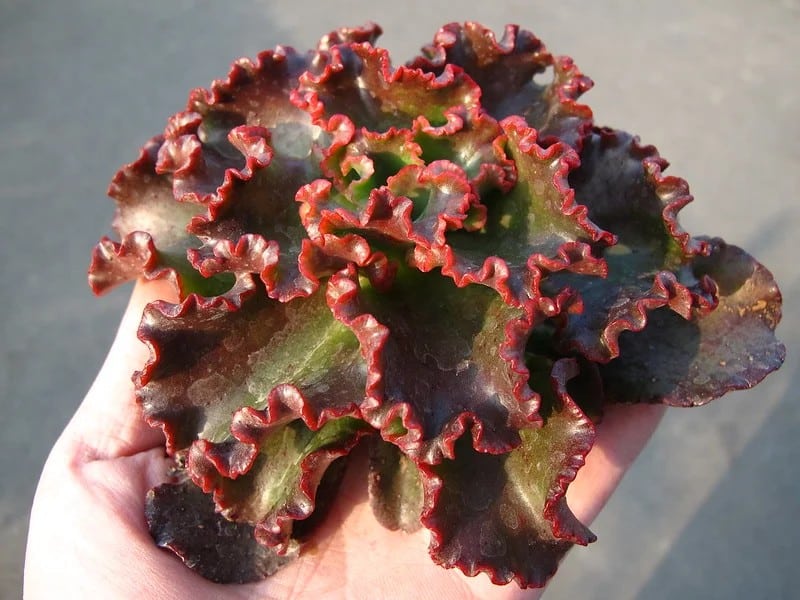
Echeveria fulgens var. obtusifolia is a low-growing succulent to about 8 inches wide that grows flat to the ground at first and later up on a short stem and open rosette of 4 to 5-inch-long obovate glaucous gray leaves that lay flat and have pink overtones near their tips.
In summer, on an 8 to 12-inch-long branching and nodding inflorescence, appear the stunning reddish flowers. Echeveria fulgens var. obtusifolia is in the Gibbiflorae group and differs from Echeveria gibbiflora in being much smaller.
Echeveria ‘Frosty’
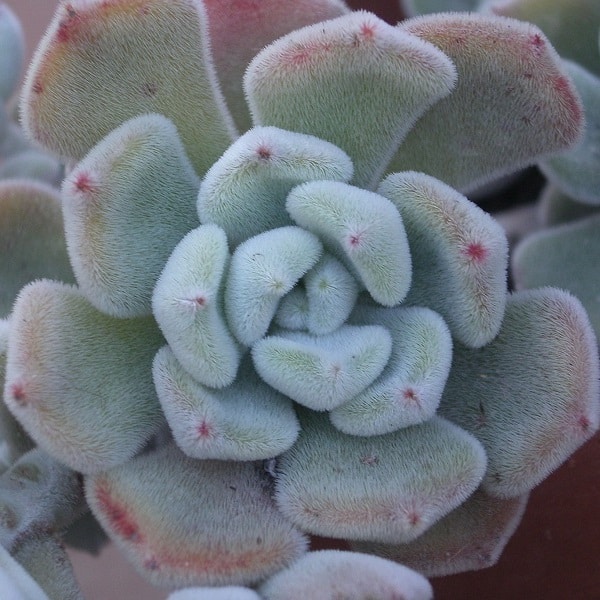
Echeveria Frosty has leaves that are covered with tiny hair follicles, because of which they have a velvety texture. The flowers are in the shape of bells with orange and yellow blooms.
Echeveria fulgens
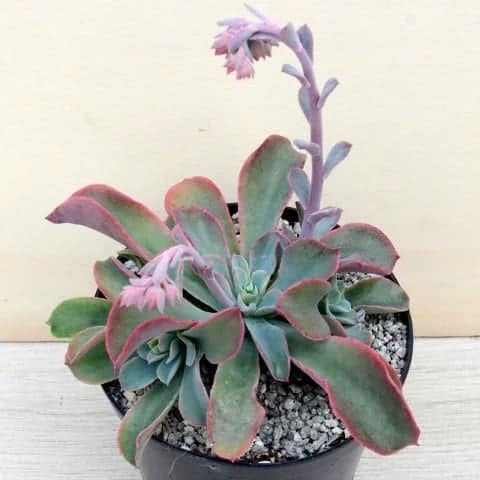
Echeveria fulgens is a low-growing succulent to about 8 inches wide that grows flat to the ground at first and later up on a short stem and open rosette of 4 to 5-inch-long obovate glaucous gray leaves that lay flat and have pink overtones near their tips.
In summer, on a 12-18-inch-long branching and nodding inflorescence, appear the stunning pink flowers that are apricot on the interior. Echeveria fulgens is in the Gibbiflorae group and differs from Echeveria gibbiflora in being much smaller.
Echeveria ‘Galaxy Blue’
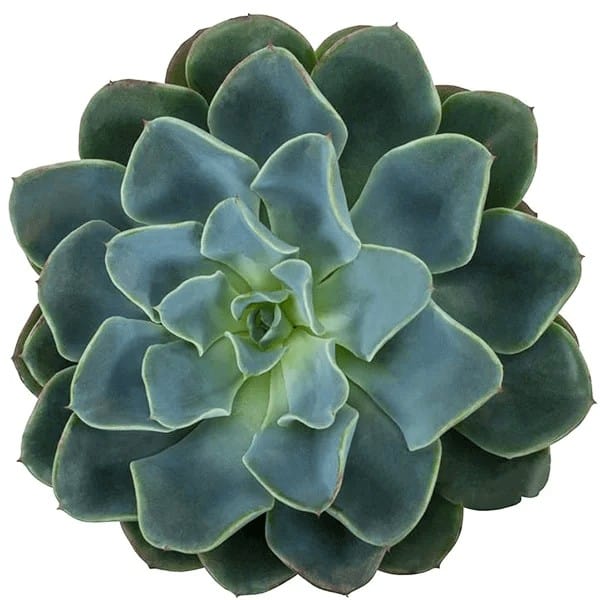
Echeveria ‘Galaxy Blue’ produces a stunning icy blue rosette with large, wavy leaves. This cultivar has a wide, open form, reaching 6 to 8 inches in diameter but staying low to the ground. It offsets freely and produces yellow, bell-shaped blooms each spring. It can get bright pink points at its leaf tips when kept in the bright sun.
Echeveria Giant Blue
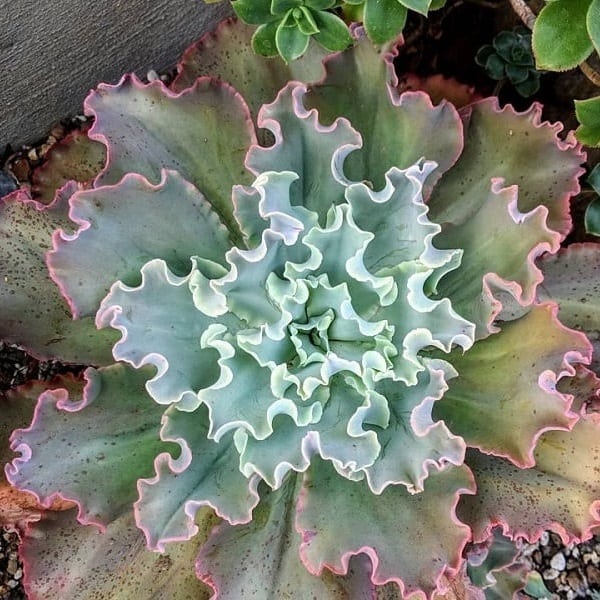
Echeveria Giant Blue has rosettes that are large in size and have leaves growing on them that are ruffled.
Echeveria gibbiflora ‘Bittersweet’
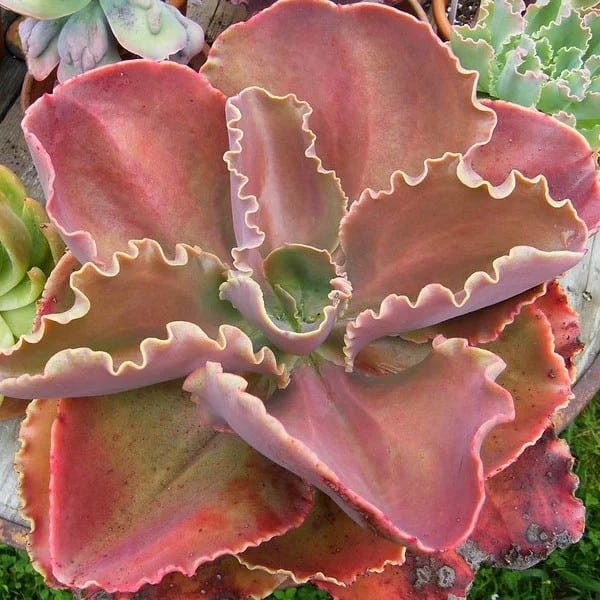
Echeveria gibbiflora ‘Bittersweet’ has a rosette that grows up to about 40 cm across. Its identification trait is in the distinct white line of the leaf edge. This is a stout, tall, vigorous hybrid seldom branching, similar in habit to Echeveria gibbiflora.
The stem is barely topped with a rosette of up to 20 broad spatulate leaves, which are narrow and fleshy at the base, the color of light mahogany, the leaf margins crimped and undulating.
Echeveria gibbiflora ‘Caronculata’
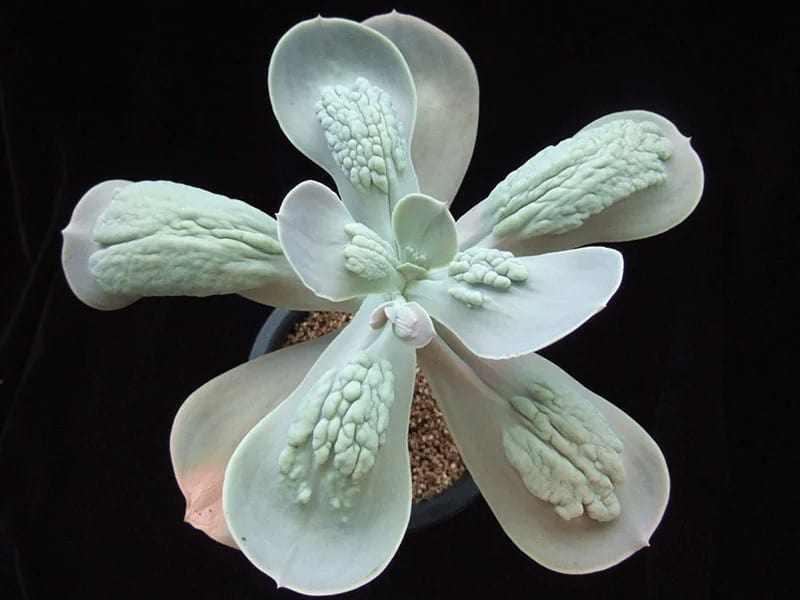
Echeveria gibbiflora ‘Caronculata’ is a cultivar of Echeveria gibbiflora with bumpy wart-like lumps, called carunculations, on the upper surface of the leaves. The stem is up to 1 foot (30 cm) long and up to 1 inch (2.5 cm) in diameter. Leaves are gray-green flushed with red and up to 8 inches (20 cm) long.
Echeveria gibbiflora ‘Metallica’
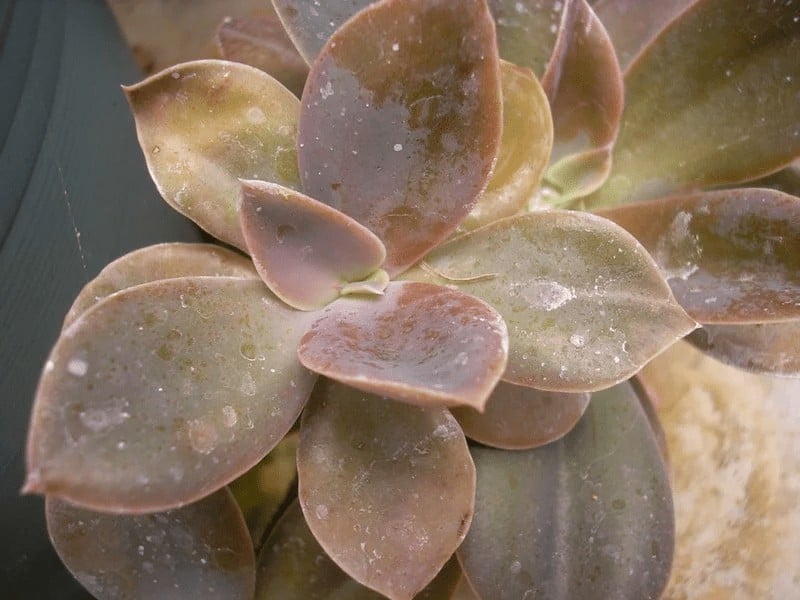
Echeveria Metallica is a succulent, evergreen perennial with short-stemmed rosettes of spoon-shaped, wavy-edged, metallic bronze-green leaves with pink margins and up to 8 inches (20 cm) long. The racemes of bell-shaped reddish flowers are yellow inside.
Echeveria gigantea
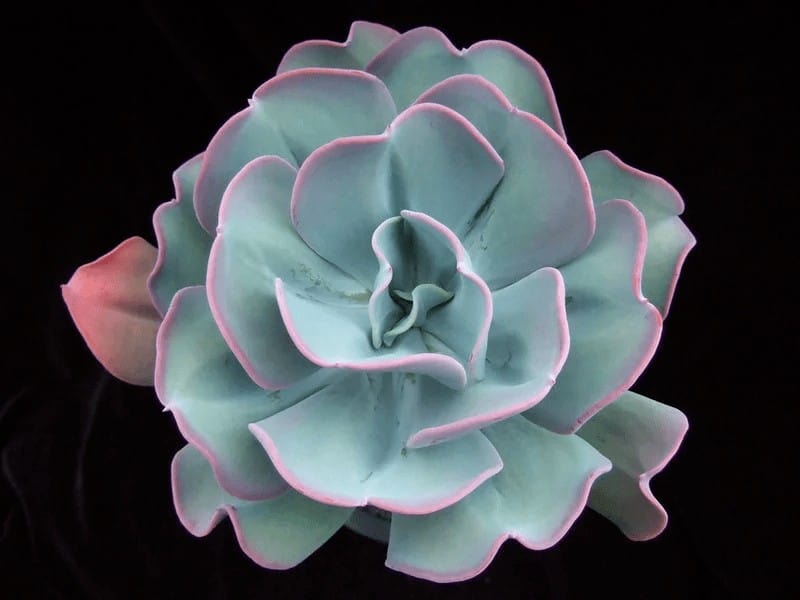
Echeveria gigantea is a large succulent plant in the Gibbiflorae group of Echeveria that rises up on unbranched stems up to 18 inches (45 cm) and has 2 foot (60 cm) wide open rosettes of large, broad, spoon-shaped, green to gray-green leaves that have a slightly wavy apex and reddish margin.
Echeveria ‘Gilva’
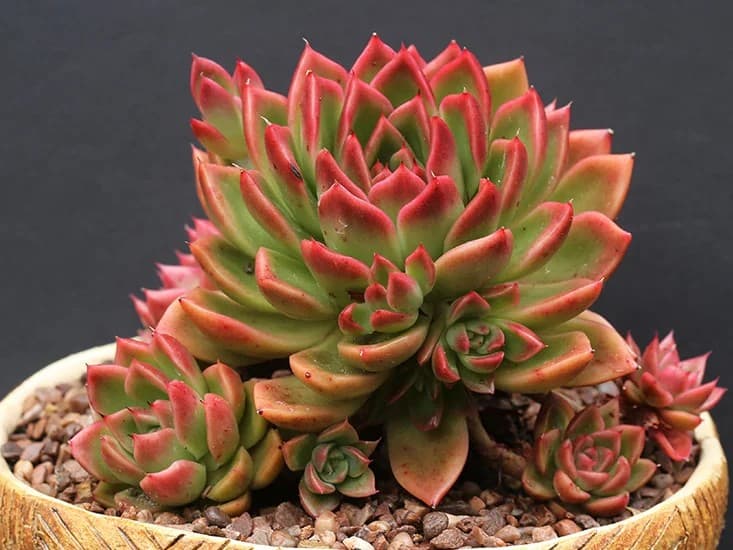
Echeveria Gilva is a gorgeous succulent forming a tight rosette succulent with stubby, glossy green leaves. Each leaf tip ends with a red point. Leaves will blush red with sun and temperature stress.
Echeveria globuliflora
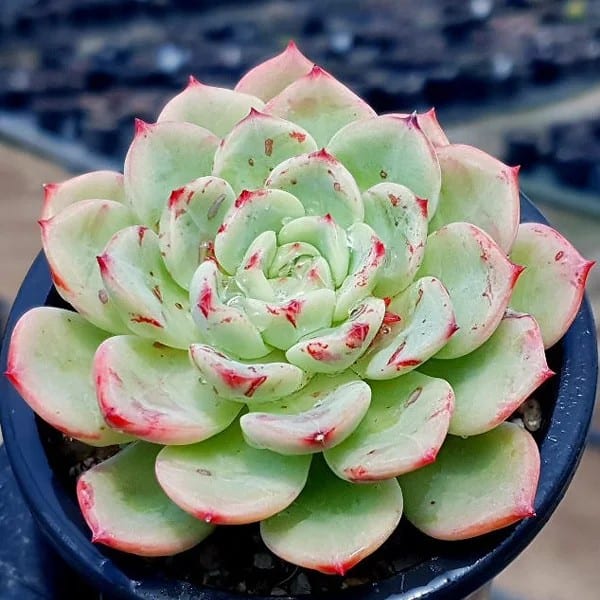
Echeveria globuliflora has green leaves that are oblong-oblanceolate to obovate-cuneate, mucronate, acute or shortly acuminate. The tips of the leaves are reddish. It blooms small orange-red flowers that end on a 25 cm long flower stalk.
Echeveria globulosa
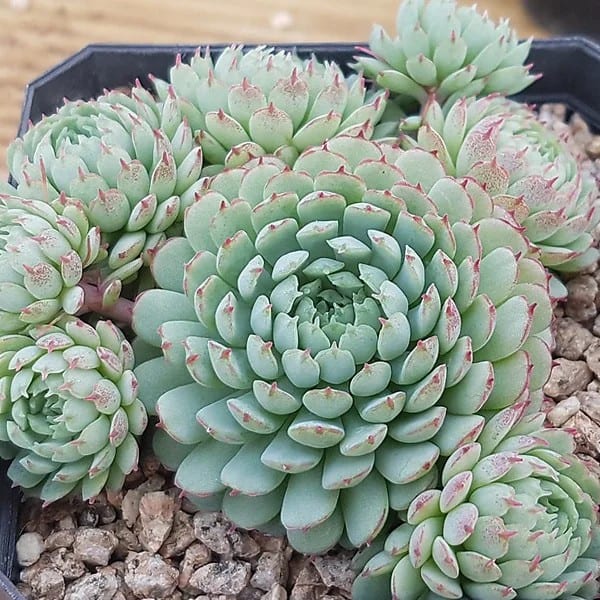
Echeveria globulosa is a very beautiful succulent plant with compact rosettes with fleshy, pointed leaves. It spreads easily to form a low-growing, compact clump or cluster. The rosettes are up to 5 cm in diameter and the cluster won’t grow taller than 15 cm.
The leaves are pale blue and can be blushed with pink. It produces brightly colored orange-yellow flowers that grow on short stems above the rosettes.
Echeveria ‘Goochie’
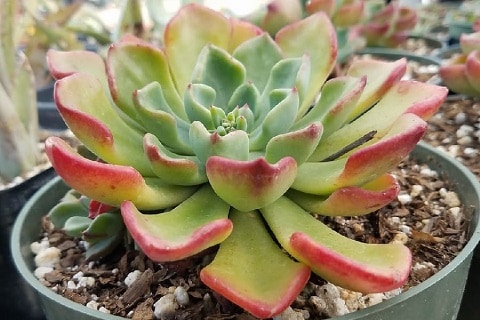
Echeveria Goochie is a succulent that belongs to the Crassulaceae family. The rosette is compact with leaves that grow with a slight curve, similar to the shape of a cup.
Echeveria ‘Golden Glow’
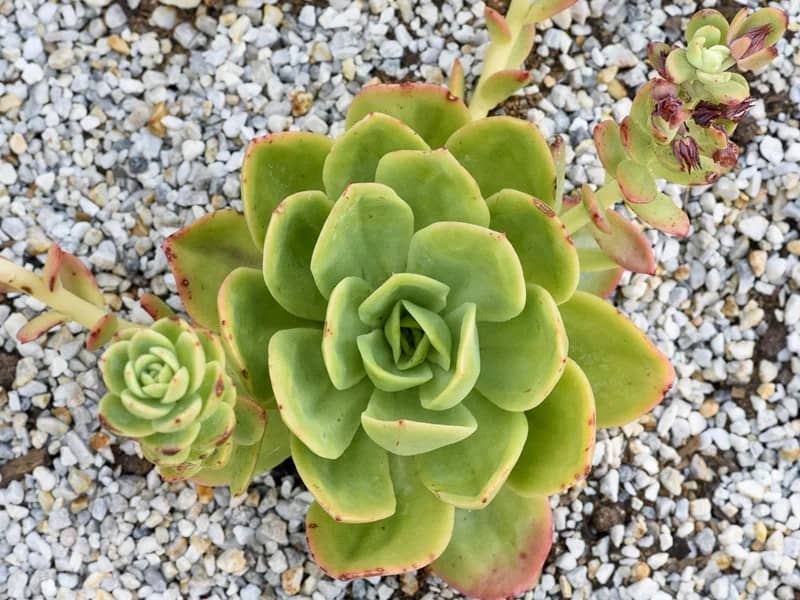
Echeveria ‘Golden Glow’ (Golden Hens and Chicks) is an evergreen, clump-forming succulent plant. It can grow up to 30 cm tall, with up to 25 cm wide rosettes of broad, pale green to yellow-green, spoon-like leaves that can blush pink along the margin in summer when grown in sun.
The plant looks solitary and is slow to have offsets but eventually can form a cluster up to 45 cm wide or more with slowly elongating decumbent stems.
Echeveria goldmanii
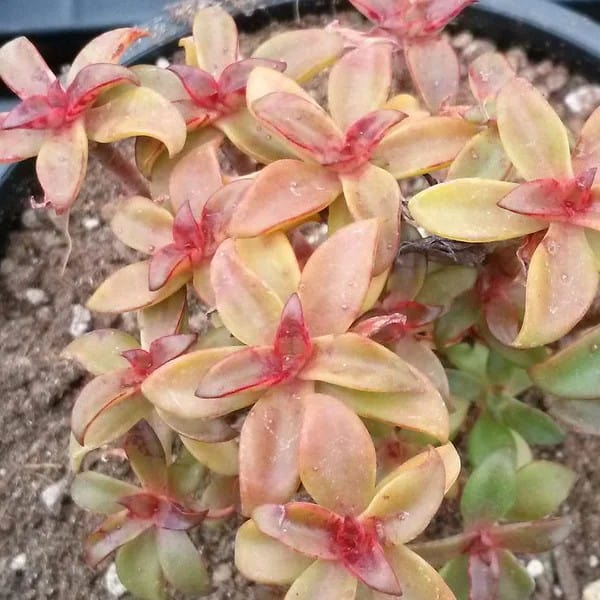
Echeveria goldmanii grows on stems that are at first erect and bushy, often prostrate and rooting at the nodes, and sometimes becoming 20 cm high. Its leaves are glabrous, shining, linear-oblong, 2 – 3 cm long, acute or obtuse, trough-shaped, pale-green with purple margins.
Echeveria Green Pearl
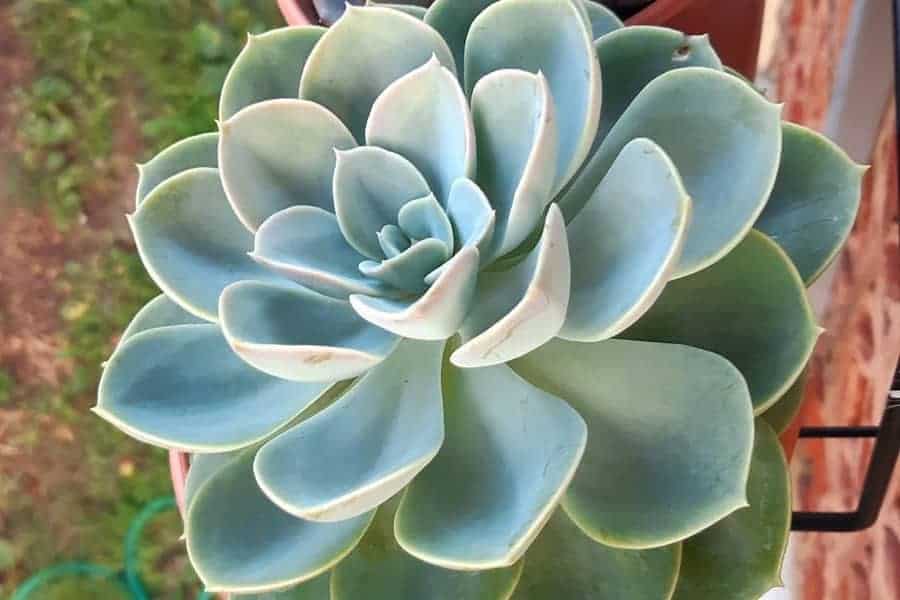
Echeveria Green Pearl is a low-growing succulent. The rosettes are solitary and compact, with their leaves protruding upwards. These leaves are bright green in color and have a slight point at the tip.
Echeveria grisea
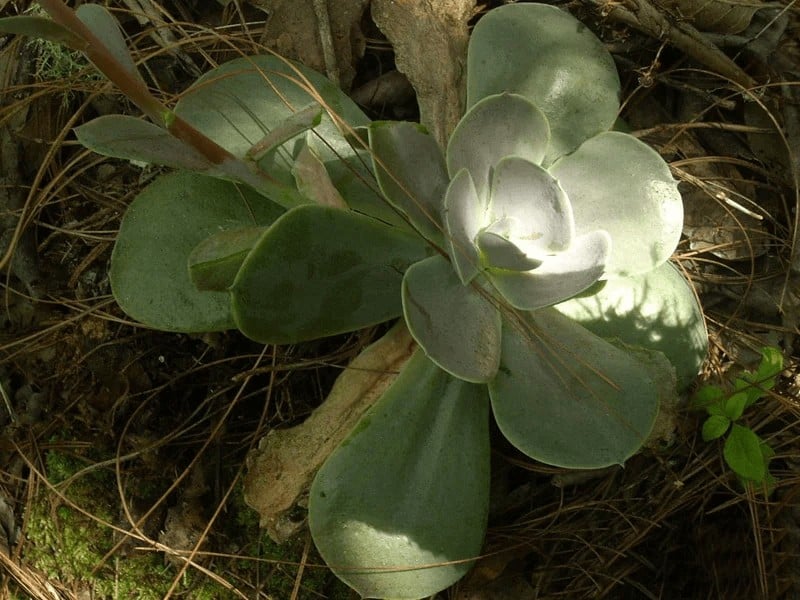
Echeveria grisea is a low-growing rosette-forming succulent similar to Echeveria fulgens or Echeveria obtusifolia but differs in its thicker leaves. It is seldom seen in cultivation and is considered one of the less attractive Echeveria types of the Gibbiflorae group, nevertheless its flowers are a lovely pink color and quite decorative.
Its leaves are corydalis-green to asphodel-green, pruinose, and occasionally spotted deep purplish vinaceous. It blooms in December and January.
Echeveria halbingeri
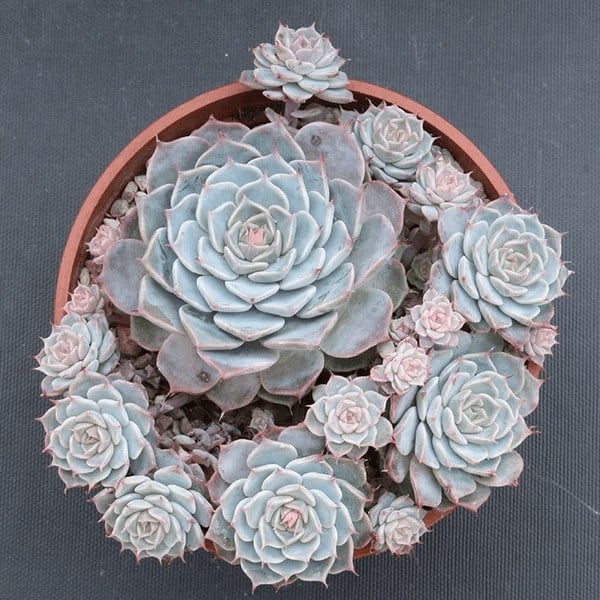
Echeveria halbingeri is a tight rosette-forming gray-leafed succulent that offsets to form a dense small mound. In mid-spring, it sports flowers with yellow tubes with pale pink coloration at the base. These succulents stay small, and it offsets freely, similar to an Echeveria prolifica.
Echeveria halbingeri var. goldiana
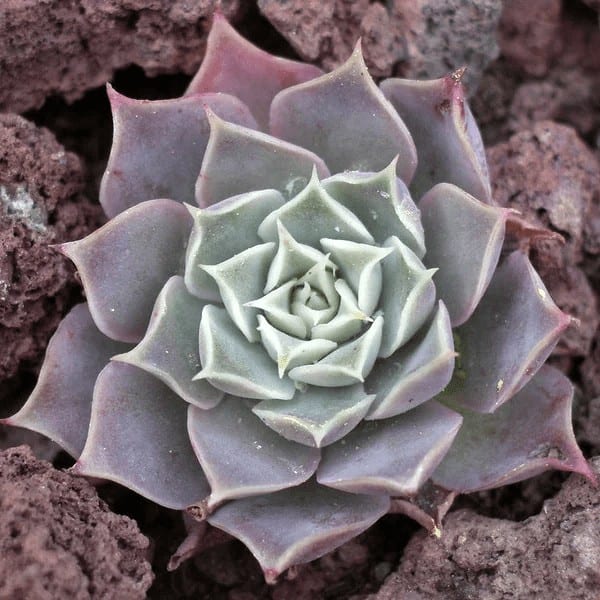
Echeveria halbingeri var. goldiana is a glabrous and stemless succulent that form dense rosettes. Its leaves are lettuce green to dull light coffee-colored, broadly obovate-cuneate and growing to 4 cm long. Its slender flower stalks carry strongly nodding begonia-rose flowers.
Echeveria harmsii
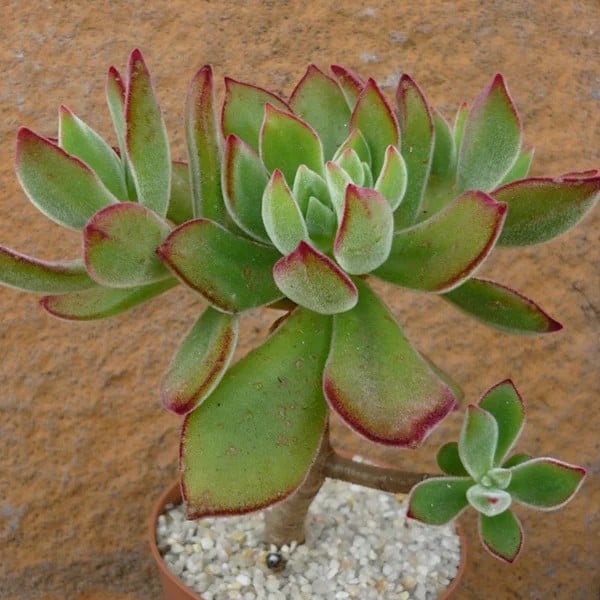
Echeveria harmsii, commonly known as Plush Plant or Red Echeveria, is a succulent evergreen subshrub native to Mexico. Echeveria harmsii is a branching, densely pubescent succulent, up to 12 inches (30 cm) tall, with rosettes of narrow, light green leaves with red edges.
Flowers are bright red except the yellow tips, bell-shaped, up to 0.6 inches (1.5 cm) long and appear in spring.
Echeveria harmsii ‘Ruby Slippers’
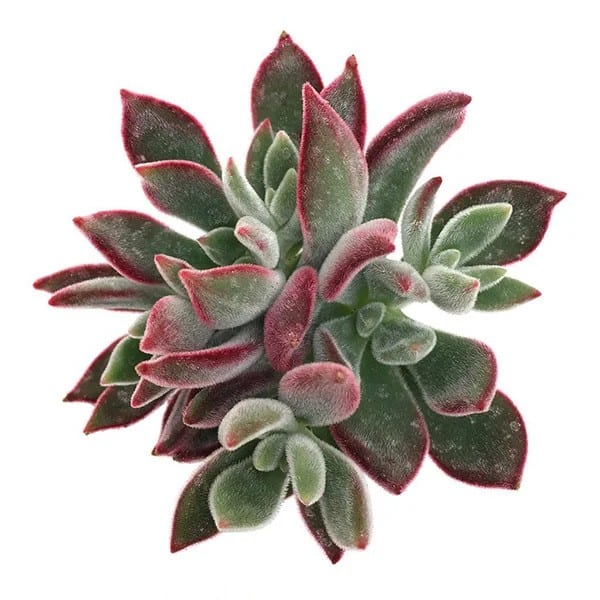
Echeveria harmsii ‘Ruby Slippers’ is a shrubby succulent up to 12 inches (30 cm) tall and wide, with woody stems densely covered with foliage. The color and texture of its leaves will warm your heart. They are green, paddle-shaped and are covered with soft, silvery fuzz.
The tips of the leaves are a deep pink-red. The flowers are bright orange, bell-shaped and carried in clusters on stems that rise above the foliage.
Echeveria heterosepala
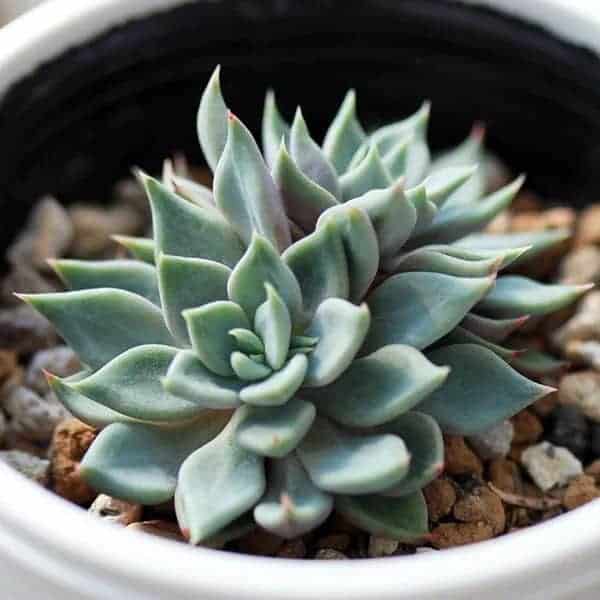
Echeveria heterosepala forms a dense rosette up to 5 cm wide. Its basal leaves are obovate, somewhat acuminate, tipped with a long mucro, glabrous, perhaps also glaucous, that is about 3 cm long. When it blooms, it sends out a 15 cm flower stalk with leaves which ends in near elf green flowers.
Echeveria humilis
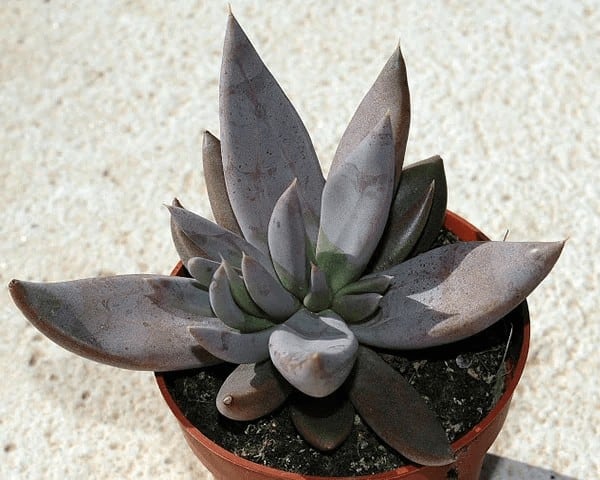
Echeveria humilis is a low-growing succulent that forms a dense rosette with acute leaves that are 5 to 6 cm long. When it blooms, it sends out a roughly 10 cm weak flower stalk with salmon-red tiny flowers.
Echeveria hyalina
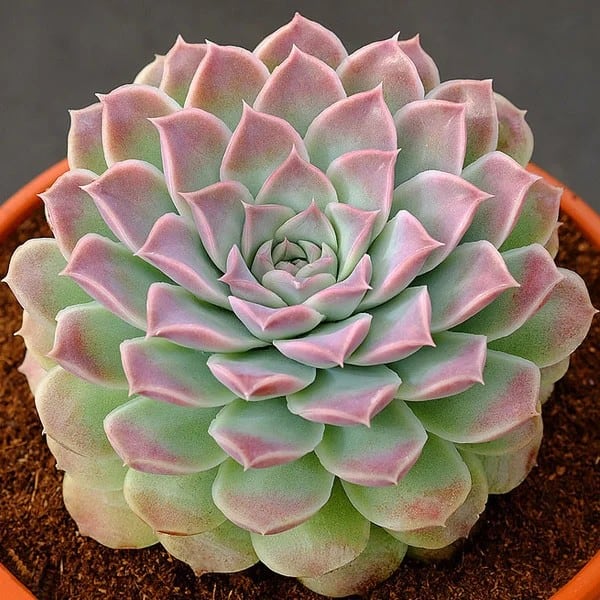
Echeveria hyaline is a stemless succulent with densely crowded leaves that are whitish-crystalline with thin, hyaline margins and greyish pink tips. In January and February, it blooms bell-shaped pink-green flowers at the end of a long and slender bloom stalk.
Echeveria imbricata ‘Blue Rose’
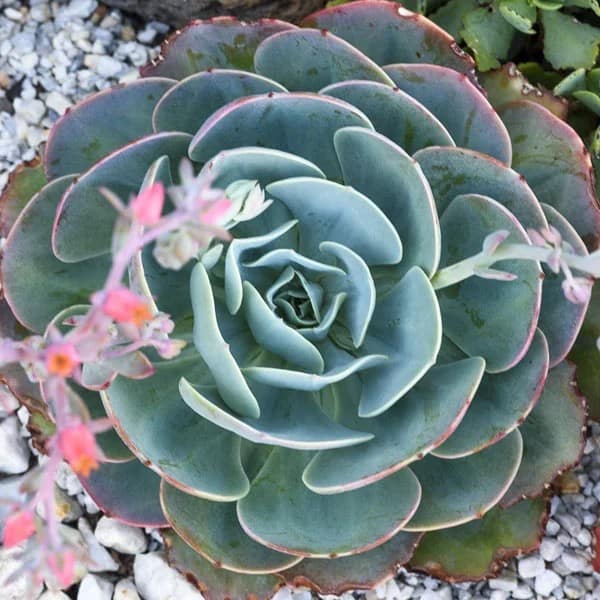
Vigorous and popular, Echeveria ‘Imbricata’ (also known as Blue Rose Echeveria) is a small evergreen succulent forming tight rosettes of fleshy, saucer-shaped, blue-green leaves. It produces offsets very freely. They hug the mother rosette, creating overlapping circles.
In the spring and early summer, a flowering spike bearing loose clusters of small, bell-shaped orange-red flowers is on display.
This is one of the hardiest of the Echeveria varieties, tolerating short durations of temperatures down to 20°F (-6°C). Echeveria ‘Imbricata‘ is one of the oldest hybrids and results from a cross between Echeveria glauca and Echeveria Metallica.
Echeveria ‘Irish Mint’
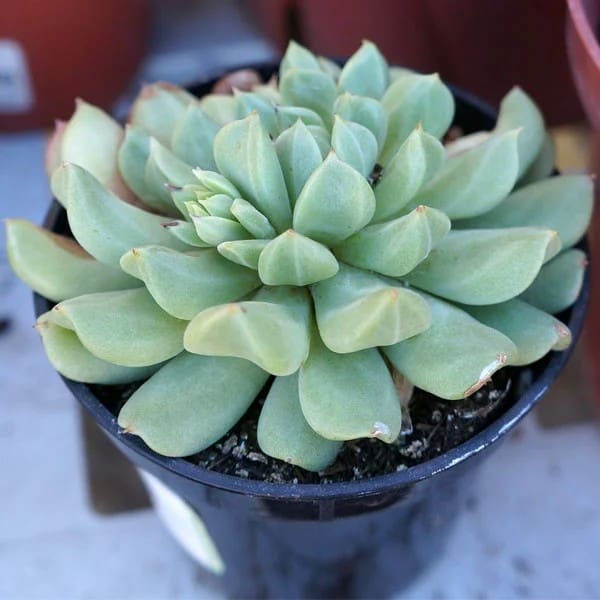
Echeveria ‘Irish Mint’ is the resulting offspring of Echeveria derenbergii and Echeveria runyonii ‘Topsy Turvy.’ The plant can be identified by its bright mint green leaves that have a distinct tubular shape and grow in an upswept pattern. It tends to grow to about 6 inches (15 cm.) in height.
Like most Echeveria plants, it will readily produce pups that can be separated and started as their own plants. It will sometimes produce showy orange flowers that are known to attract hummingbirds if the plants are kept outdoors.
Echeveria juarezensis
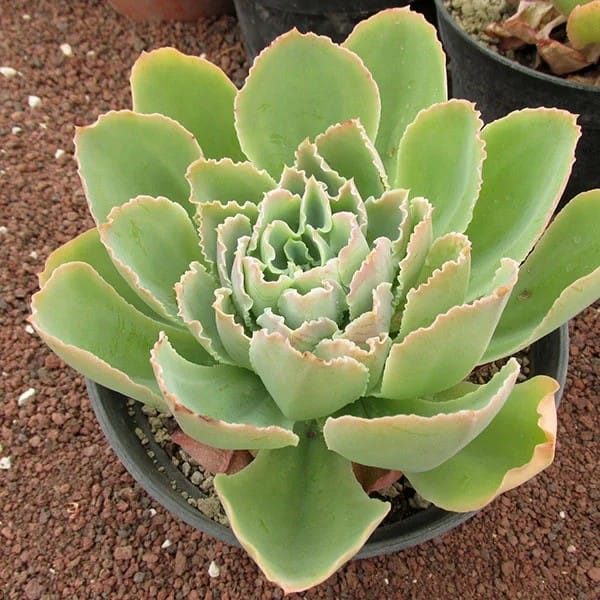
Echeveria juarezensis (Juareze Hens and Chicks) is an attractive rosette-forming plant to 10 inches, sometimes solitary and at other times in clumps.
Echeveria kimnachii
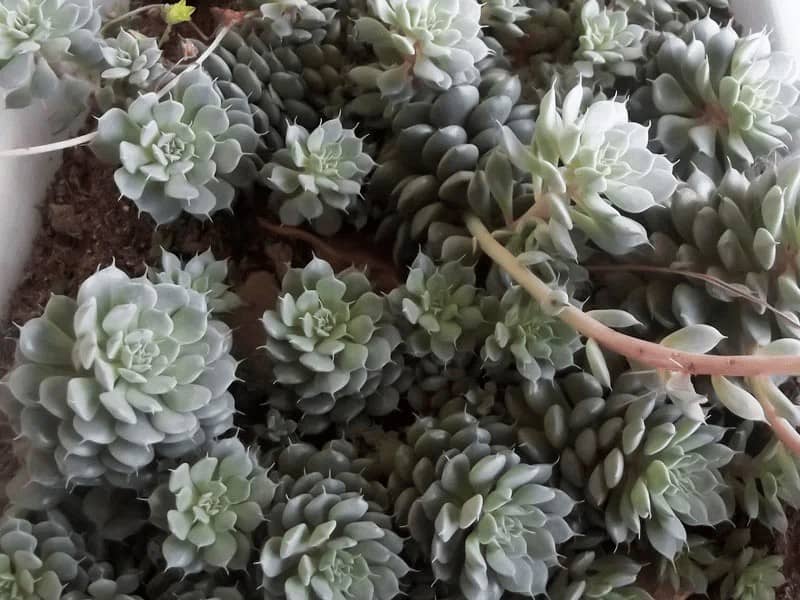
Echeveria kimnachii forms a single rosette up to 4.5 cm in diameter and up to 5 cm in height. Its leaves are bluish-green to green, with rounded margins and convex on both sides. It sends off 1 – 4 long flowering spikes bearing loose clusters of small, greenish to yellow with longitudinal reddish stripes flowers.
Echeveria laui
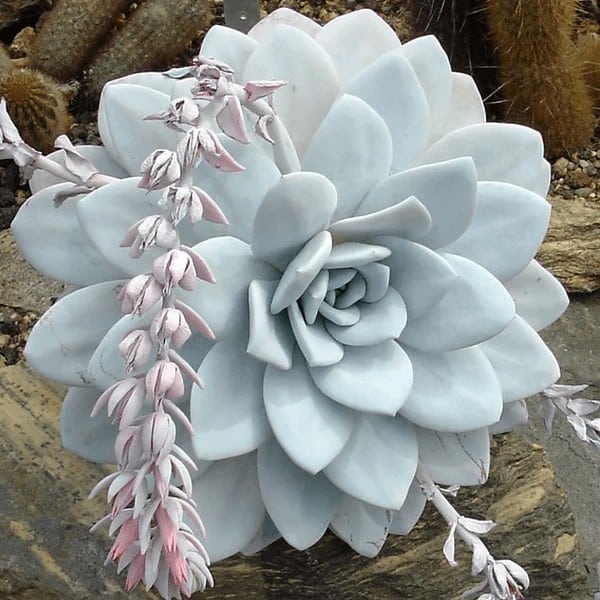
Echeveria laui is one of the most attractive Echeveria types. It is a very slow-growing and highly sought-after species with blue-grey-white powdery leaves and peachy-rose flowers, growing to 15cm but may take many years. The rosettes are up to 5 inches (12.5 cm) in diameter. It is very symmetrical and pretty whether or not it is in flower.
Echeveria leucotricha
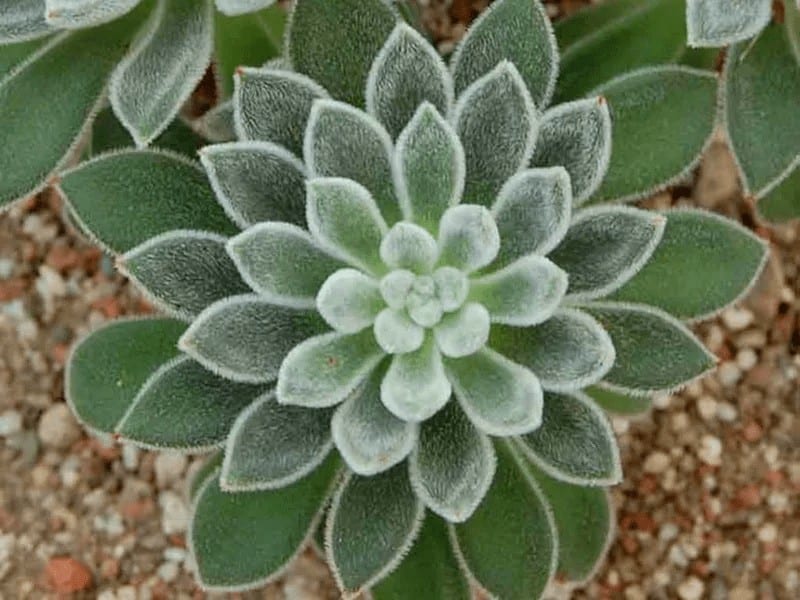
Echeveria leucotricha, also known as Echeveria pulvinata var. leucotricha, is a branching ornamental, succulent subshrub. It can grow up to 15 cm (6 inches) tall. The leaves are densely covered with silver hairs which become brown at the leaf tips. The flowers are red in color.
Echeveria lilacina
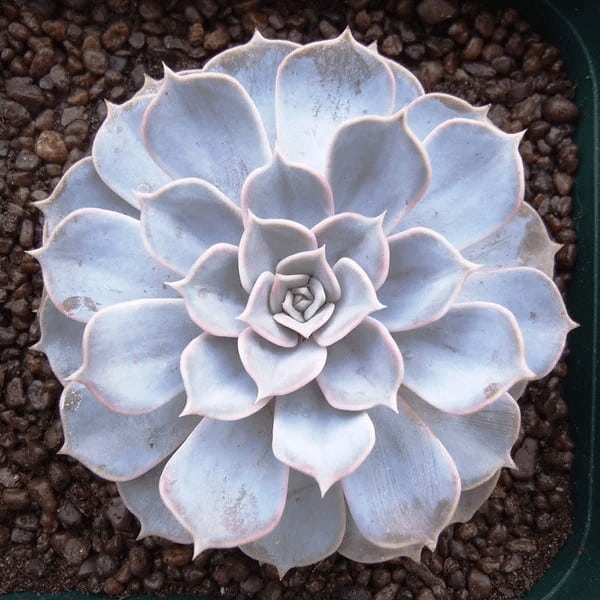
Echeveria lilacina, also known as Ghost Echeveria, is an attractive, slow-growing Echeveria up to 6 inches (15 cm) tall. The leaves are fleshy, spoon-shaped, silvery-grey and arranged in a symmetrical rosette up to 7 inches (17.5 cm) in diameter. The flowers are pale pink or coral pink.
Echeveria ‘Lime n Chile’
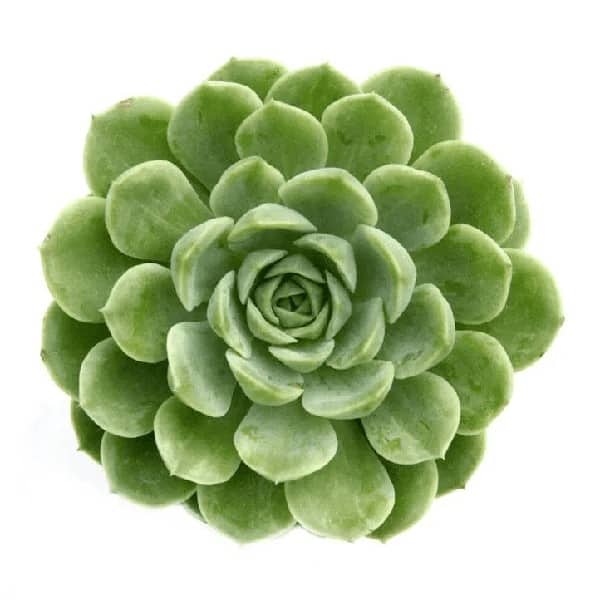
Echeveria ‘Lime n Chile’ is a succulent plant that forms frosty lime-green rosettes of chunky leaves. The tips of its leaves are often spicy pink-red to give it the perfect hint of color. It offsets prolifically to form attractive clusters. In the spring and summer, mature rosettes produce four to five inflorescences with bell-shaped, coral, and gold flowers.
Echeveria ‘Lola’
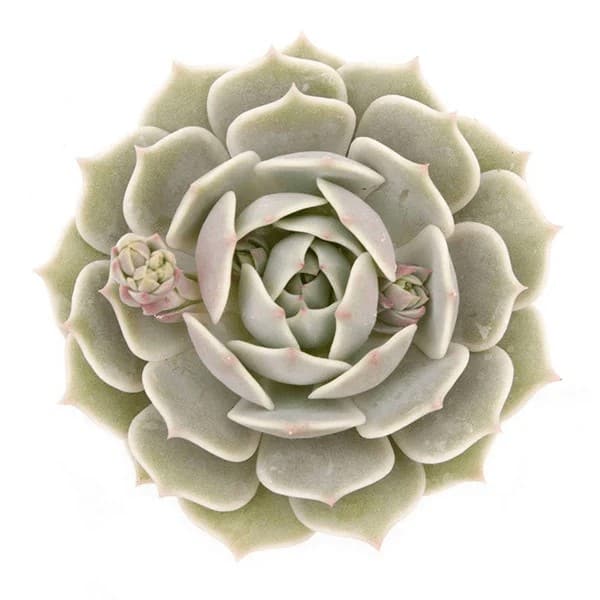
Echeveria ‘Lola’, the gorgeous result of the cross Echeveria lilacina and Echeveria ‘Deresina’, is a beautiful, succulent plant up to 6 inches (15 cm) tall. It forms a sculpted rosette, up to 6 inches (15 cm) in diameter, with a somewhat “rosebud” shape. The leaves are alabaster marble with a delicate blush of pinkish-violet and tipped with rose.
Echeveria longissima
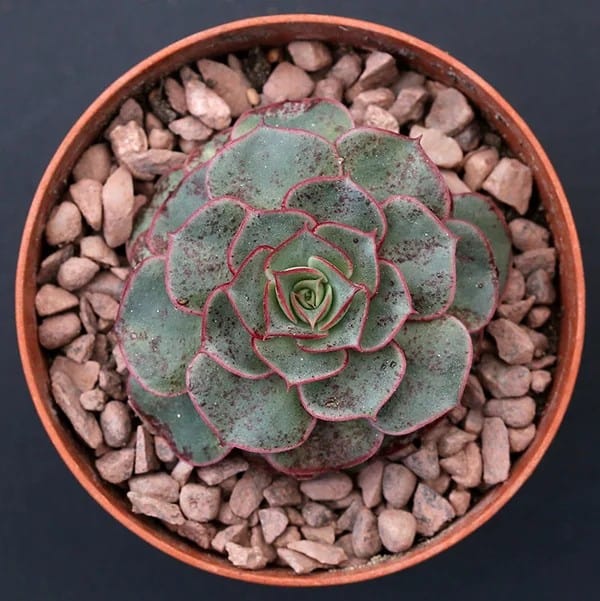
Echeveria longissima is a beautiful, succulent perennial with rosettes of green leaves with red margins. It has high level of red color to its leaves in good light. The leaves are up to 1.8 inches (4.5 cm) long and up to 0.8 inches (2 cm) wide.
The bell-shaped flowers are up to 1.2 inches (3 cm) long, light coral-red at the base, pale greenish-yellow in the middle and green at the apex. This beautiful and very sought-after Echeveria longissima rarely offsets and grows very slowly.
Echeveria ‘Lotus’
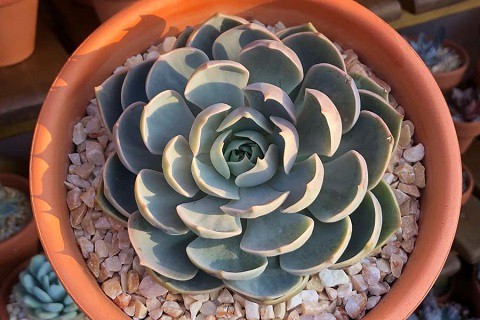
Echeveria Lotus is a succulent that belongs to the Crassulaceae family. These look very much like the other common types of succulents.
Echeveria lutea
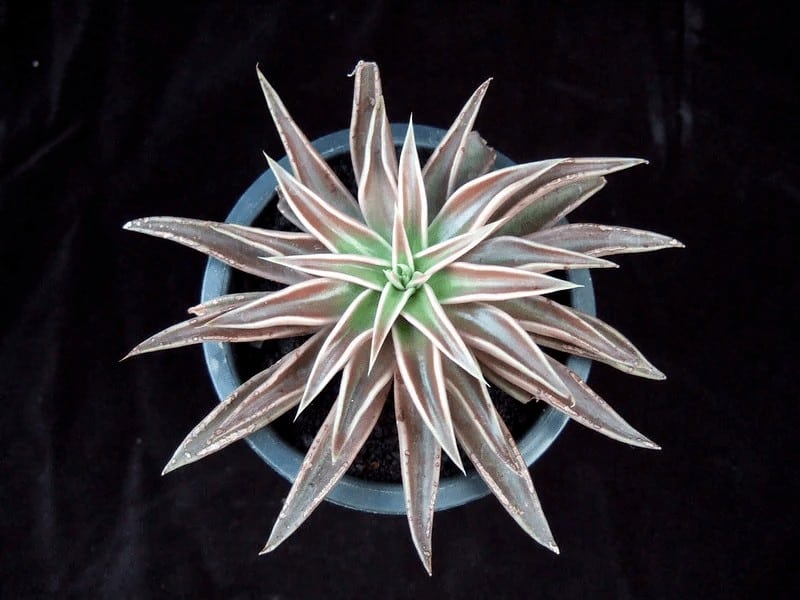
Echeveria lutea (also known as Yellow Echeveria) is a beautiful, small, solitary growing, succulent plant up to 8 inches (20 cm) wide, with narrow, up to 6 inches (15 cm) long, reddish-purple leaves that enroll at the margins, forming a deep hollow in the middle of the leaf on the upper surface with the green lower surface facing up, giving the plant a distinct bi-colored look.
This coloration and rolled leaf are most prominent when water-stressed or when grown in full sun. With regular irrigation shade-grown plants flatten out a bit and are greener. The unbranched flower inflorescence appears during summer and rises well above the foliage on a straight stalk and arches over towards the tip so that the clear yellow flowers point downwards.
Echeveria lyonsii
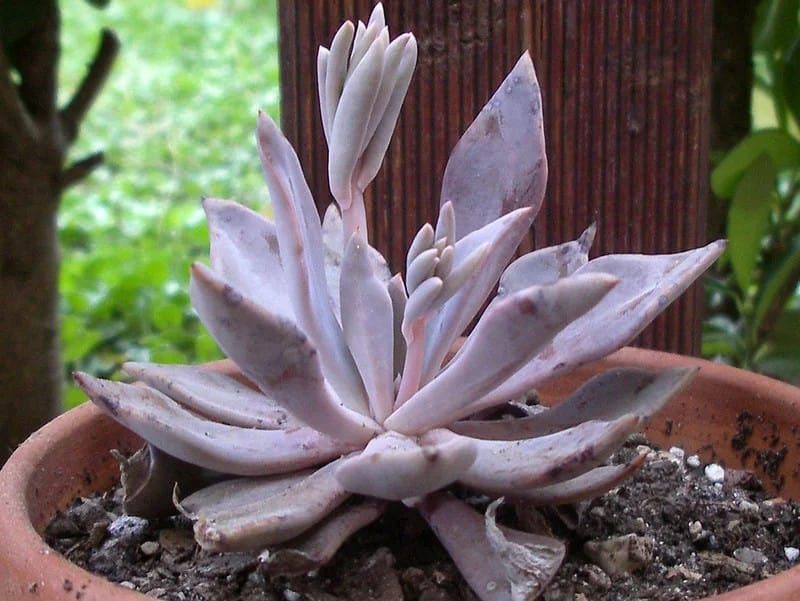
Echeveria lyonsii is a stemming succulent with purplish-gray, lightly glaucous leaves that form a rosette up to 11 – 14 cm wide. It appears to be related to Echeveria shaviana and Echeveria bifida.
Echeveria lyonsii is easily grown, offsets prolifically and can produce young plants from detached leaves or bracts. Its flowering stems are multiple and vigorous, sometimes weakening the plant during hot summers. The flowers are tiny and pinkish-orange.
Echeveria macdougallii
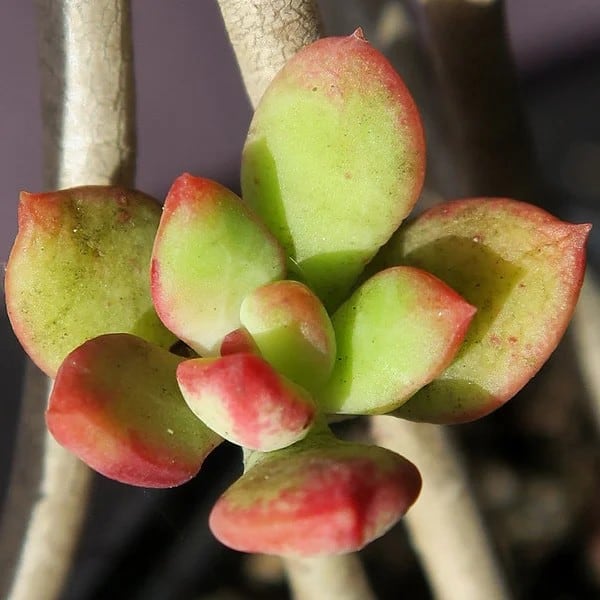
Echeveria macdougallii is an upright, succulent shrub, up to 12 inches (30 cm) tall, with small rosettes that grow on woody stems. The leaves are fleshy and similar to jelly beans. They are a soft, pastel green with oxblood-red at edges and apex when sun-tinged. Color can intensify in the cooler months. Flowers are peach-red to spectrum red on the outside, and lemon-chrome inside.
Echeveria Mahogany
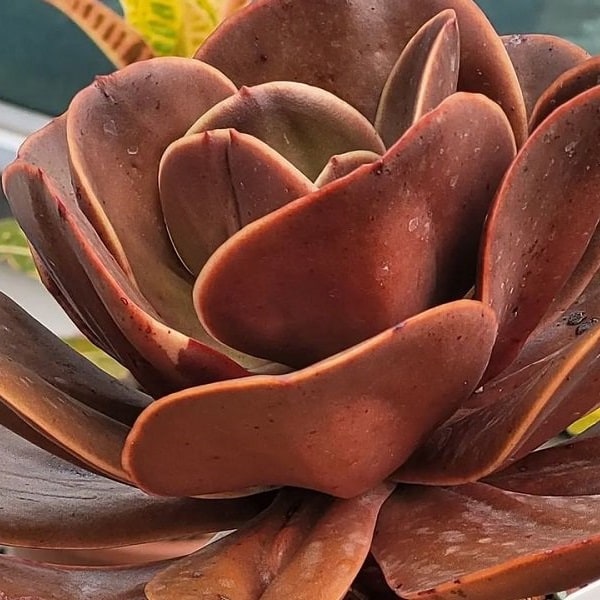
Echeveria Mahogany has rosettes that grow on a stem above the ground and have leaves that widen in breadth towards the top.
Echeveria maxonii
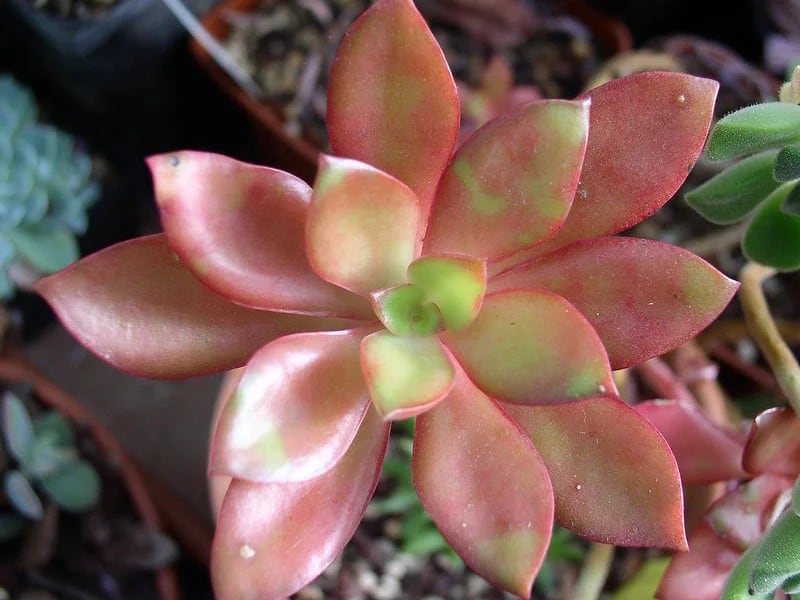
Echeveria maxonii is a glabrous, shrubby succulent with green leaves that turn red with purplish margins when stressed. Its flowers are salmon-pink in color.
Echeveria ‘Moondust’
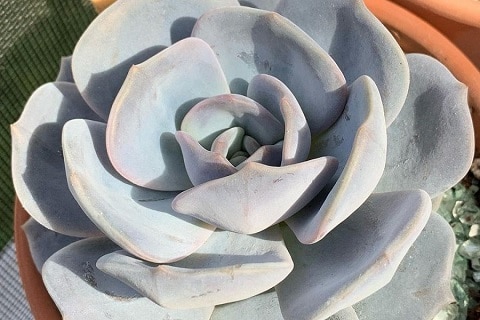
Echeveria Moondust is a hybrid created by Robert Grim between Echeveria laui and Echeveria lilacina. The rosettes are solitary and slow-growing, with leaves that are green in color.
Echeveria Morning Light
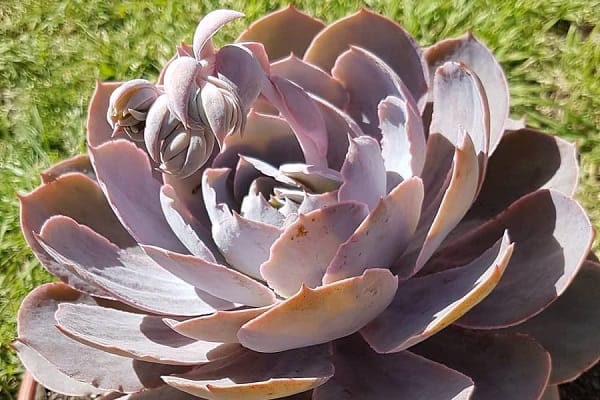
Echeveria Morning Light is a large succulent with vibrant colors and foliage. It is a hybrid between Echeveria cante and Echeveria shaviana that was produced by Don Worth and belongs to the Crassulaceae family.
Echeveria multicaulis
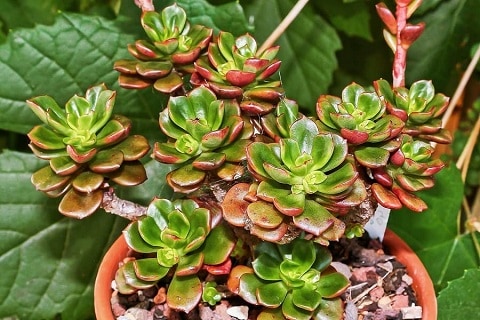
Echeveria multicaulis is a succulent that is commonly known as the Copper Rose, Copper Leaf and Copper Roses.
Echeveria multicolor
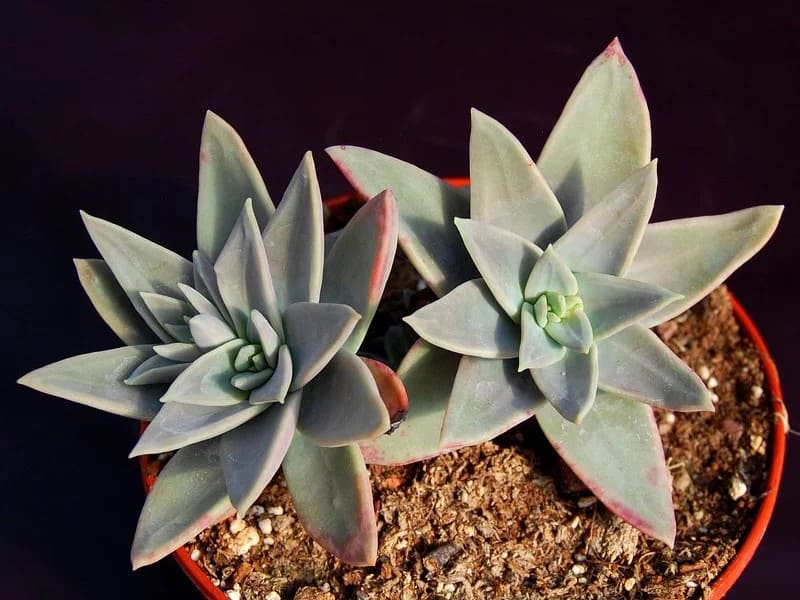
Echeveria multicolor, also Echeveria recurvata, is generally a stemless, rosette-forming succulent with pale medic blue-green leaves. In some cases, Echeveria multicolor has been noted to form vegetative stems up to 15 cm tall, and sometimes branched or with offsets at base.
Flowers are bright to dull yellow or pale orange, flushed with a little red in exposed areas outside.
Echeveria ‘Neon Breakers’
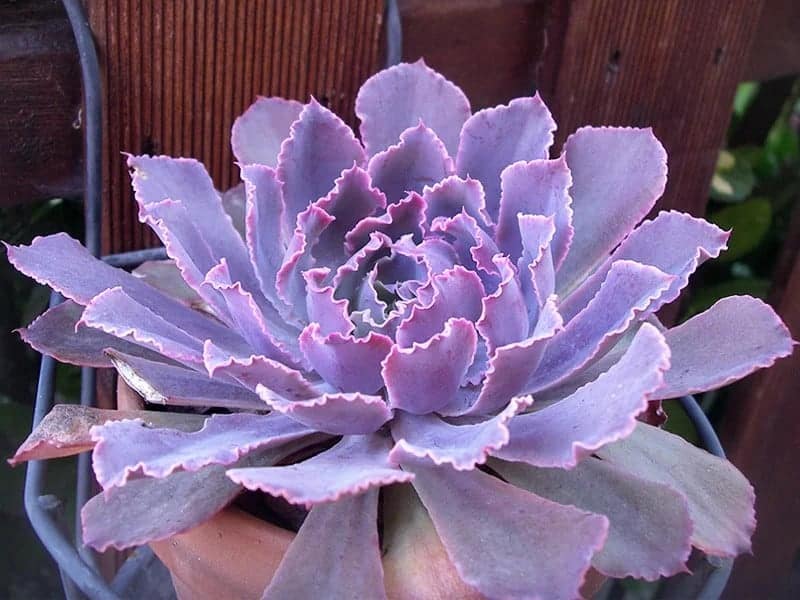
Echeveria ‘Neon Breakers’ is a rosette-forming succulent with wavy, crinkled edges that are an unusual leaf texture, unlike other Echeveria. Its rosettes can grow up to 8 inches (20 cm) in diameter. A real standout, this rosette can show shades of pink, purple, and blue-green.
It has distinctive leaf edges that are hot pink and crinkled. In the spring and summer growing season, it can send up tall, purple bloom stalks with vibrant pink flowers. Grow this one in bright sunlight for color and prepare to be amazed.
Echeveria nodulosa
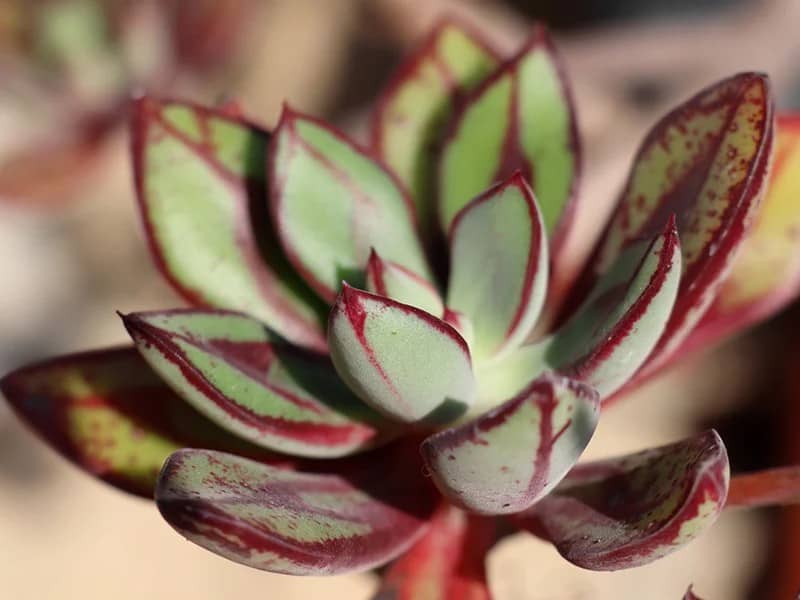
Echeveria nodulosa (Painted Echeveria) is an attractive succulent with branched, up to 2 feet (60 cm) long stems and rosettes up to 5 inches (12.5 cm) in diameter. The leaves are olive green and marked with vivid red coloring on the margins and in the center.
In summer, a 2 ft. tall flowering spike (60 cm), bearing pale yellow flowers with pinkish-red markings, emerges above the rosettes. Like Hen & Chicks Sempervivum, this Echeveria forms a central rosette of foliage surrounded by many offsets. A great choice for sunny gardens or containers.
Varieties of Echeveria nodulosa:
Echeveria Benitsukasa (Echeveria nodulosa ‘Maruba Benitsukasa’)
Echeveria nuda
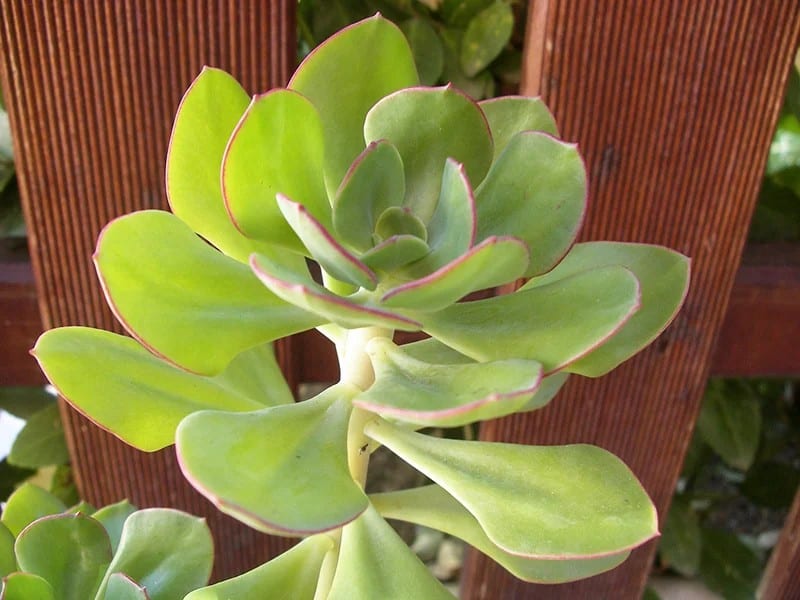
Echeveria nuda is a branch-forming species that can grow up to 30cm tall in ideal conditions and has attractive yellow flowers.
Echeveria oreophila
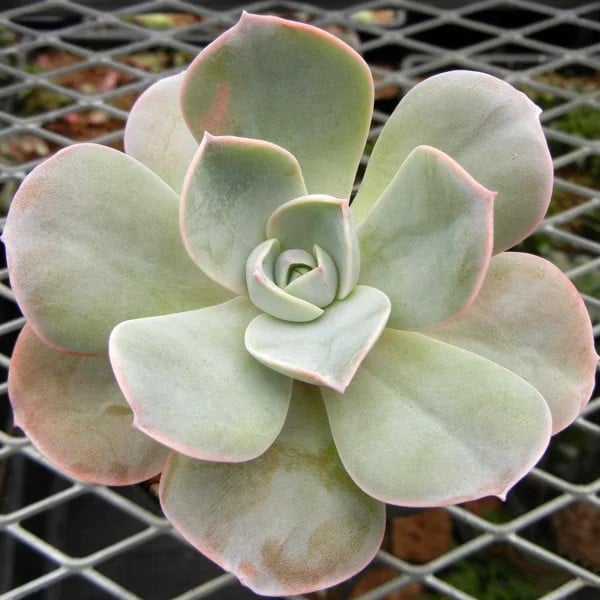
Echeveria oreophila is a glabrous succulent that stems up to 15 cm in height and forms rosettes up to 11 – 15 cm wide. Its leaves are pale green with a sparse glaucous bloom, margins and exposed portions reddened in strong light. Its flowers are uniformly rosy red and slightly glaucous.
Echeveria pallida
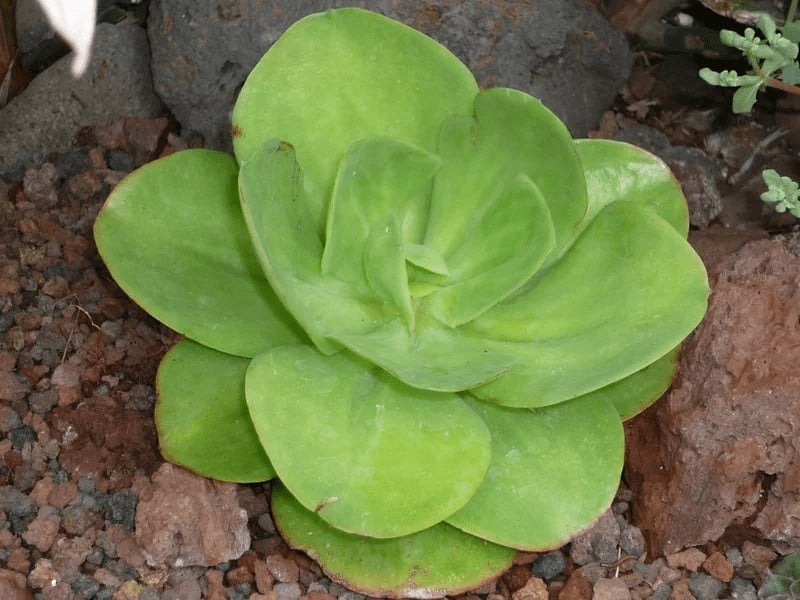
Echeveria pallida is a fast-growing succulent plant, up to 20 inches (50 cm) tall. Lax rosettes are up to 10 inches (25 cm) in diameter, on an unbranched stem, up to 1.2 inches (3 cm) in diameter. Leaves are spoon-shaped, lime-green to yellow, with edge lightly glaucous. The flowers are scarlet to pink and appear in winter on an up to 3 feet (90 cm) tall inflorescence.
Echeveria paniculata var. maculata
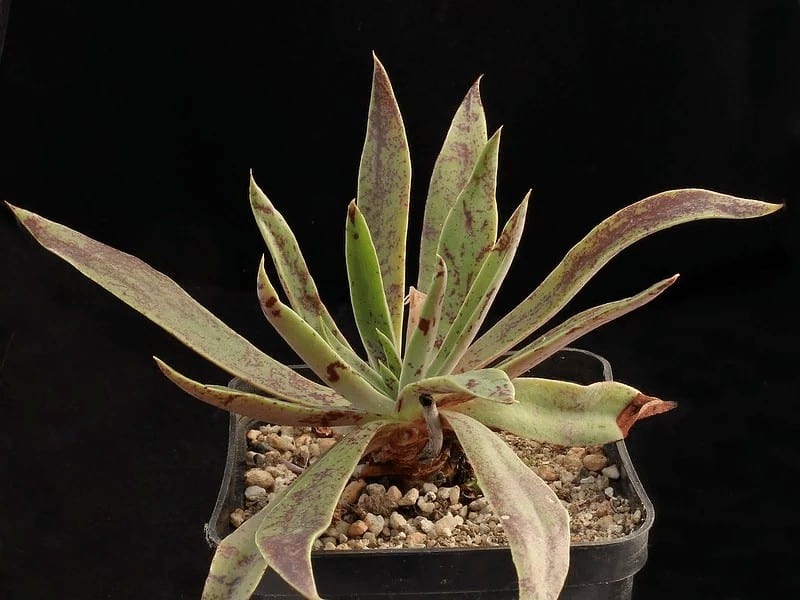
Echeveria paniculata var. maculate is a stemless, glabrous, rosette-forming succulent with long (about 10 cm), thick, and mottled leaves. Its flowers are pale lemon-yellow and appear at the end of long, stout stalks.
Echeveria patriotica
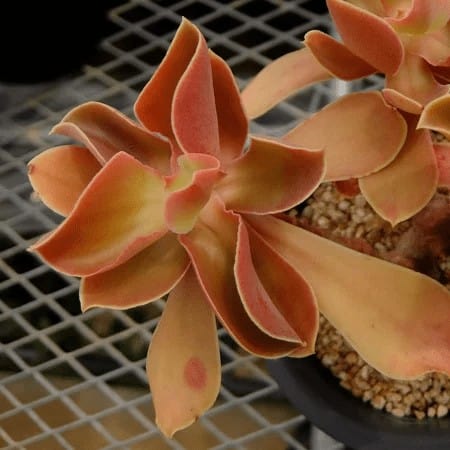
Echeveria patriotica is an orange/apricot succulent that grows up to 30 cm in height. Its bloom color is a mix of coral, red-orange and pale yellow.
Echeveria ‘Paul Bunyan’
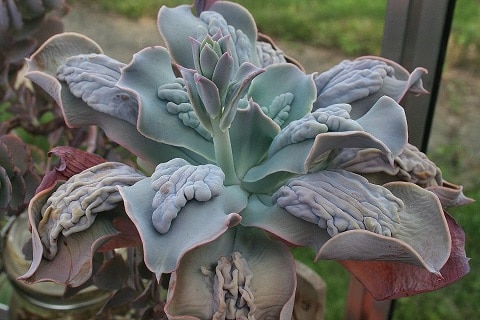
Echeveria Paul Bunyan is a succulent that belongs to the Crassulaceae family of plants. It is a hybrid between Echeveria gibbiflora ‘Carancutula’ and Echeveria ‘Edna Spencer’ as described by Dick Wright.
Echeveria peacockii
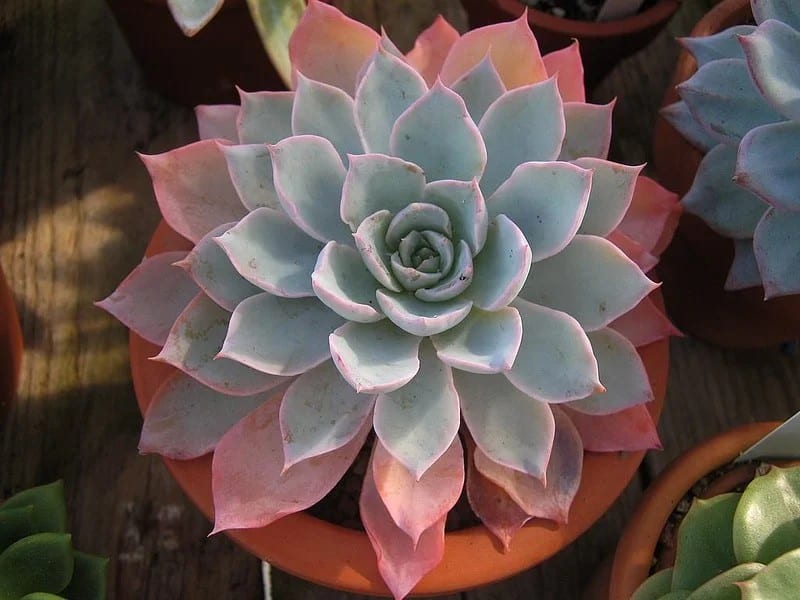
Echeveria peacockii (Peacock Echeveria) is an evergreen succulent with pretty rosettes, 6 in. wide (15 cm), packed with over 20 spoon-shaped, pointed, pale powdery blue-gray leaves adorned with red edges and tips when exposed to bright light.
This variety can show slight ridges along the middle of its leaves and has a thick, powdery coating of farina (epicuticular wax) that protects it from the sun in the hot sun of its native Mexican habitat.
In summer, it sends up a 10 in. tall stem (25 cm) which bears lantern-shaped, coral to pinkish flowers. This Echeveria offsets readily and will form a dense carpet of rose-like rosettes over time.
Echeveria penduliflora
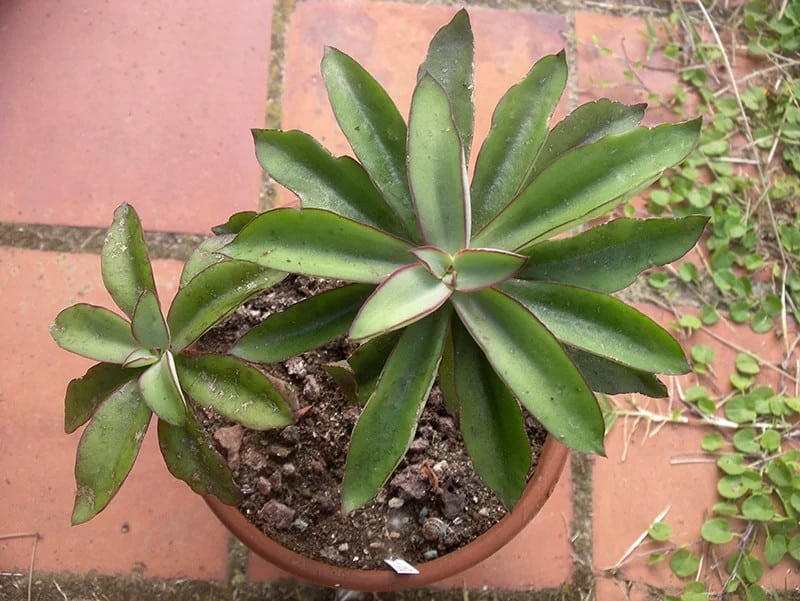
Echeveria penduliflora is a shrubby and glabrous succulent, growing up to 30 cm in height. Its leaves are green and scattered to subrosulate. When mature, it sends up a 30 cm tall stalk that bears bluntly pentagonal, pinkish-red flowers.
Echeveria ‘Perle von Nurnberg’
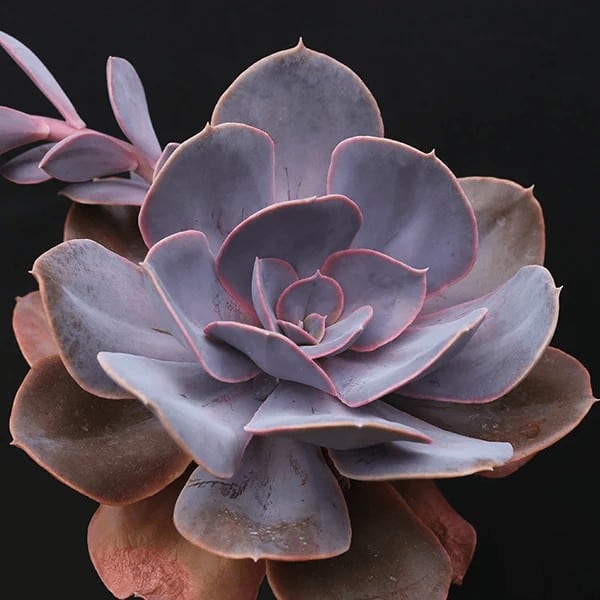
Echeveria Perle von Nurnberg’ is a hybrid of Echeveria gibbiflora ‘Metallica’ and Echeveria elegans. Among the most popular Echeveria varieties with florists, ‘Perle von Nurnberg’ is a small evergreen succulent of breathtaking beauty.
It forms a solitary rosette of fleshy, rounded, pointed, pastel gray leaves adorned with purplish-pink highlights. Its leaves have an elegant curve to them and a coating of farina gives them a soft sheen. It can grow to about 6.0″ wide if given plenty of sunlight and great drainage.
This variety is one of the most prolific Echeveria types, often sending up 5 or 6 flowering spikes of coral-pink flowers per year.
Echeveria pilosa
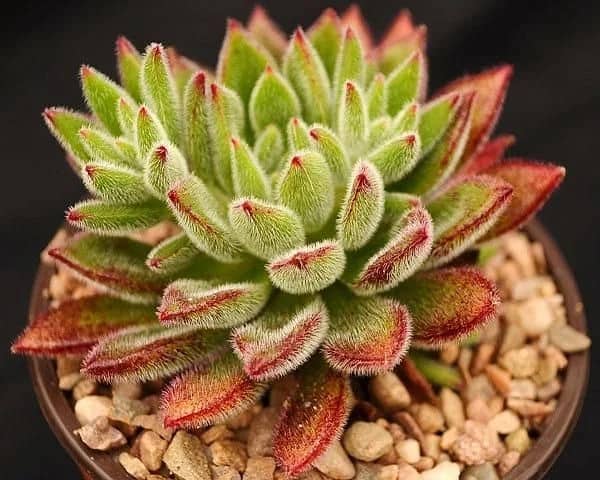
Echeveria pilosa is a beautiful succulent that forms rosettes of green leaves that turn reddish at the tips when exposed to full sun. Stems are erect, simple or rarely branched and up to 3.2 inches (8 cm) tall. The beautiful Echeveria pilosa has attractive hairs on all of its leaves.
Flowers are orange-red with a yellow tip, bell-shaped, and usually appear in summer at the end of a leafy, up to 1 foot (30 cm) tall flower stalk. Echeveria pilosa is similar in appearance to Echeveria coccinea, but it has shorter stems and a branched cluster of flowers.
Echeveria pinetorum
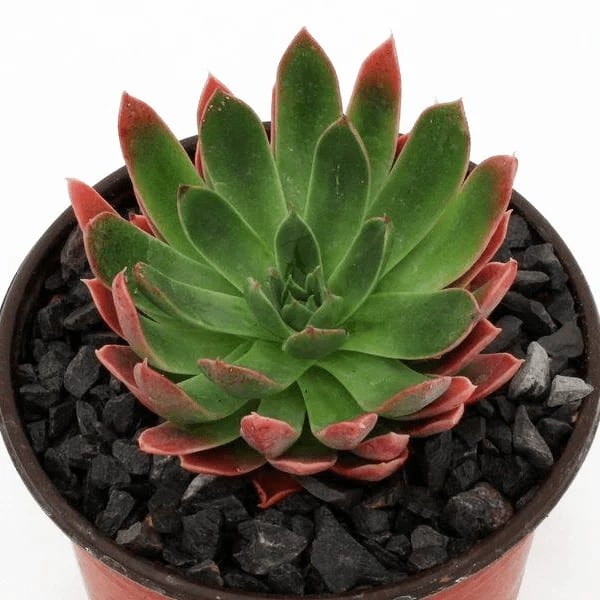
Echeveria pinetorum is a stemless succulent with densely-formed rosettes of bright-green leaves tinged with red at the margins. Its apricot-yellow to scarlet flowers sit above a 10-25 cm long flowering stem.
Echeveria ‘Pink Champagne’
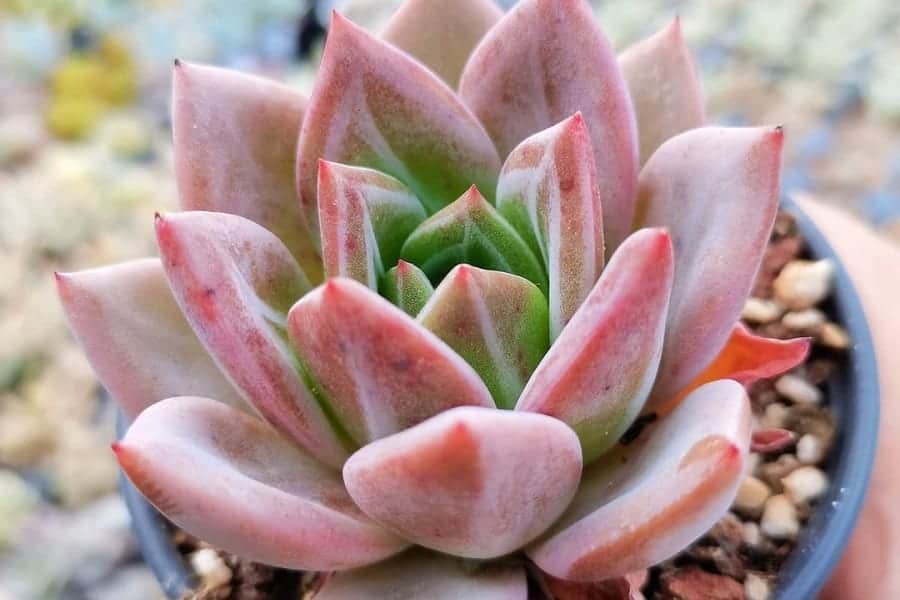
Echeveria Pink Champagne is a Korean hybrid succulent that grows slowly and has rosettes that can grow up to 10 inches in diameter. The leaves are thick and have a small, sharp tip at the top. The leaves are green with tinges of silvery-grey and pink in color.
Echeveria ‘Pollux’
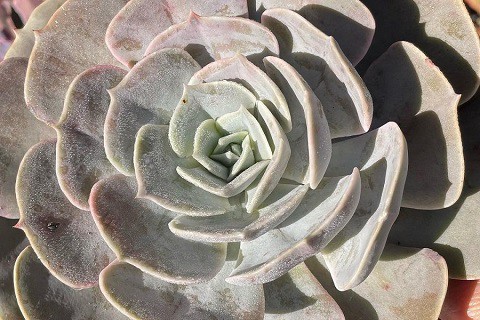
Echeveria Pollux is a hybrid of unknown parentage. The rosettes of this plant have leaves that are grey, silver and lilac in color. This succulent can grow up to the size of 8 inches in diameter.
Echeveria prolifica
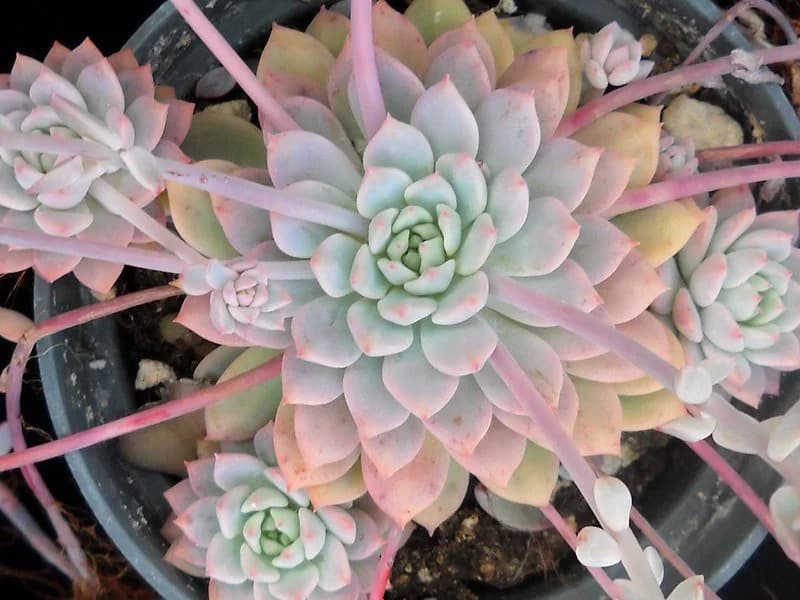
Extraordinarily prolific, Echeveria prolifica is a small, clustering succulent with rosettes, up to 1 inch (2.5 cm) in diameter, of silvery-green leaves that form dense, low mats.
In early spring and sometimes until summer appear the small, bell-shaped flowers with short, broad (for the genus), yellow petals that are held in compact clusters at the end of decumbent, up to 10 inches (25 cm) long stems. These inflorescences also have thick, leafy bracts that fall off and root easily.
Echeveria prunina
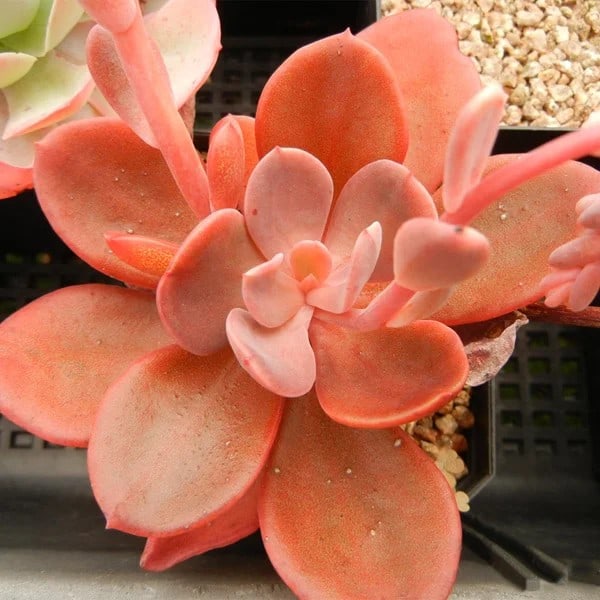
Echeveria prunina is succulent with stems about 10 cm high and rosettes up to 14 – 15 cm wide. Its leaves are violet and full of farina when young, and reddish-green with no farina when older. Its pink flowers sit above long, violet stems of about 19 – 24 cm in length.
Echeveria pulidonis
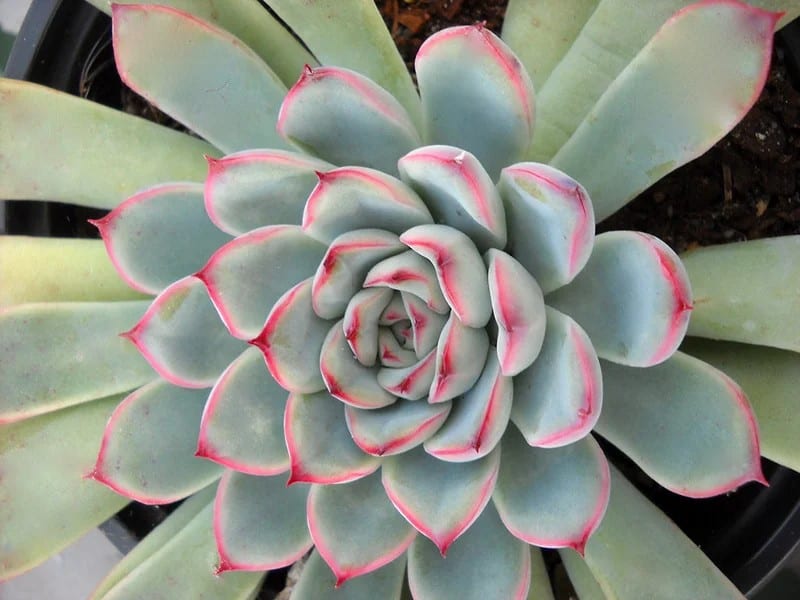
Echeveria pulidonis is a slow-growing succulent with blue-green, oblong leaves that are slightly cupped to form a tidy rosette, 4-5 in. wide (10-12 cm). When grown in bright sunlight, the leaf edges have a fine, crimson outline that contrasts well with its soft blue tones.
It sends up a tall bloom stalk from which dangle butter yellow, bell-shaped flowers. It offsets readily and will form a good-sized clump over time.
Echeveria pulvinata
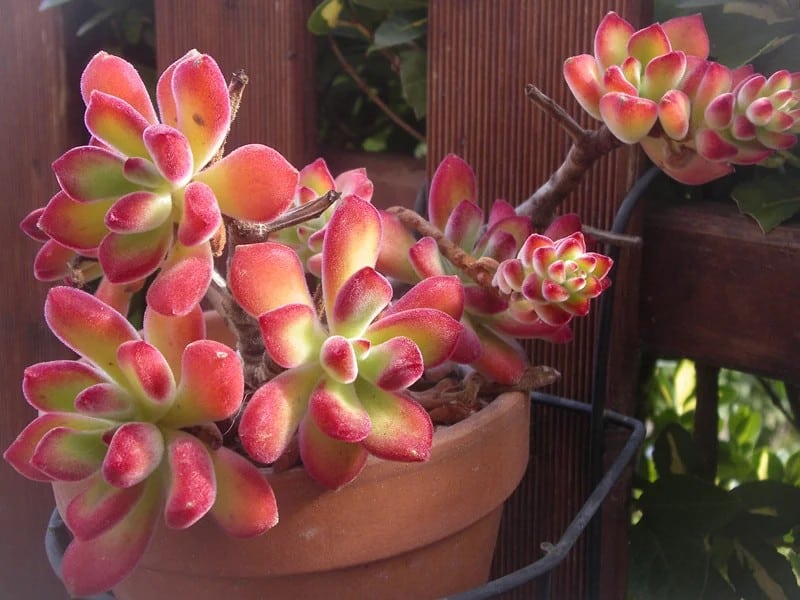
Echeveria pulvinata, also known as Echeveria Red Velvet, is an attractive shrubby succulent that grows up to 12 inches (15 cm) tall and sprawls to several feet in width. The stems are tipped with small rosettes of thick, spathulate, green leaves with all parts densely covered with white hairs (similar to Echeveria setosa) which help protect them from the harsh rays of the sun.
In late winter into spring (sometime later) appears the arching, 1 foot (30 cm) tall inflorescence holding racemes of yellow and orange, bell-shaped flowers.
Varieties of Echeveria Pulvinata:
Echeveria Pulvinata Ruby
Echeveria Devotion
Echeveria Pulv-Oliver
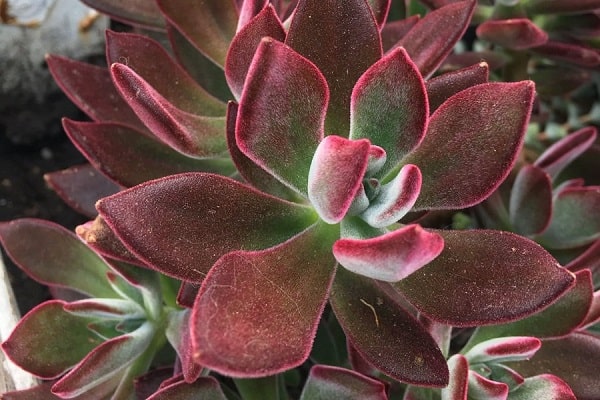
Echeveria Pulv-Oliver is a succulent that is commonly known as Red Echeveria. The flowers that bloom on this plant appear orange from the outside and yellow from the inside. This succulent is a hybrid of two plants, namely, Echeveria pulvinata and Echeveria harmsii.
Echeveria purpusorum
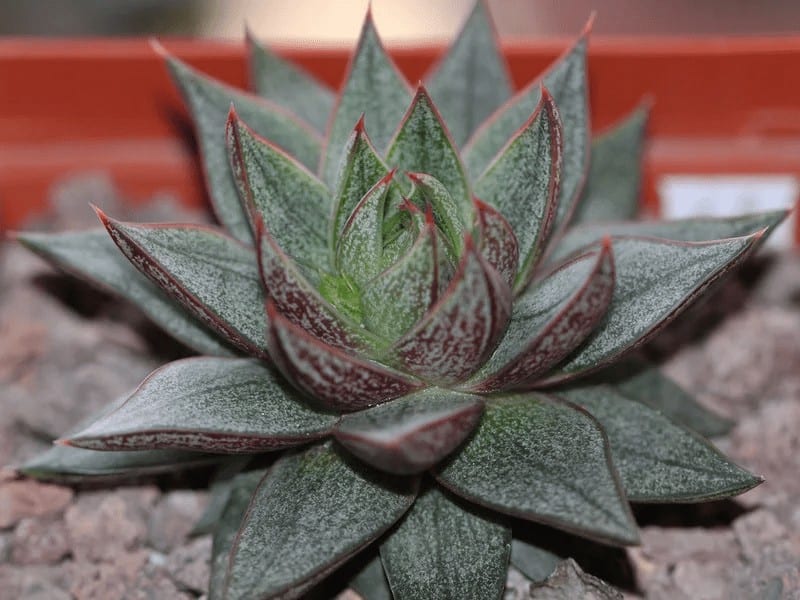
Echeveria purpusorum is one of the slowest-growing Echeveria types and it is necessary to cultivate it for many years to get a nice specimen. It has glabrous, stem-less, succulent rosettes, up to 6-8 cm in diameter and height, and usually stays solitary but sometimes offset to form a dense clump.
Its attractiveness lies in the beautifully speckled leaves; the ground color of the leaves is a deep olive green with grey-green or white-green spots and mottled with irregular markings of reddish-brown.
Echeveria quitensis
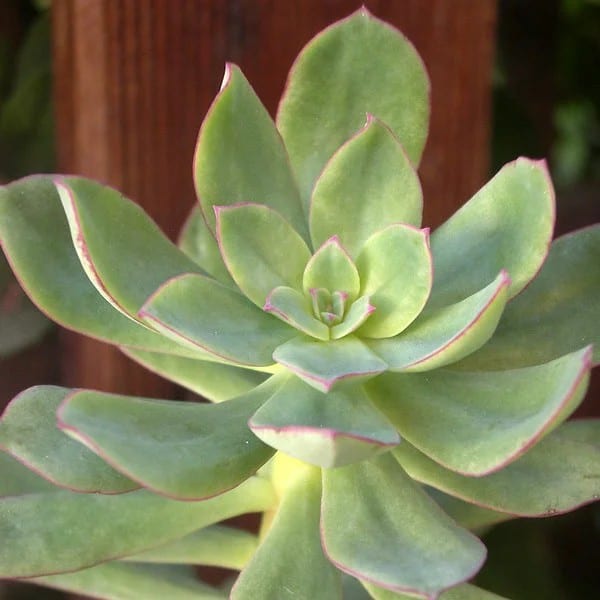
Originating from eastern South America, Echeveria quitensis is a branching succulent that grows up to 20 – 40 cm tall; its leaves are gray-green to bluish with bright red margins. It generally loses all its lower leaves as it grows, developing a long stem that adds to its appeal. Its flowers are a combination of yellow and scarlet.
Echeveria racemosa
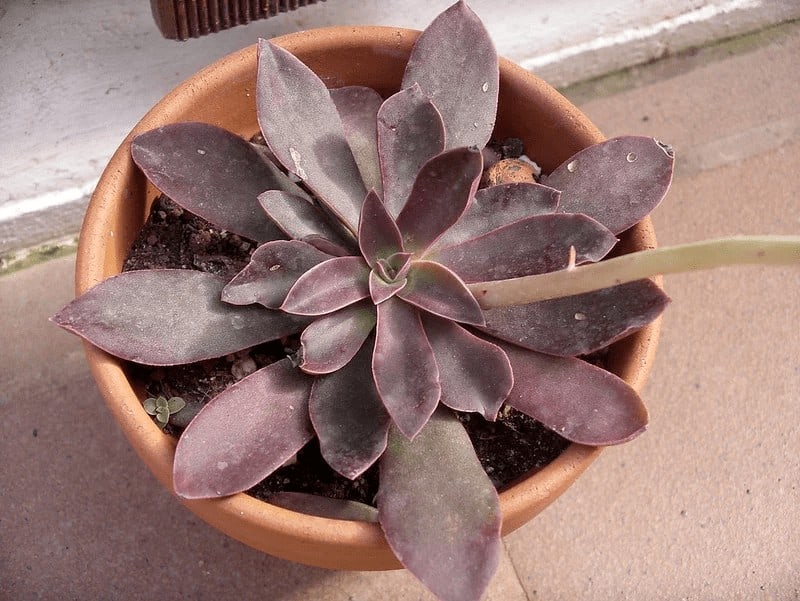
Echeveria racemosa is a sparsely branching succulent with short stems and leaves that are green to reddish-brown and slightly glaucous. Its small flowers are bright red and sit above a 30 – 50 cm inflorescence.
Echeveria Raindrops
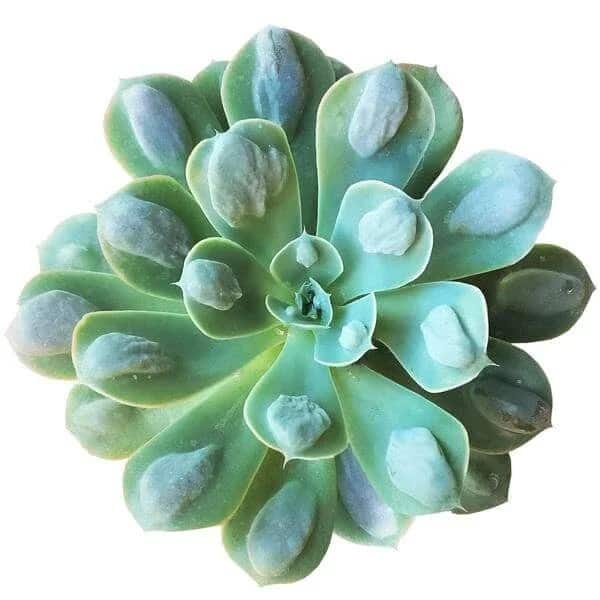
Echeveria Raindrops is an unusual succulent that has little globular bumps near the tips of its light green leaves. The outdoor shade will produce the best bumps, but the direct sun will tinge the bumps and margins a lovely shade of pink. The rosette can grow up to 6.0″ in diameter and produces few offsets.
Echeveria ‘Ramillette’
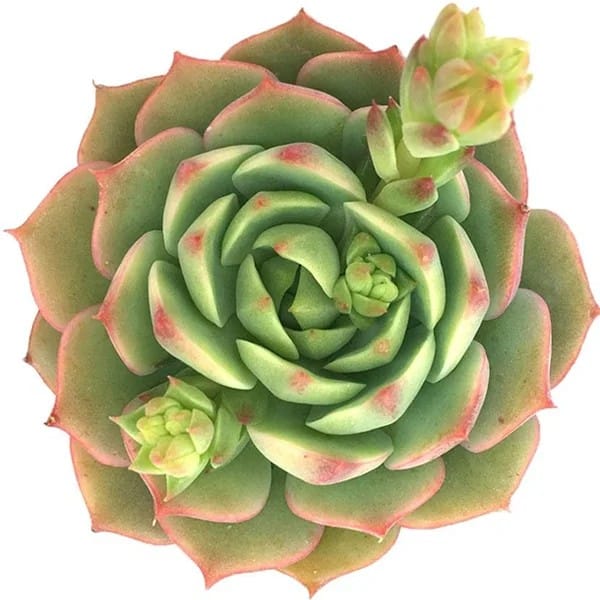
Echeveria ‘Ramillete’ is a small succulent that forms rosettes, up to 4 inches (10 cm) in diameter, of fleshy, frosty green leaves with red tips when temperatures get cool. This variety is known for producing crested forms. It’s an exuberant bloomer and produces short racemes of bell-shaped, yellow-orange flowers in winter and early spring.
Echeveria reglensis
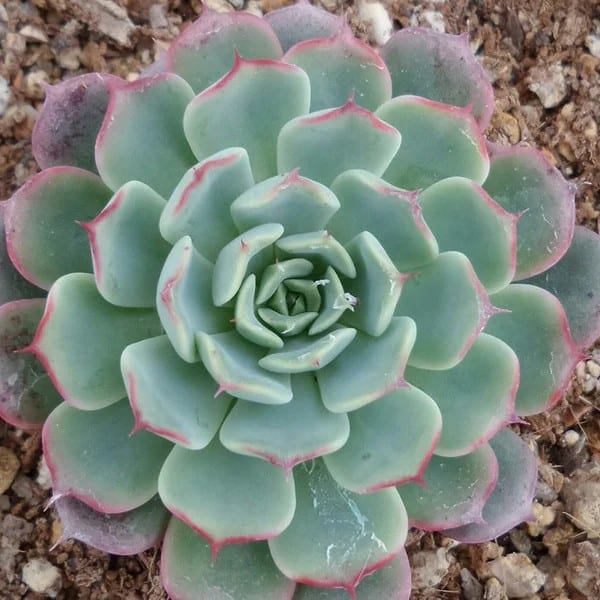
Echeveria reglensis is a stemless, dense rosette-forming succulent with 25 or more mucro red leaves that are upcurved and thick. It blooms from June onwards with scarlet and apricot-yellow tiny flowers at the ends of 2 to 3 slender, tall inflorescences.
Echeveria rosea
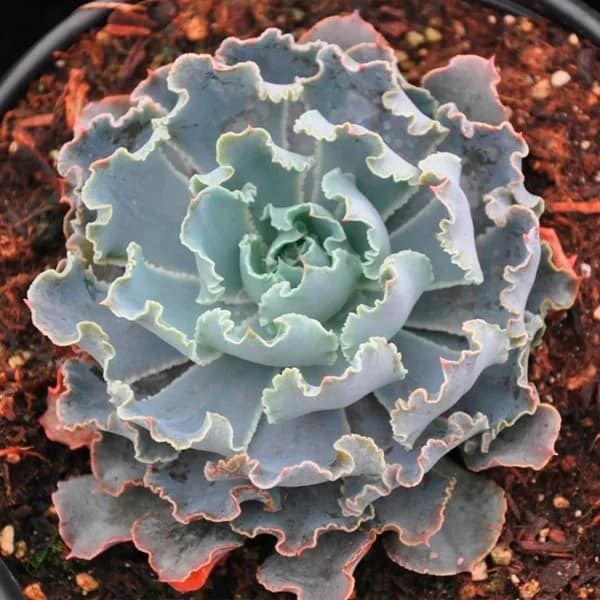
Echeveria rosea is a very slow-growing succulent that forms gray-blue rosettes with crinkly soft pink edges. Pink flowers bloom from spring to summer. This variety is native to Mexico where it grows naturally as an epiphyte (a plant that grows non-parasitically on another plant).
Echeveria rubromarginata
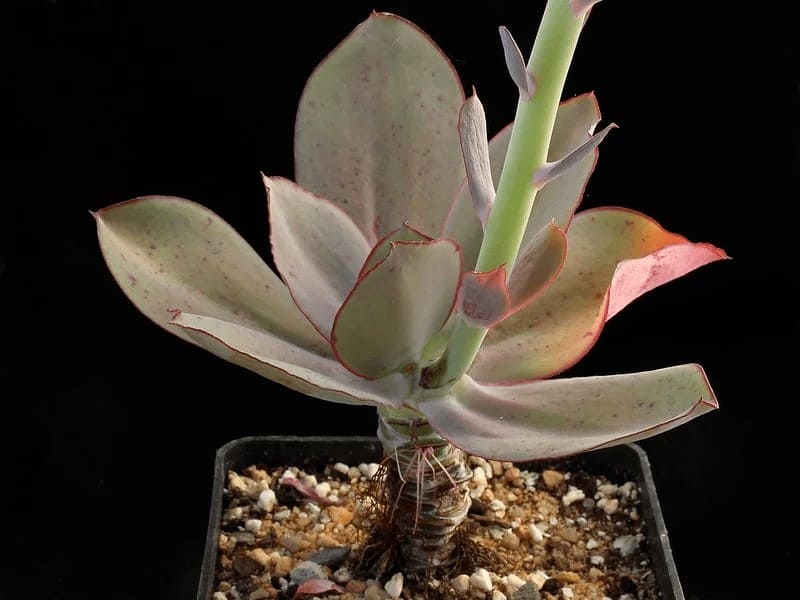
Echeveria rubromarginata is a slow-growing and unusual species. It has succulent rosettes, up to 25 x 30 cm in diameter and height, and usually stays solitary but occasionally offsets to form a small clump.
Its leaves are silvery-grey to pale green (slightly glaucous), with pink to purple-red slightly wavy margin while its flowers are red on the outside and yellow on the inside.
Echeveria Ruffles Red
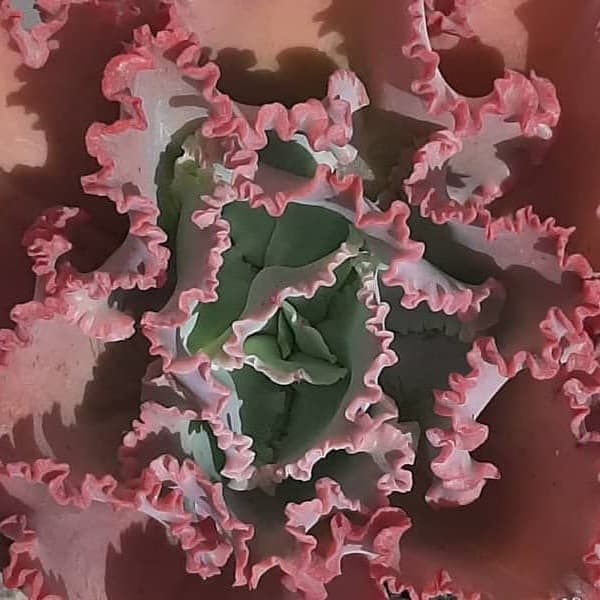
Echeveria Ruffles Red is a hybrid and has a distinct appearance. The rosettes are open and have leaves that have frilly leaves that are large in size. The leaves get wider towards the top and sometimes have bumps as well. The leaves have a shade of burgundy and orange.
Echeveria ‘Rundelli’
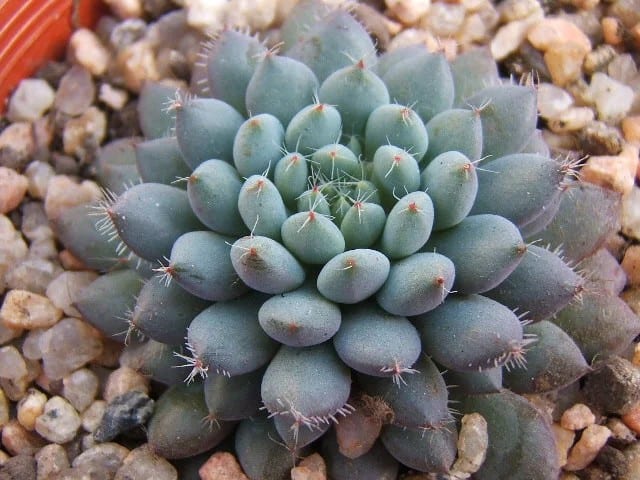
Echeveria Rundelli (also known as Echeveria setosa var. deminuta), popular also as ‘Firecracker Plant’, is a very distinct Echeveria, with a remarkable pubescence. It is a very variable slowly clustering rosette succulent freely giving off offsets from the base and readily forming dense mounds.
Many varieties and cultivars – often quite different at a first glance – are nowadays available in cultivation. It is almost stemless, its leaves are dark-green that in the winter assumes a green-red coloring and almost glabrous to very furry with stiff, glistening hairs.
In Spring and early Summer, the flowers are red and yellow on simple or 2 branched second cincinni.
Echeveria runyonii
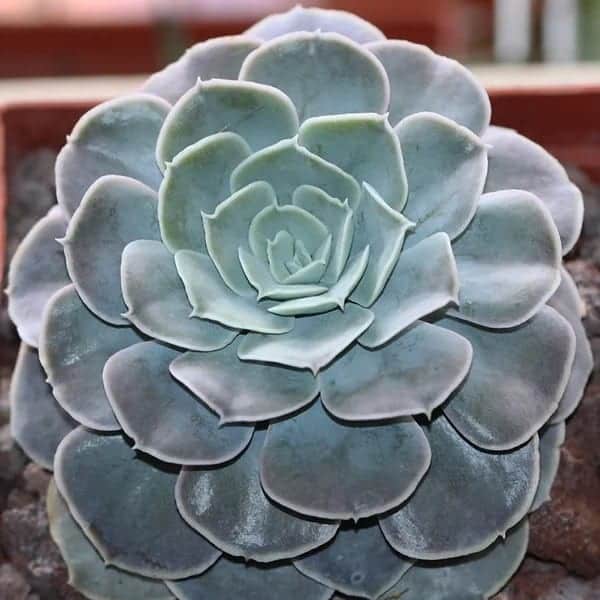
Echeveria runyonii is a fast-growing, rosette-forming succulent that grows up to 4 inches (10 cm) tall and about the same in diameter. Leaves are silvery-grey to pinkish-white, up to 3.2 inches (8 cm) long, and up to 1.6 inches (4 cm) wide. Flowers are bright orange and yellow and rise above the foliage on up to 8 inches (20 cm) long, arching inflorescence, usually in late summer or fall.
Echeveria runyonii ‘Topsy Turvy’
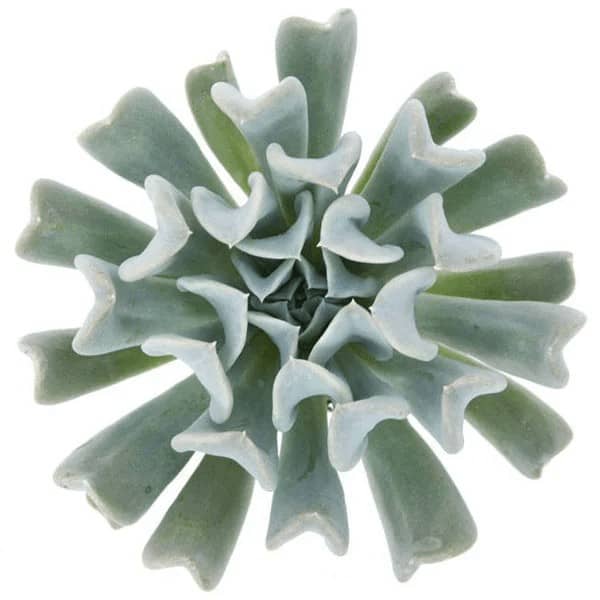
Echeveria runyonii ‘Topsy Turvy’ is a fast-growing succulent with stemless rosettes (4 in. wide or 10 cm) of waxy, spoon-shaped, powdery blue-gray leaves which are interestingly rolled downwards along their length, and curled up so that the tips point toward the center of the plant.
In late summer or fall, it sends up 8 in. tall (20 cm) arching stems which bear star-shaped, yellow and orange flowers. This Echeveria offsets readily and will form a dense carpet of rosettes over time.
Echeveria ‘Sanyatwe’
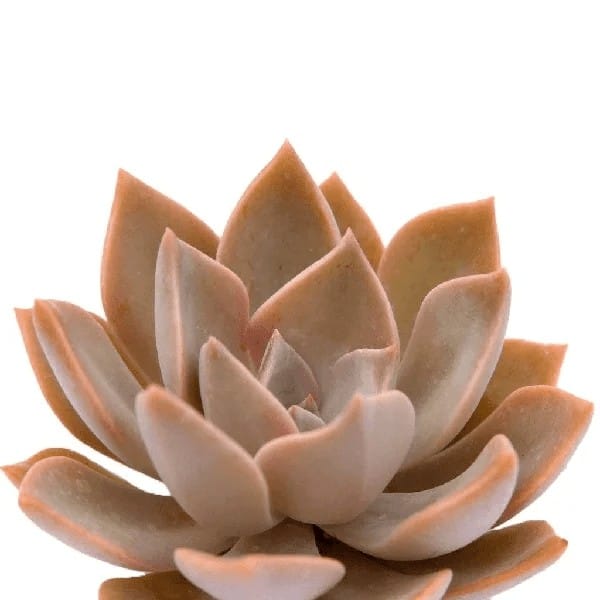
Echeveria ‘Sanyatwe” is a rosette-shaped succulent with powder-peach/blush leaves. It grows to 8-10 inches in height and width and produces pink flowers.
Echeveria sayulensis
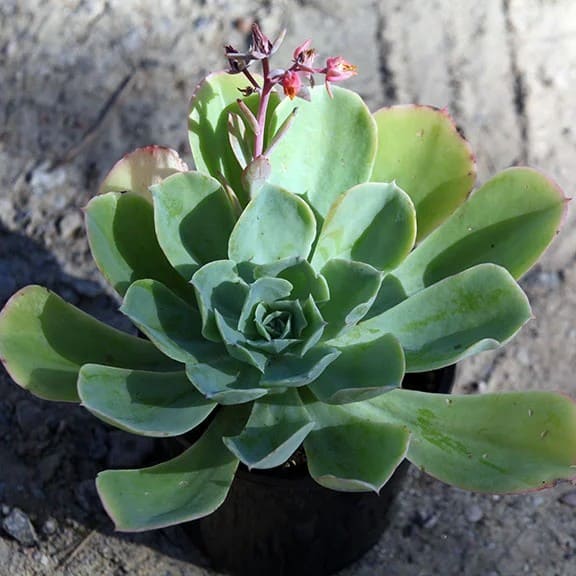
Echeveria sayulensis is a hybrid succulent between Echeveria secunda and Echeveria gibbiflora. It has bluish-green leaves that get tinged with yellow and red when stressed. Flowers are pink on the outside and yellow on the inside.
Echeveria secunda
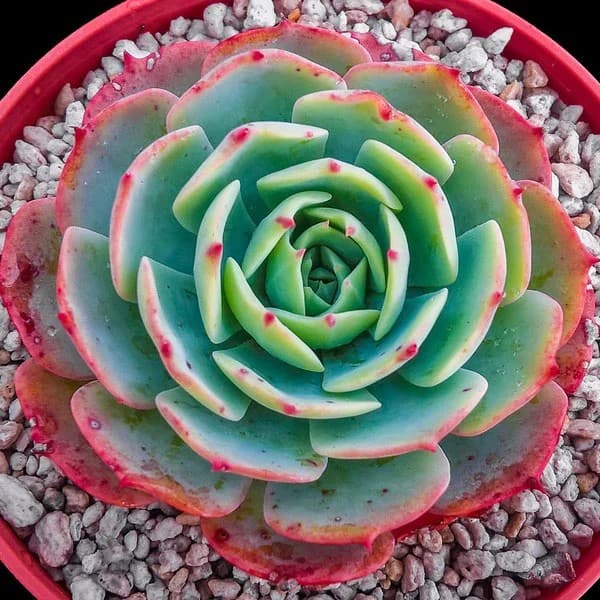
Echeveria secunda is a succulent that forms attractive clumps, up to 6 inches (15 cm) tall, of short-stemmed, tight rosettes up to 6 inches (15 cm) in diameter. The leaves are fleshy, oval-shaped, keeled, pale bluish-green, with edges and tips adorned with a hint of pink, red or brown, more conspicuous in winter.
In the summer, it sends up 1ft. tall (30 cm) arching stems which bear fairly large, lantern-shaped flowers with red calyces and yellow petals, giving them a bi-colored look.
Echeveria semivestita
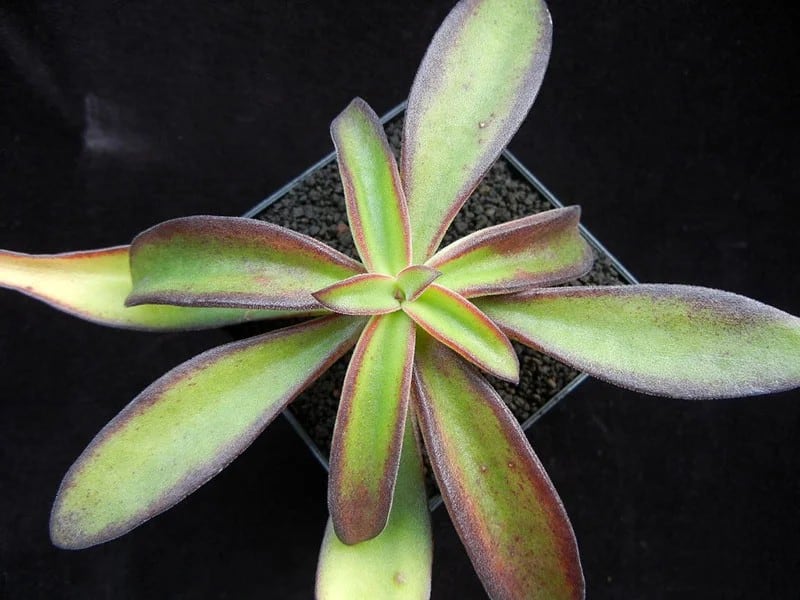
Echeveria semivestita (also known as Blue Echeveria) is an open rosette of narrow 4 inch long bright green leaves that are concave, strong, dark with a reddish-purple margin on both upper and lower sides. the stems are short and sometimes branch.
The flower of the Blue Echeveria forms below the center of the rosette and rises 10 to 12 inches, adorned with about 9 the buds of which are an unusual bluish violet also described as slate blue.
Echeveria sessiliflora
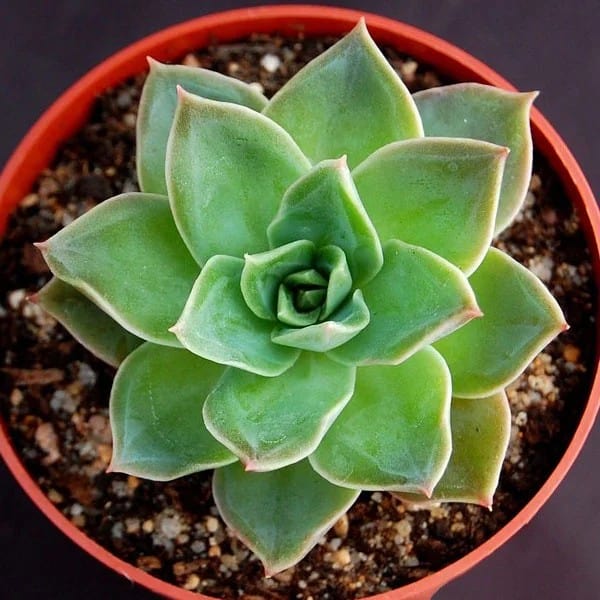
Echeveria sessiliflora is a stemless succulent, forming dense rosettes of bright-green leaves with a red-tinged margin. Its flowers are scarlet at base and grenadine above, sitting at the ends of 30 cm long flowering stalks.
Echeveria setosa
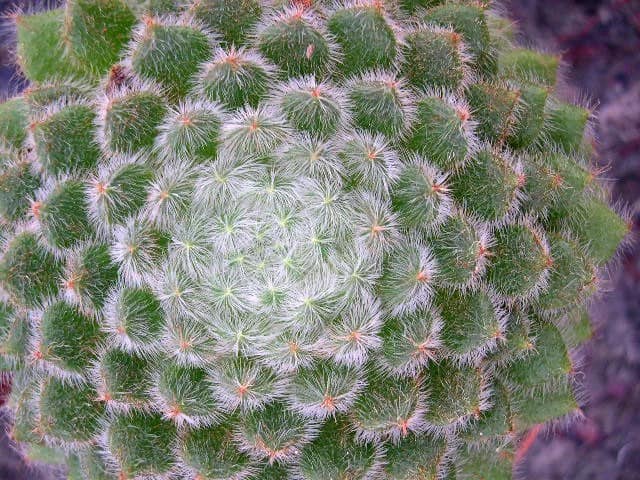
Echeveria setosa (also known as Mexican Firecracker) is an evergreen succulent with numerous offsets in older plants. It has almost stemless rosettes, up to 6 inches (15 cm) in diameter, of fleshy, green, spoon-shaped leaves, up to 2.8 inches (7 cm) long and up to 0.8 inches (2 cm) wide, covered with dance white hairs.
The flowers are orange-red with yellow tips and appear on up to 12 inches (30 cm) long stalks.
Echeveria shaviana
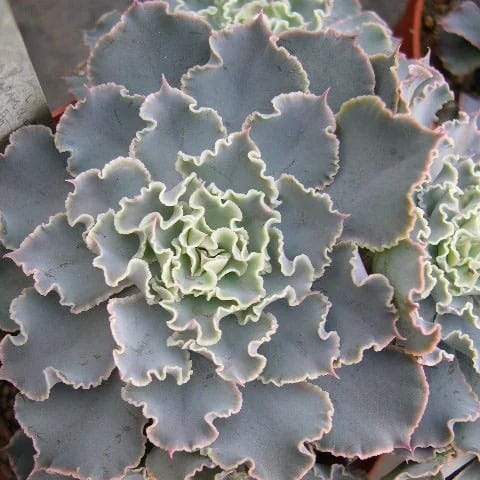
Echeveria shaviana (also known as Mexican Hens) is an evergreen succulent with short-stemmed rosettes, up to 8 in. wide (20 cm), packed with fifty or more, fleshy, smooth, very wavy crinkled, blue-gray leaves. Thin and delicate, the frilly leaves take on a pink blush in strong light.
In summer, it sends up 1ft. tall (30 cm) stems which bear flowers arranged to one side of the stalk, pink outside and yellow inside.
Echeveria skinneri
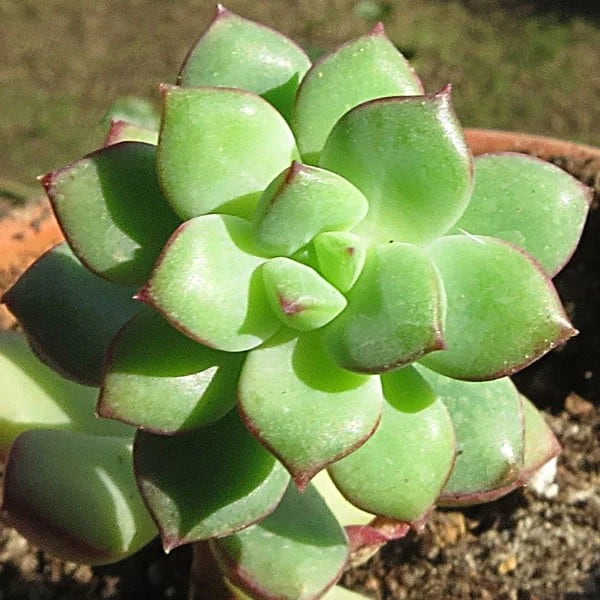
Echeveria skinneri is a stemming succulent that reaches up to 23 cm tall with rosettes up to 3.5 – 4.5 cm wide. The leaves are rounded, green and purplish towards the apex and the margins rounded with a faint obtuse line near the dorsal surface. The flowers are dark red, yellow within and produced on up to 23 cm long stalks.
Echeveria spectabilis
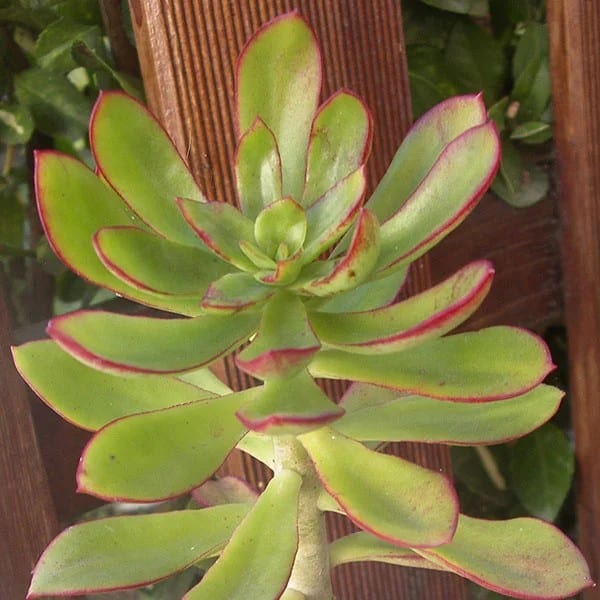
Echeveria spectabilis is a branching succulent that grows up to 60cm tall, with rosettes up to 15 cm in diameter and green, red-margined leaves. The flowers are scarlet to orange, yellow-margined and produced on up to 70 cm long stalks.
Echeveria ‘Starlite’
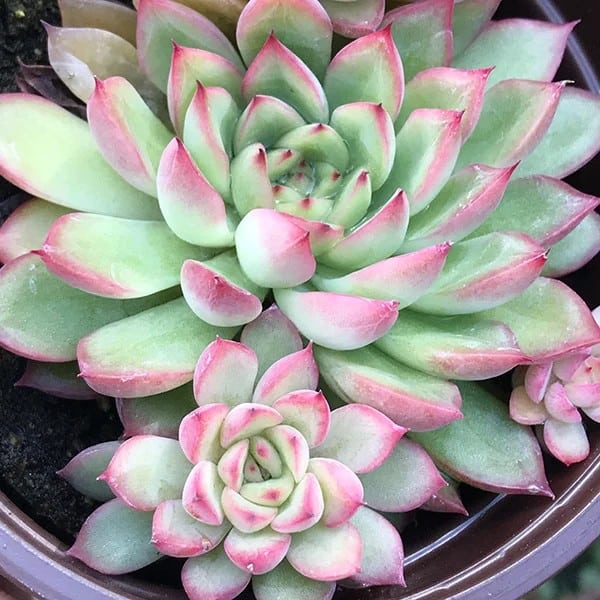
Echeveria ‘Starlite’ is a smaller rosette that grows offshoots quickly, forming clusters of rosettes. Its bright green leaves will flush pink to red at the tips. Hummingbirds love the orange flowers filled with nectar.
Echeveria strictiflora
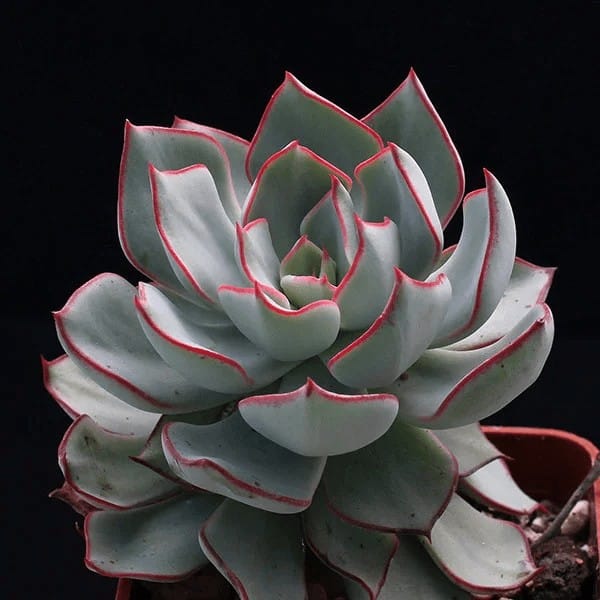
Echeveria strictiflora (also known as the Desert Savior) is a glaucous, pale blue rosette with wavy foliage. This species comes from Mexico and Texas and is the only Echeveria native to the United States. Some plants can show a fine red outline at their leaf margins.
This variety can be a finicky grower and is easily blemished. It does not tolerate humid climates well.
Echeveria subalpina
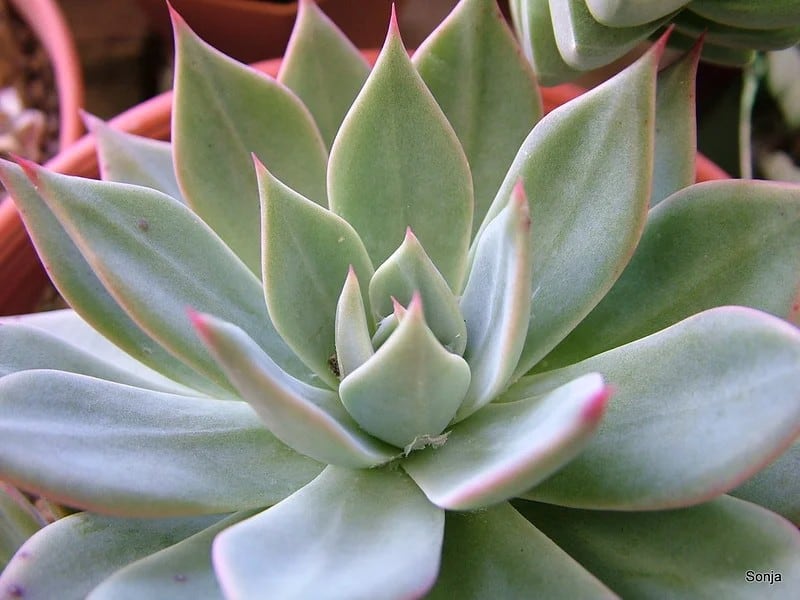
Echeveria subalpina is a lovely species of slender, pointed leaves that tend to stand upright. The rosette is a soft blue color and can get a slight pink blush to the leaf tips when grown in bright sun. The leaves are coated with a powdery, natural wax that protects the plant in full sun and gives it a frosty look.
It produces a tall, hooked bloom stalk with pink and yellow, bell-shaped flowers.
Echeveria subcorymbosa
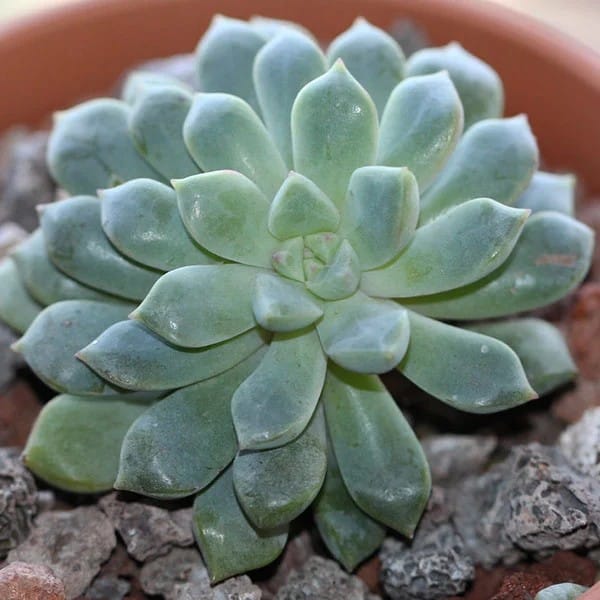
Echeveria subcorymbosa is a glabrous, short-stemmed succulent with bluish-grey leaves forming rosettes up to 4 – 6 cm in diameter. It produces up to 11 cm long erect bloom stalks with reddish-orange and yellow, bell-shaped flowers.
Echeveria subrigida
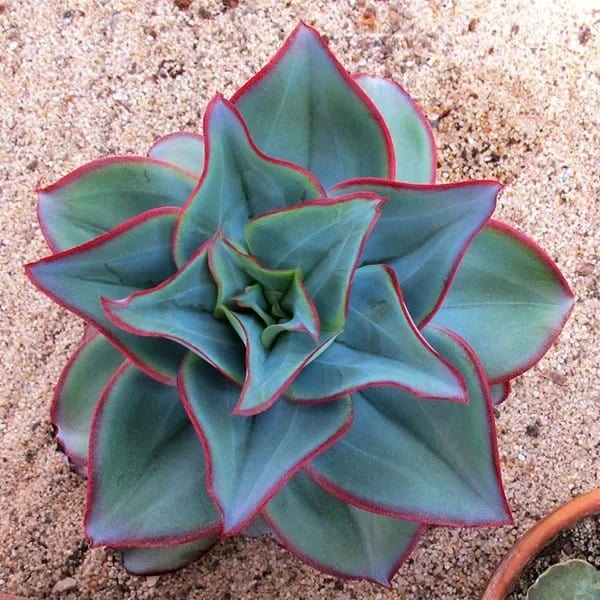
Echeveria subrigida is a beautiful succulent plant with rosettes, 18 inches (45 cm) in diameter, of fleshy, spade-shaped leaves. The leaves are blue-green and highlighted with a thin pink or rose border.
In late spring into mid-summer, up to 12 inches (30 cm), tall spikes rise from the center of each rosette, producing cymes of milky-blue buds that gradually age to tubular, coral-pink flowers. Orange tones inside add to the charm of these up to 1 inch (2.5 cm) long blooms.
Echeveria subsessilis ‘Morning Beauty’
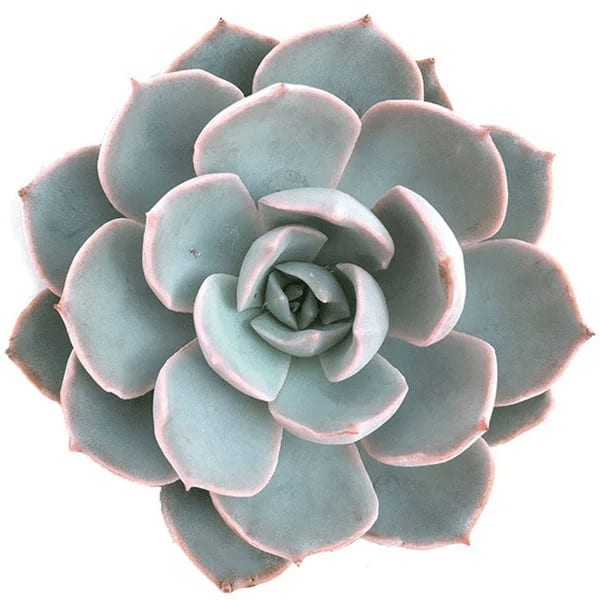
Echeveria subsessilis ‘Morning Beauty’ is a lovely grey-blue rosette with slight touches of pink on its leaf margins. This is a naturally occurring form from Mexico with a similar look to Echeveria peacockii. A thick coating of farina helps the rosette tolerate full sun while also giving it a soft, powdery look.
Echeveria tencho
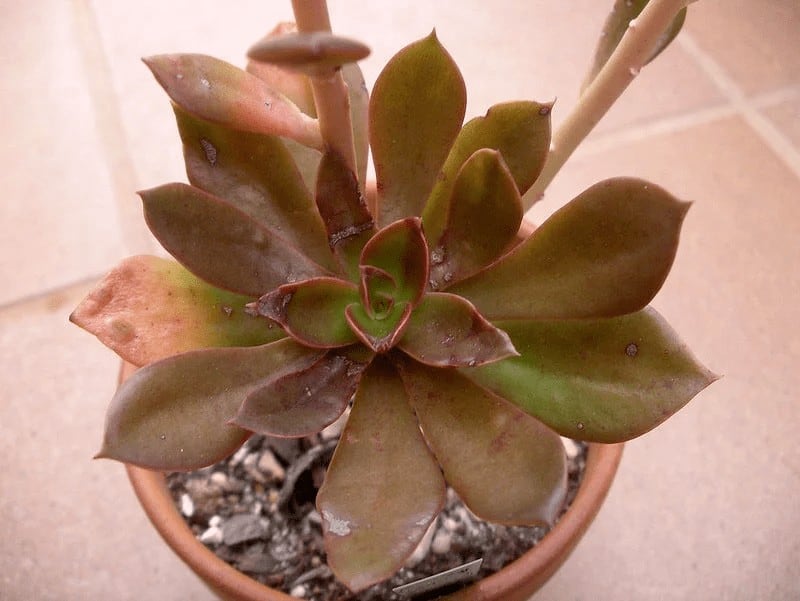
Echeveria tencho is a wonderful species from Mexico. In high light levels, they produce these vibrantly bright orange leaves with striking lime green centers. The flowers are light yellow and somewhat tinged with rose, produced on up to 50 cm tall thick bloom stalks.
Echeveria Tippy
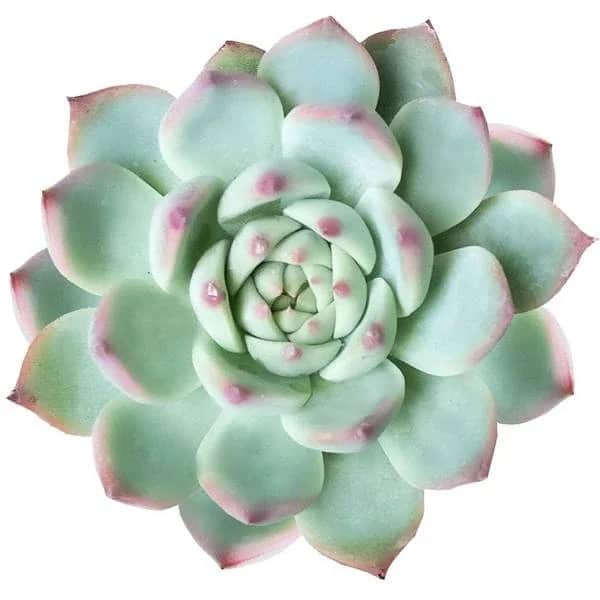
Echeveria ‘Tippy’ is an evergreen succulent forming a very pretty rosette, 6 in. across (15 cm), packed with fleshy, pale blue-green leaves adorned with prominent rose pointy tips. Its orange bell-shaped flowers are prized by hummingbirds.
Echeveria tobarensis
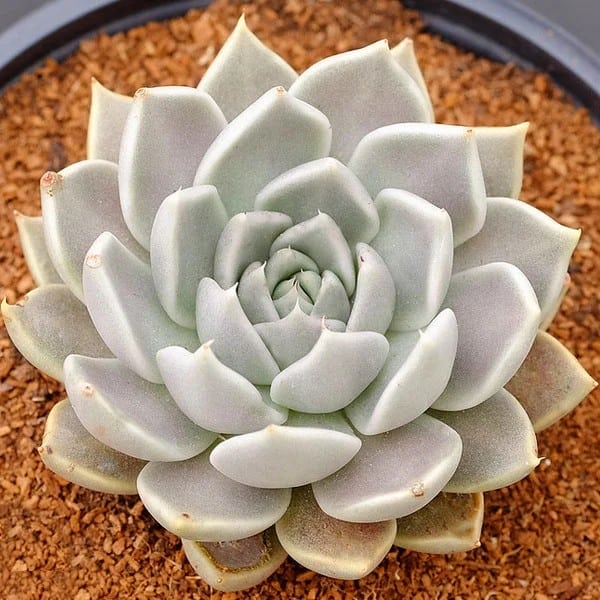
Echeveria tobarensis is a very rare succulent with greyish-purple leaves clustered in a dense rosette of up to 12 cm in diameter. The flowers are small, pink, and produced on up to 30 cm long inflorescence.
Echeveria tolimanensis
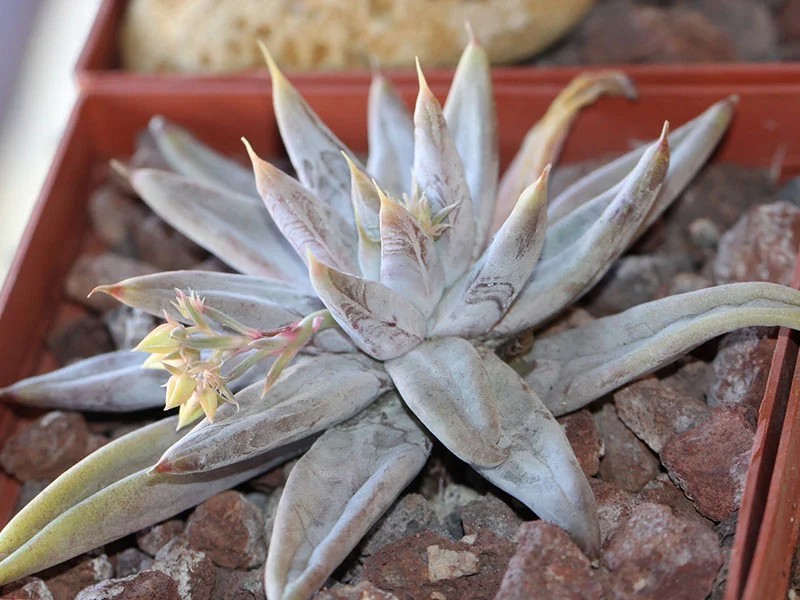
Echeveria tolimanensis is a very dark-colored variety. Its thick, fleshy leaves are a deep blue/purple color. This variety is unique in its shrub shape with lots of stems rather than a single rosette. It offsets freely and can grow quite tall while maintaining full leaf coverage on its stem.
This variety grows a tall bloom stalk each summer from which hang numerous orange to yellow bell-shaped flowers. It has a high success rate for propagation from both offsets, leaves, and stem cuttings.
Echeveria tolucensis
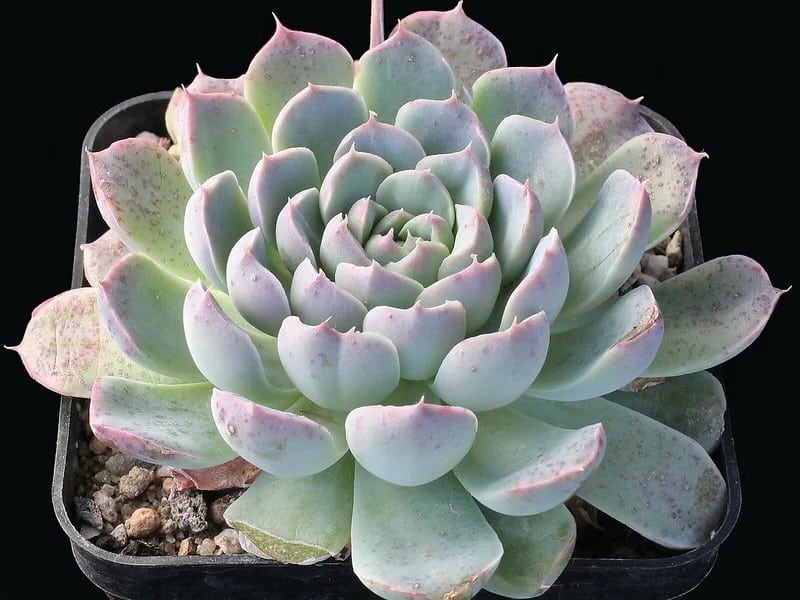
Echeveria tolucensis is a beautiful species from Mexico. It features lovely light-blue/green leaves on a tight rosette and offsets very regularly.
Echeveria trianthina
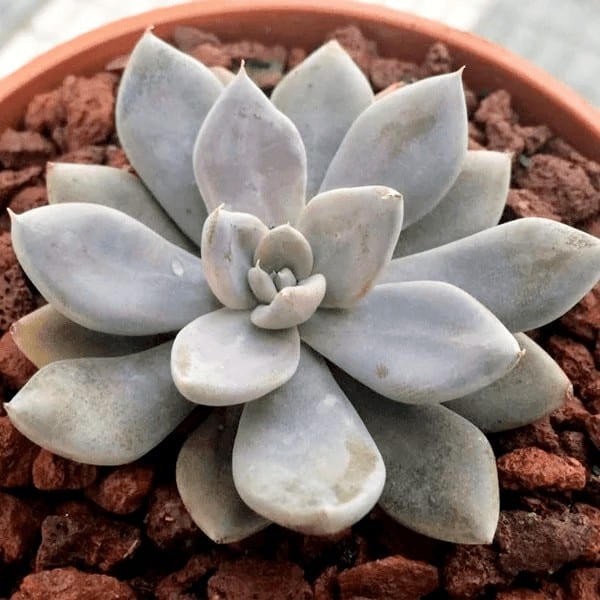
Echeveria trianthina is a stemless, rosette-forming succulent that offsets very freely. It has numerous thick, deep purple basal leaves that turn greenish as it matures. Pink flowers are produced on 30 – 40 cm long stalks.
Echeveria uhlii
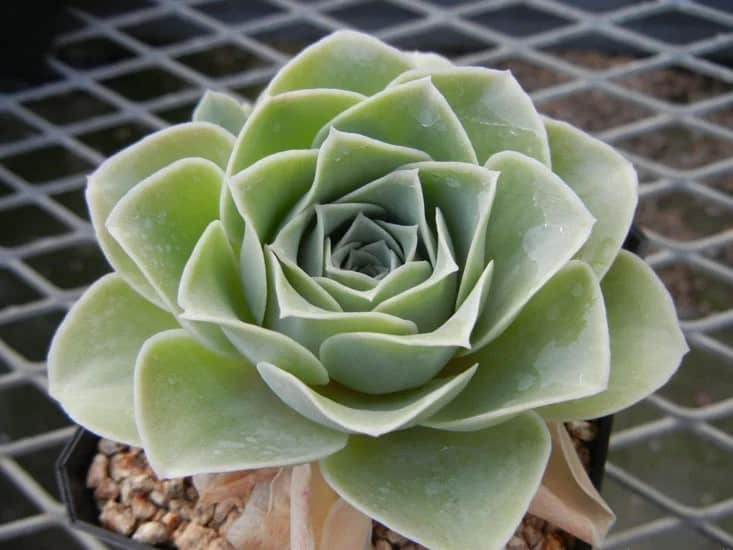
Echeveria uhlii is a short-stemmed succulent that is conspicuously covered with dry leaves. Its green and slightly pruinose leaves form rosettes that are 4 – 6 cm in diameter. The flowers are reddish yellow, hanging slightly thick bloom stalks.
Echeveria unguiculata
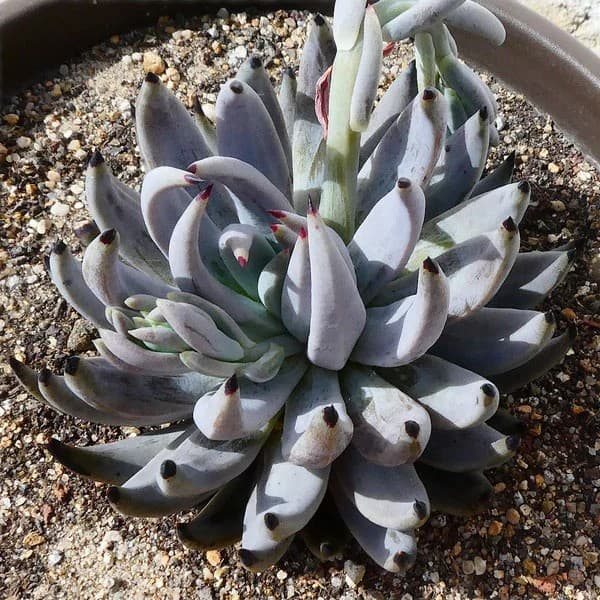
Echeveria unguiculata is a small, rosette-forming succulent plant up to 4 inches (10 cm) in diameter. The leaves are curved, lanceolate, narrow, up to 2 inches (5 cm) long and 0.4 inches (1 cm) wide, gray with violet shading and a small red or black tip. The stem is up to 2 inches (5 cm) long.
Flowers are pink to orange (outside) and orange (inside) on a up to 20 inches (50 cm) long stem.
Echeveria utcubambensis
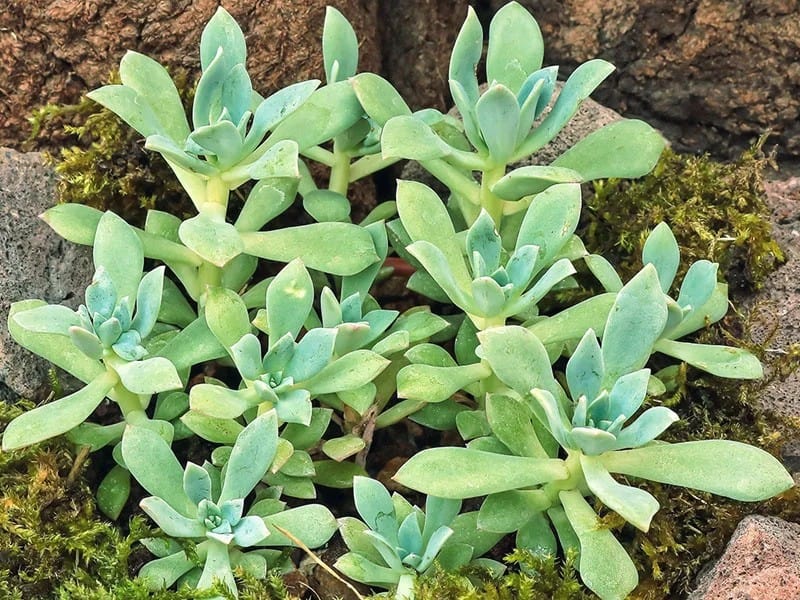
Echeveria utcubambensis is a long-stemmed succulent with leaves that are bluish-green, slightly glaucous and margins that reddened in bright light, forming rosettes up to 5 – 7 cm wide. The bell-shaped flowers are striped with broad bands of orange and yellow, hanging from a 16cm unbranched flowering stem.
Echeveria ‘Violet Queen’
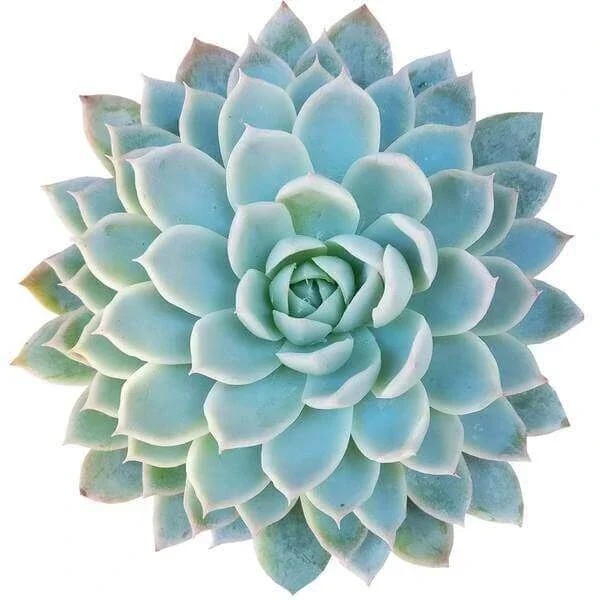
Echeveria Violet Queen is a fast-growing, rosette-forming succulent that freely offsets to form a dense mound up to 5 inches (12.5 cm) tall. The rosettes are up to 6 inches (15 cm) in diameter. The leaves are long, narrow and curve up slightly towards the tips to form an open lotus blossom shape.
They are silver-green with hits of pink on leaf edges and tips when moderately stressed by the bright sun or cool temperatures. This variety produces lots of offsets and, if given space, can develop into a 1.0′ clump of 20+ rosettes.
Echeveria walpoleana
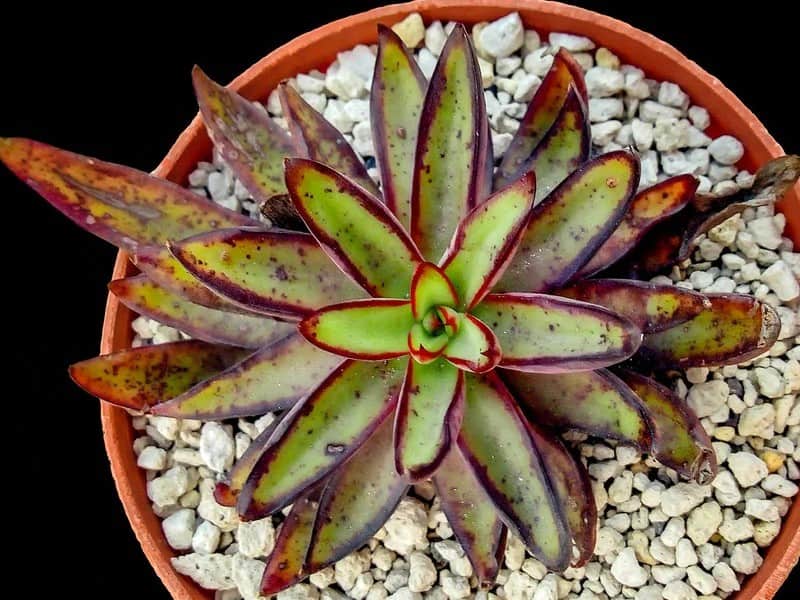
Echeveria walpoleana is a stemless to short-stemmed succulent with dense rosettes of pale green leaves with reddish margins that become deeply tinged with red throughout with age. The flowers are deeply orange-colored, angular, and hang from 30 – 40 cm long flowering stems.
Echeveria xichuensis
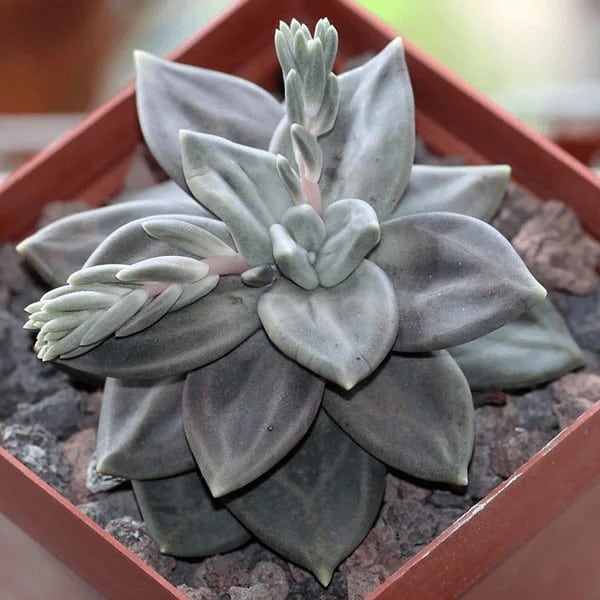
Echeveria xichuensis is native to Mexico in the state of Guantanamera, where it can be found almost camouflaged and clinging to rock crevices away from grazing animals. It produces marble-like patterns that run through every leaf, and its metallic grey coloring makes it truly stand out.
Echeveria ‘Yamatoren’
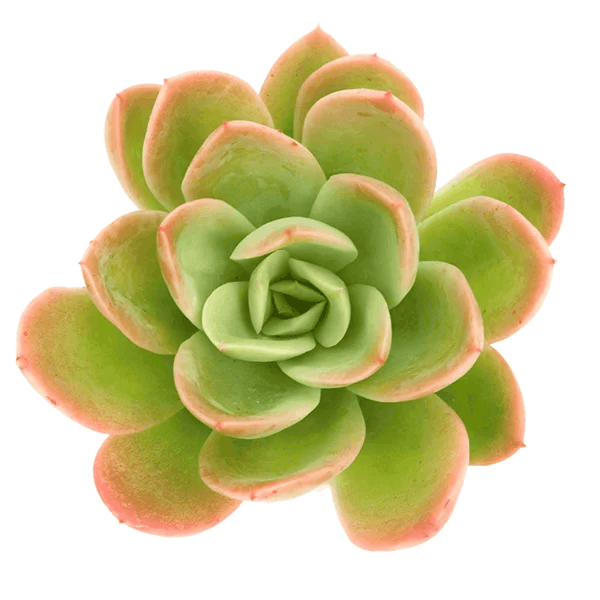
Echeveria ‘Yamatoren’ succulents are bright green with pinkish-red margins when exposed to a lot of bright light. Their fleshy leaves form cute little rosettes that have the best contrasting colors making them perfect additions to any garden or planter. It produces bell-shaped, bright yellow flowers.
Echeveria Zorro
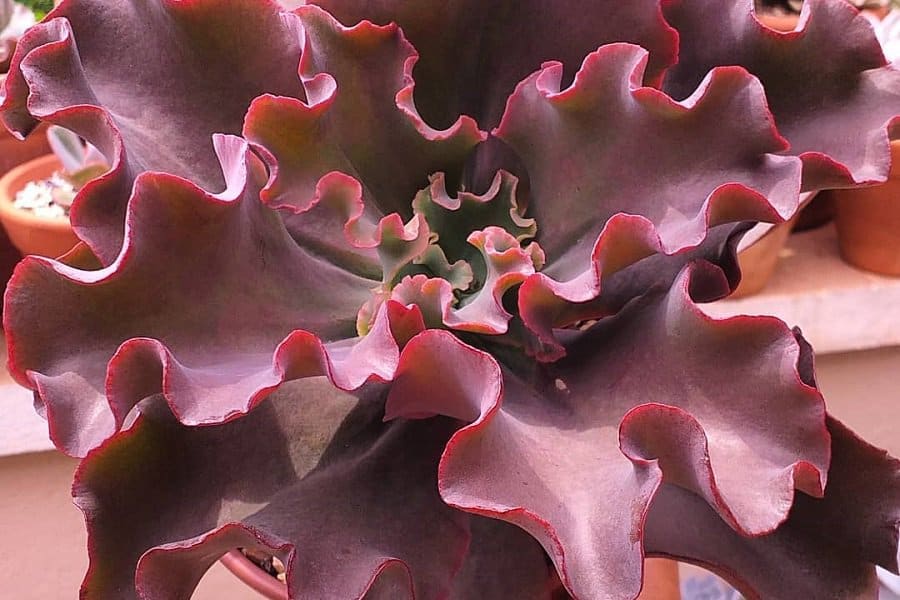
Echeveria Zorro was created by Dick Wright as a hybrid in the year 1998. The rosettes are packed with leaves that have frilly margins.
These frilly margins open up very large while growing and have a tinge of pink at the edges. The rosette can grow up to a diameter of 16 inches. The color of the leaves varies with different seasons.
Read also:
Echeveria vs Graptoveria — 5 Key Differences
Echeveria vs Pachyphytum: 3 Interesting Differences and Similarities
How To Care For Echeveria
Light
Because Echeverias originate in tropical countries, they require a substantial amount of light in order to thrive. They should receive at least four to five hours of bright, direct light on a daily basis. Placing your Echeveria outdoors during the summer months will help it to thrive.
Echeverias that do not receive enough light will become elongated and leggy, often ‘reaching’ towards the closest source of light. It is also unlikely that they will flower. If you have your echeveria on a windowsill, turn the plant occasionally to ensure that all sides of your plant get enough sun.
On the other hand, too many hours of intense, direct sunlight can result in sunburn.
Water
Echeveria varieties, like most succulents, do not require much water as they store water in their fleshy leaves. Wait until the soil has dried out completely before watering your Echeveria, and then give it a good watering, making sure the excess water drains out from the pot.
If you water too much or too little, your Echeveria will start to wilt, wrinkle, or drop leaves. However, it is better to err on the side of under-watering, as they can quickly succumb to root rot if overwatered. With that in mind, Echeverias should never be kept in damp soil.
When watering Echeverias, always water the soil directly and avoid allowing water to sit on the rosette of the succulent as this can lead to rot and fungal disease.
During the spring and summer, Echeverias will need to be watered more frequently than they will in the winter.
Soil
Echeveria varieties require a well-draining, porous growing medium to help keep excess moisture away from the roots. Standard soil for cactus potting is sufficient for Echeverias, which can be found at most nurseries and garden centers.
If growing in containers, make sure there are drainage holes in the bottom to allow water to drain from the soil. Soil that is constantly damp or doesn’t drain well will result in Echeveria root rot.
Climate
Echeveria types thrive in hot, dry conditions. For the most part, they do not tolerate cold temperatures or cold drafts well and too much humidity can lead to root rot. Echeverias grow well indoors in average room conditions with around 40% – 50% humidity.
During the spring and summer months, your indoor Echeverias need temperatures of between 65 and 80°F (18 – 27°C). During the winter, a few degrees lower will be ideal. Outdoors, Echeverias love warm summers of at least 19°C or 20°C.
Fertilizing
Generally, fertilizing is not a requirement for Echeveria types as they are accustomed to growing in nutrient-poor soil, which makes them susceptible to fertilizer burn if over-fertilized.
However, if you want to encourage healthy Echeveria growth, you can use a cactus or succulent fertilizer or low-nitrogen mix that has been diluted 3 or 4 times more than the recommended dose.
Only feed a small amount every 2 or 3 weeks during the spring and summer months which is their active growing period.
Potting and Repotting
When choosing a pot or container to grow an Echeveria in, it is important to choose the right size. As a rule of thumb for all succulents, choose a pot that is slightly larger than the root ball. This helps to ensure the soil doesn’t stay too damp.
Echeveria types do not require frequent repotting and should only be repotted once they have outgrown their previous container. To repot an Echeveria plant, ensure that the soil is completely dry before removing it from its potting container. Repotting in the spring is usually recommended as the plant will be entering into its active growing period.
Propagating Echeveria
Echeveria propagates mainly through offsets, leaf cuttings and seeds. A mature Echeveria plant will produce offsets from its main stem, which can be separated and propagated as a separate plant. Alternatively, Echeverias can be propagated through leaf cuttings.
If the Echeveria has already formed several rosettes, it is particularly easy to propagate. All you have to do is cut off the rosettes. The offshoots should be at least two centimeters in diameter.
The best time to cut off the rosettes is May. Pluck apart the individual rosettes, then plant them separately.
How Big Do Echeveria Grow?
The size of an Echeveria depends on the species. The largest Echeveria can grow up to 50 centimeters in diameter.
Sources:
www.llifle.com
worldofsucculents.com
mountaincrestgardens.com
leafandclay.co
www.crassulaceae.ch
www.gardentags.com
www.succulents.us
www.rareplant.me
www.gardenia.net

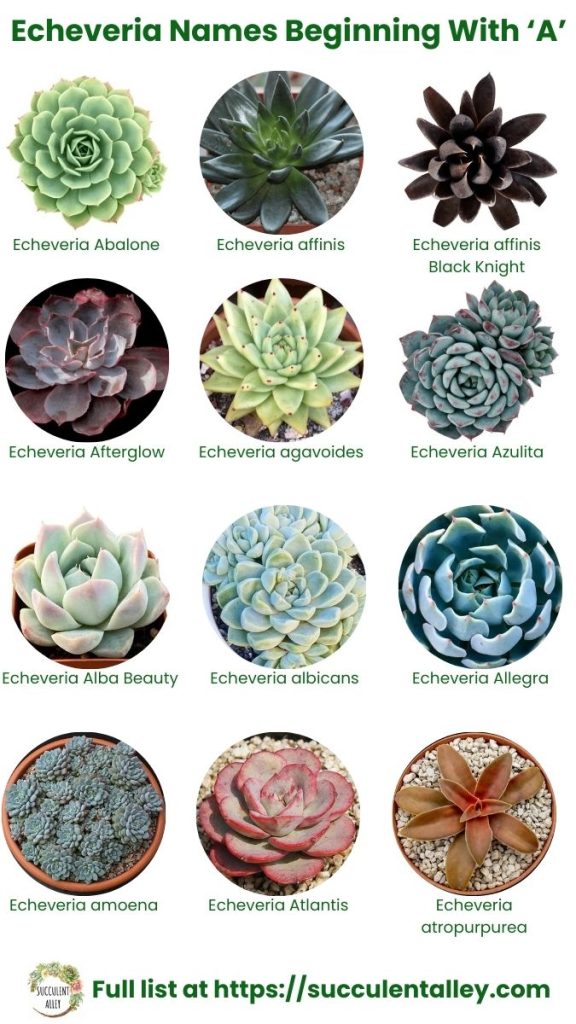
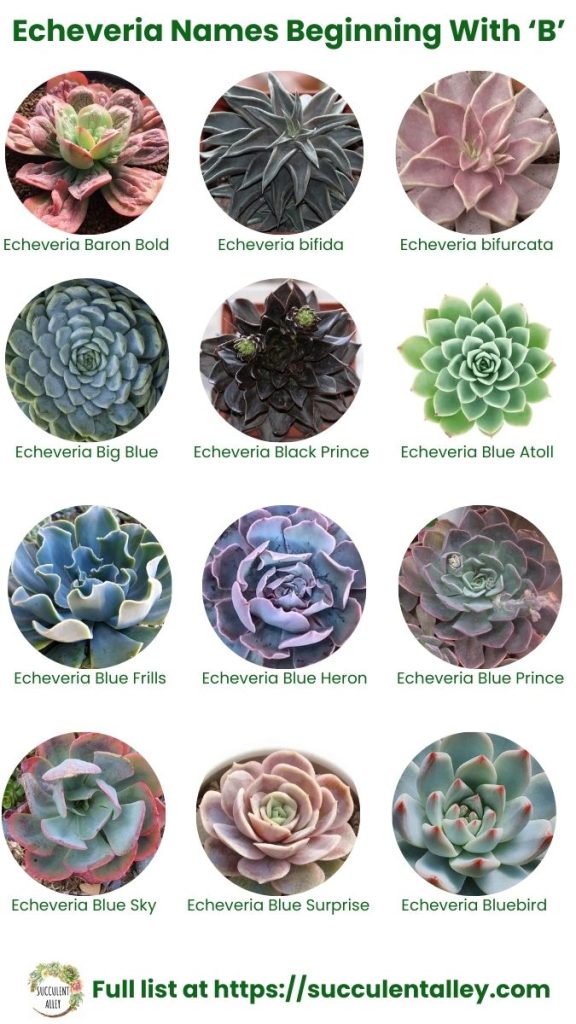
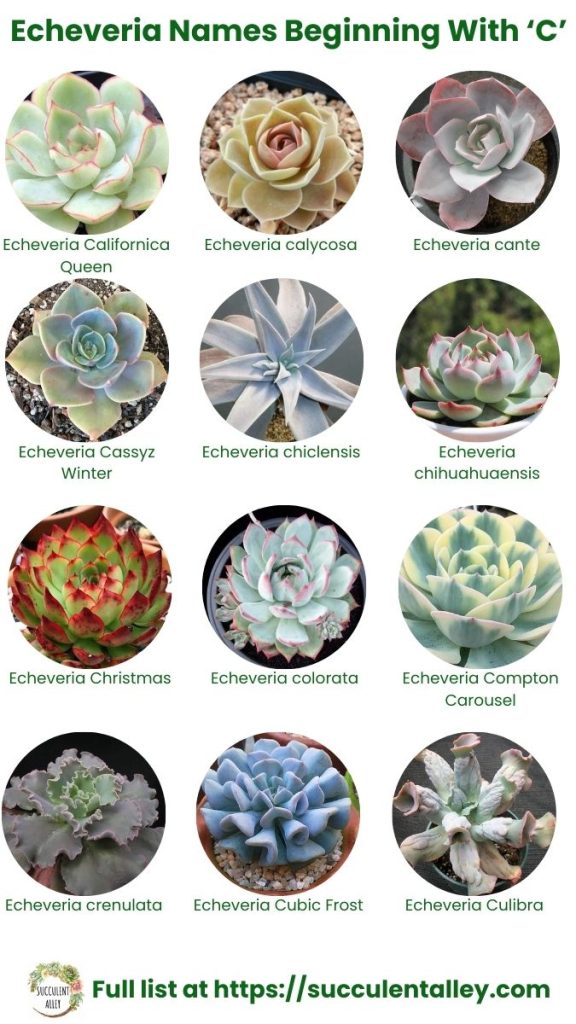
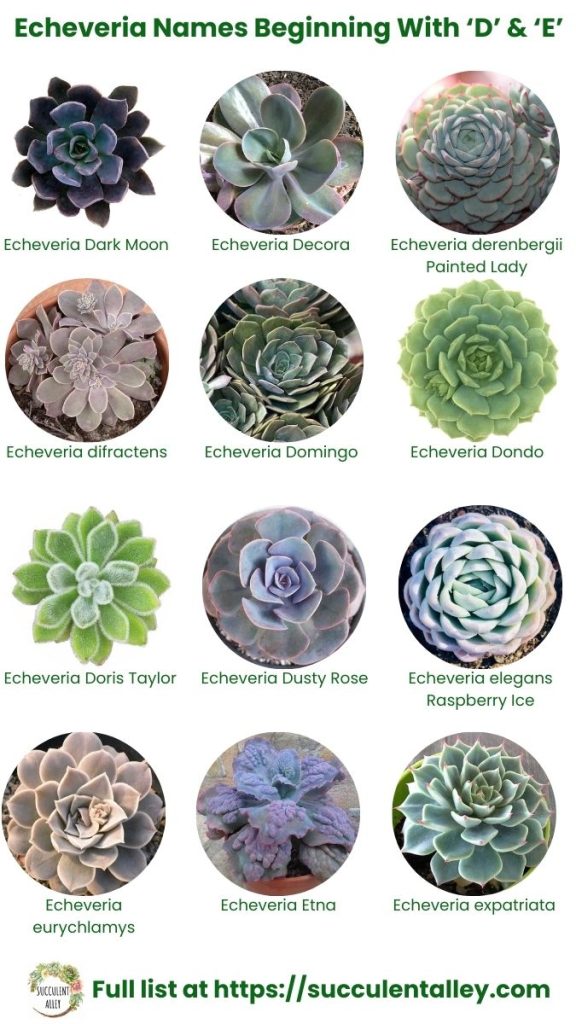
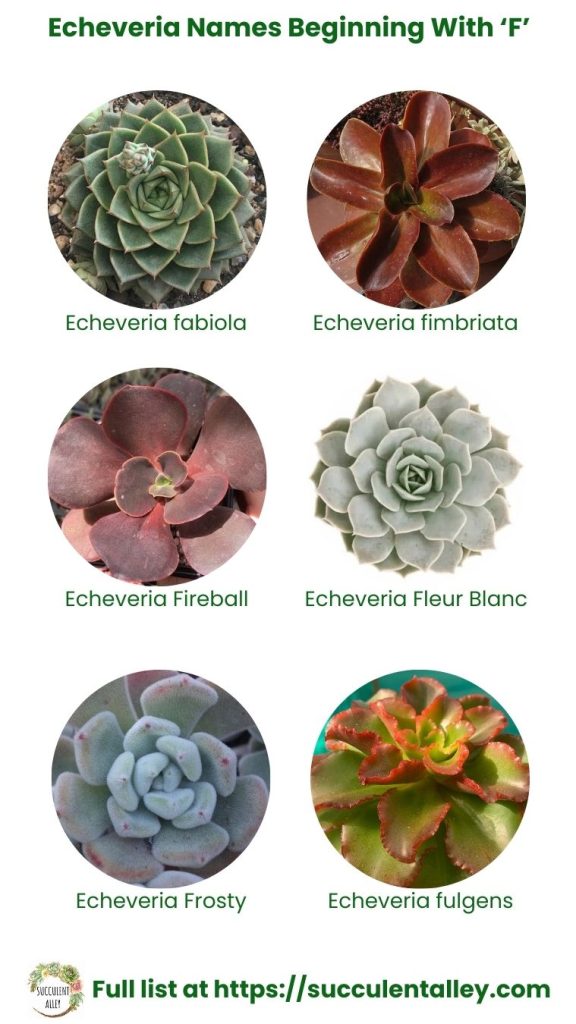
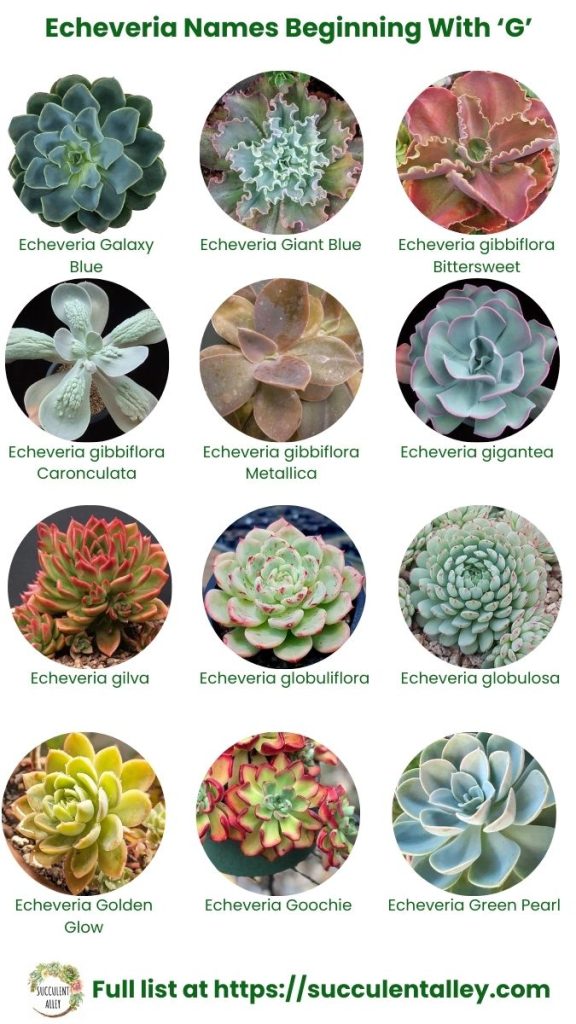
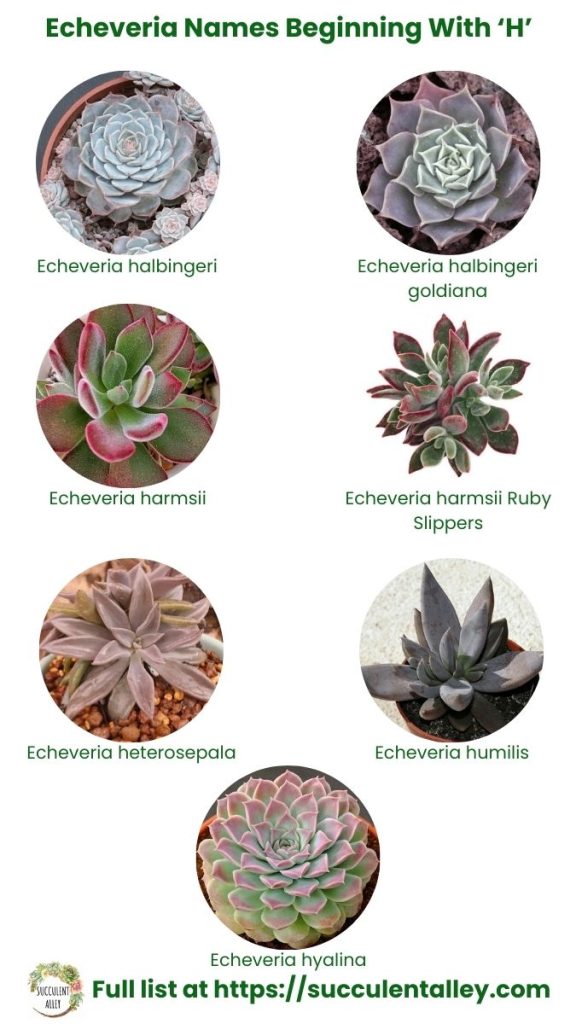
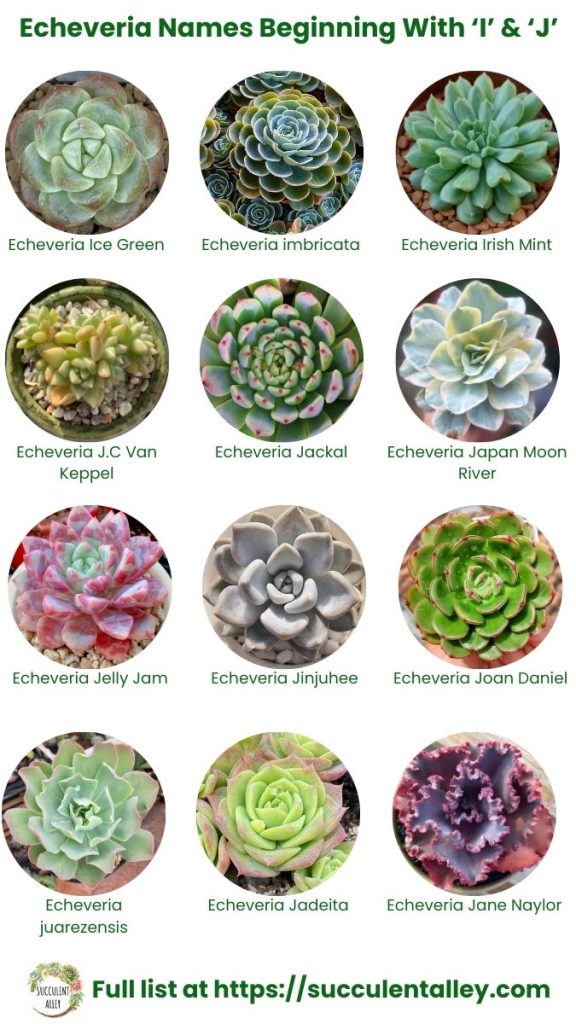
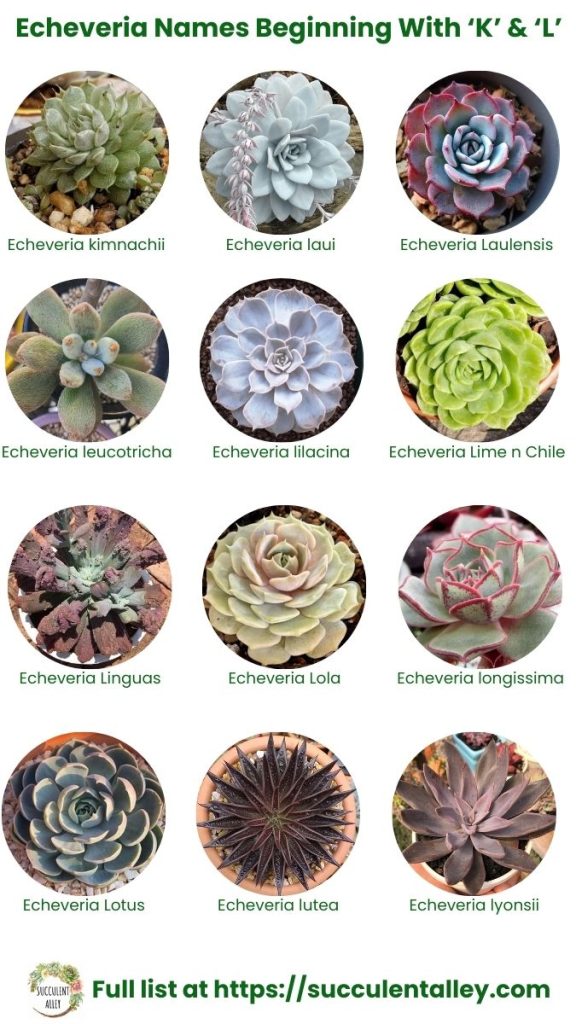
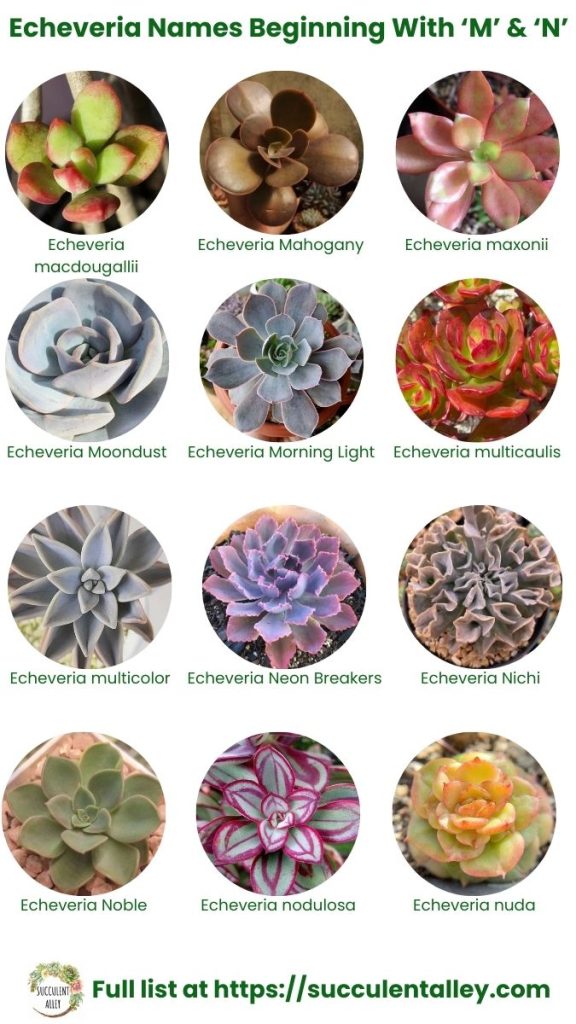
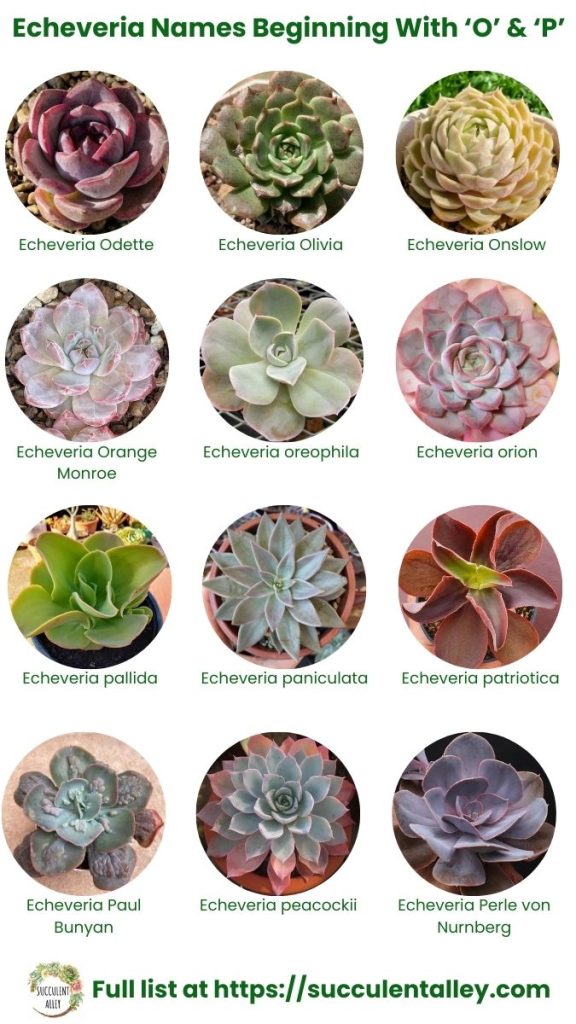
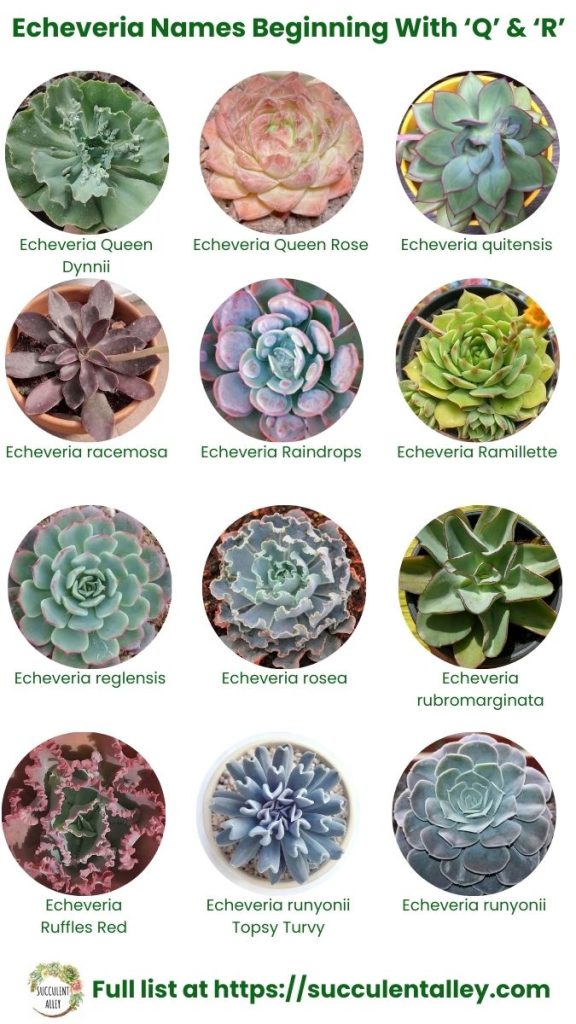
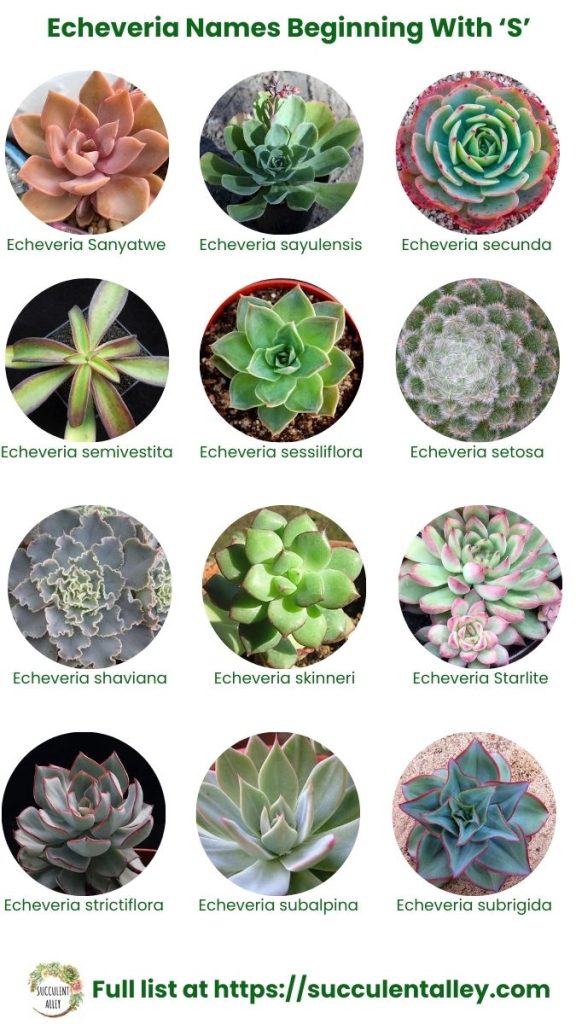
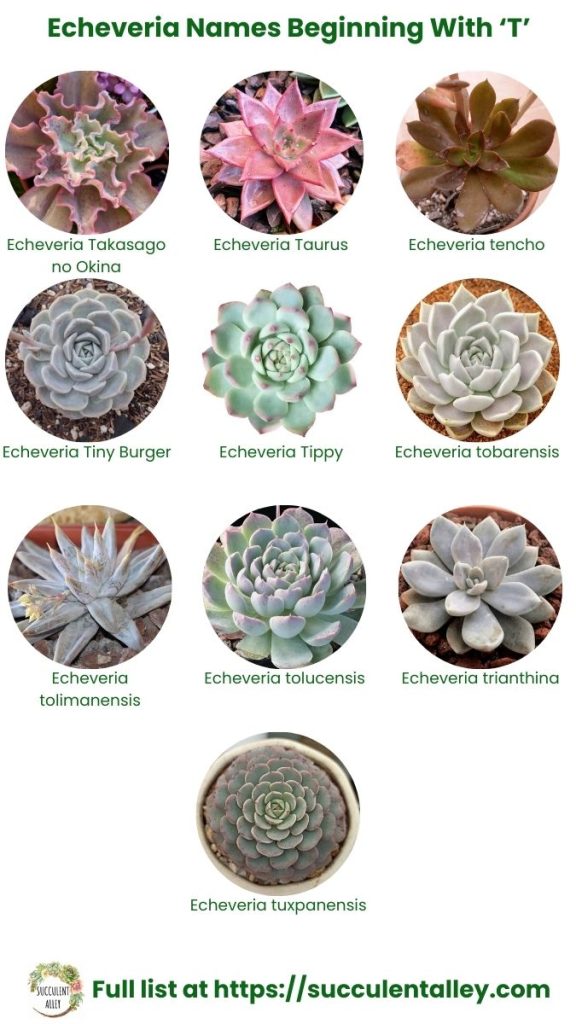
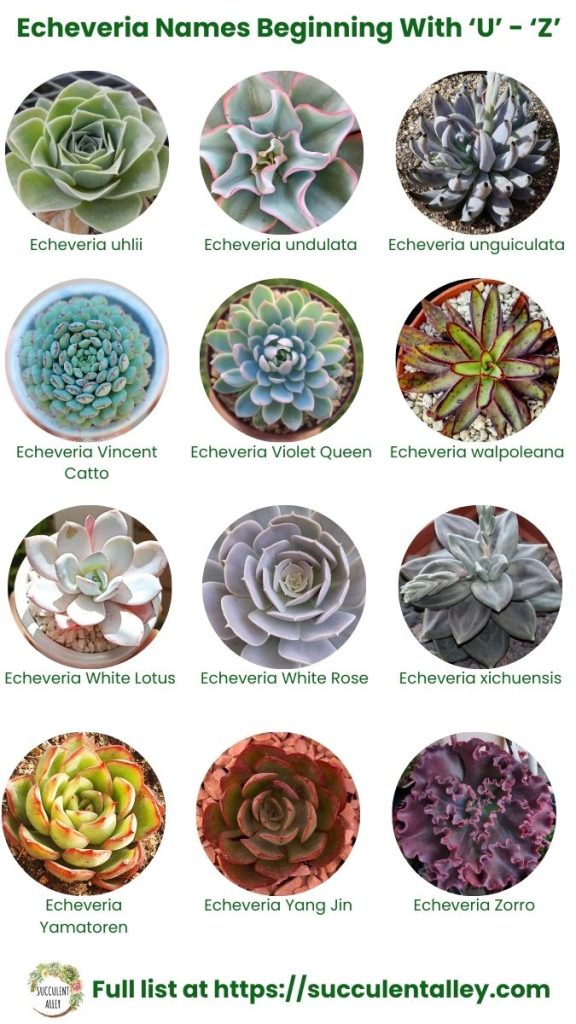
I want a succulent that doesn’t have a stem because I think they look prettier. You said that echeveria hyaline is stemless and that it blooms in January and February. Both those months are coming up soon so I bet I can get some in time.